UNITED STATES
SECURITIES AND EXCHANGE COMMISSION
Washington, D.C. 20549
FORM 6-K
REPORT OF FOREIGN ISSUER
PURSUANT TO RULE 13a-16 OR 15d-16
OF THE SECURITIES EXCHANGE ACT OF 1934
For the Month of February 2024
(Commission File No. 001-41636)
Oculis Holding AG
(Translation of registrant’s name into English)
Bahnhofstrasse 7
CH-6300
Zug, Switzerland
(Address of registrant’s principal executive office)
Indicate by check mark whether the registrant files or will file annual reports under cover of Form 20-F or Form 40-F.
Form 20-F ☒ Form 40-F ☐
INFORMATION CONTAINED IN THIS REPORT ON FORM 6-K
On February 28, 2024, Oculis Holding AG (the “Registrant”) held an R&D Day and issued a press release regarding updates on its clinical programs and announcing key leadership appointments. The Registrant gave a presentation at the R&D Day showcasing two of Oculis’ clinical programs: OCS-01 in Diabetic Macular Edema (DME) and OCS-02 in Dry Eye Disease (DED). In addition, Oculis’ management provided a brief 2023 business review and outlook for 2024 and announced key leadership appointments. The presentation and the press release are attached hereto as Exhibit 99.1 and Exhibit 99.2 and are incorporated by reference herein.
The information contained in this Form 6-K, including Exhibit 99.2, but excluding Exhibit 99.1, is hereby incorporated by reference into the Registrant’s Registration Statement on Form S-8 (File No. 333-271938).
EXHIBIT INDEX
| Exhibit | Description |
|
| 99.1 | Presentation dated February 28, 2024 | |
| 99.2 | Press Release dated February 28, 2024 | |
SIGNATURES
Pursuant to the requirements of the Securities Exchange Act of 1934, the registrant has duly caused this report to be signed on its behalf by the undersigned, thereunto duly authorized.
| OCULIS HOLDING AG | ||||||
| Date: February 28, 2024 | By: | /s/ Sylvia Cheung |
||||
| Sylvia Cheung Chief Financial Officer |
||||||

Exhibit 99.1 R&D Day February 28, 2024
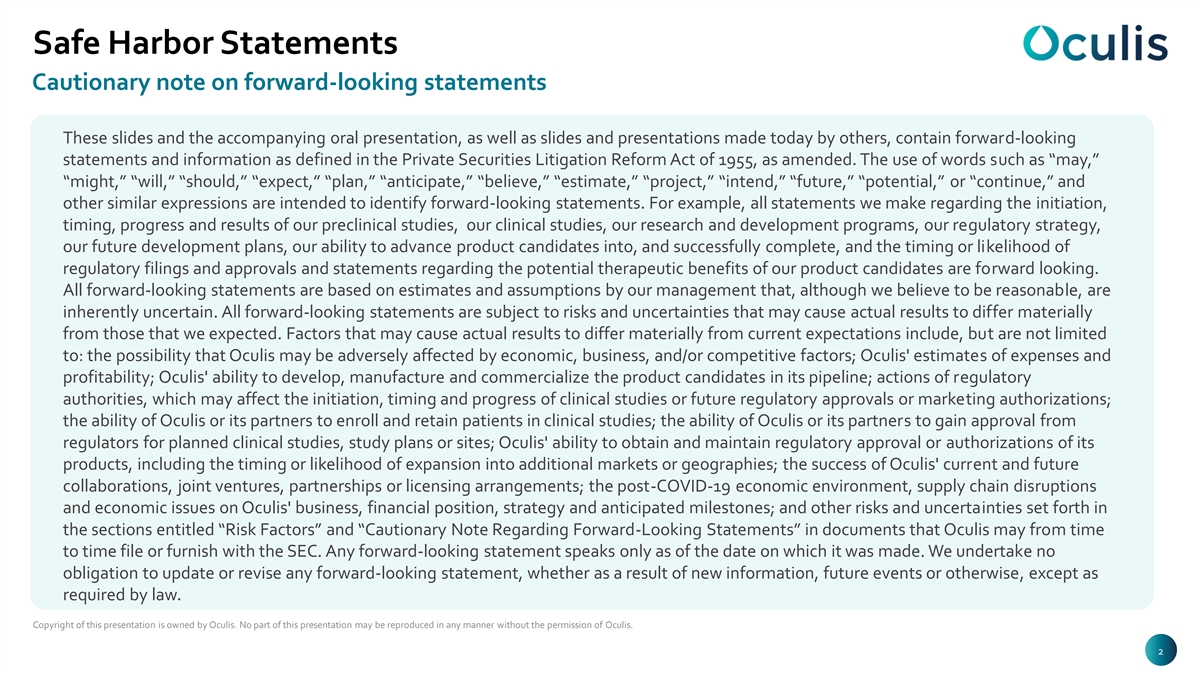
Safe Harbor Statements Cautionary note on forward-looking statements These slides and the accompanying oral presentation, as well as slides and presentations made today by others, contain forward-looking statements and information as defined in the Private Securities Litigation Reform Act of 1955, as amended. The use of words such as “may,” “might,” “will,” “should,” “expect,” “plan,” “anticipate,” “believe,” “estimate,” “project,” “intend,” “future,” “potential,” or “continue,” and other similar expressions are intended to identify forward-looking statements. For example, all statements we make regarding the initiation, timing, progress and results of our preclinical studies, our clinical studies, our research and development programs, our regulatory strategy, our future development plans, our ability to advance product candidates into, and successfully complete, and the timing or likelihood of regulatory filings and approvals and statements regarding the potential therapeutic benefits of our product candidates are forward looking. All forward-looking statements are based on estimates and assumptions by our management that, although we believe to be reasonable, are inherently uncertain. All forward-looking statements are subject to risks and uncertainties that may cause actual results to differ materially from those that we expected. Factors that may cause actual results to differ materially from current expectations include, but are not limited to: the possibility that Oculis may be adversely affected by economic, business, and/or competitive factors; Oculis' estimates of expenses and profitability; Oculis' ability to develop, manufacture and commercialize the product candidates in its pipeline; actions of regulatory authorities, which may affect the initiation, timing and progress of clinical studies or future regulatory approvals or marketing authorizations; the ability of Oculis or its partners to enroll and retain patients in clinical studies; the ability of Oculis or its partners to gain approval from regulators for planned clinical studies, study plans or sites; Oculis' ability to obtain and maintain regulatory approval or authorizations of its products, including the timing or likelihood of expansion into additional markets or geographies; the success of Oculis' current and future collaborations, joint ventures, partnerships or licensing arrangements; the post-COVID-19 economic environment, supply chain disruptions and economic issues on Oculis' business, financial position, strategy and anticipated milestones; and other risks and uncertainties set forth in the sections entitled “Risk Factors” and “Cautionary Note Regarding Forward-Looking Statements” in documents that Oculis may from time to time file or furnish with the SEC. Any forward-looking statement speaks only as of the date on which it was made. We undertake no obligation to update or revise any forward-looking statement, whether as a result of new information, future events or otherwise, except as required by law. Copyright of this presentation is owned by Oculis. No part of this presentation may be reproduced in any manner without the permission of Oculis. 2 2 2 2
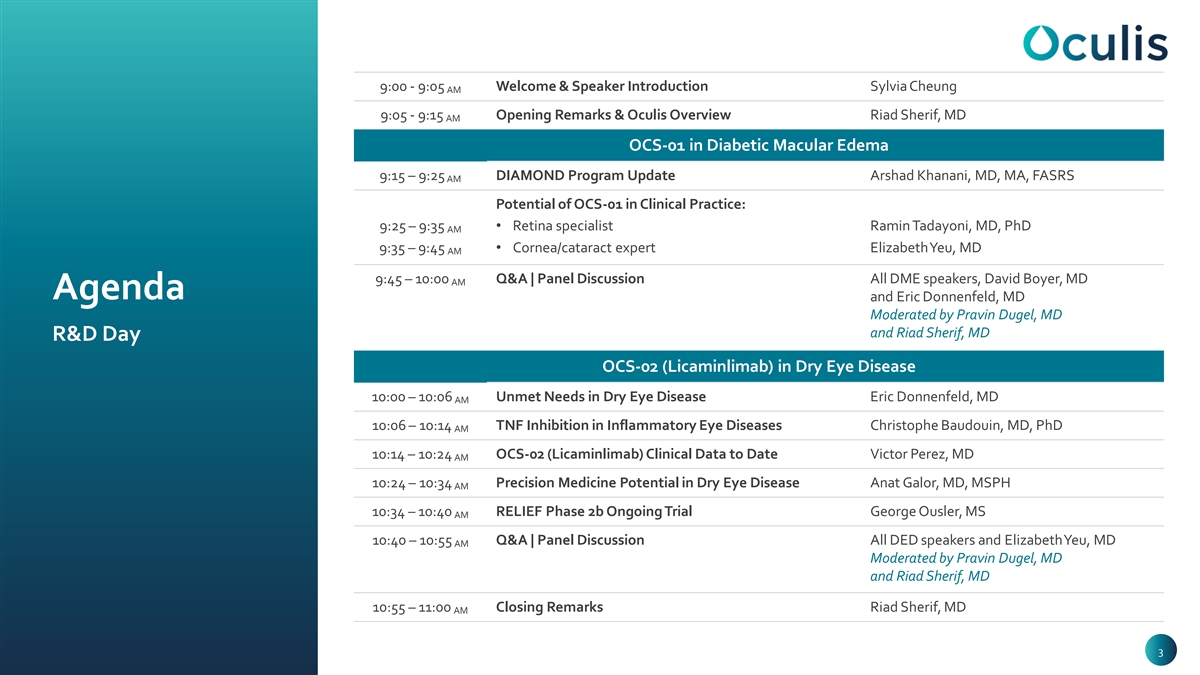
9:00 - 9:05 Welcome & Speaker Introduction Sylvia Cheung AM 9:05 - 9:15 Opening Remarks & Oculis Overview Riad Sherif, MD AM OCS-01 in Diabetic Macular Edema 9:15 – 9:25 DIAMOND Program Update Arshad Khanani, MD, MA, FASRS AM Potential of OCS-01 in Clinical Practice: 9:25 – 9:35 • Retina specialist Ramin Tadayoni, MD, PhD AM 9:35 – 9:45 • Cornea/cataract expert Elizabeth Yeu, MD AM 9:45 – 10:00 Q&A | Panel Discussion All DME speakers, David Boyer, MD AM Agenda and Eric Donnenfeld, MD Moderated by Pravin Dugel, MD and Riad Sherif, MD R&D Day OCS-02 (Licaminlimab) in Dry Eye Disease 10:00 – 10:06 Unmet Needs in Dry Eye Disease Eric Donnenfeld, MD AM 10:06 – 10:14 TNF Inhibition in Inflammatory Eye Diseases Christophe Baudouin, MD, PhD AM 10:14 – 10:24 OCS-02 (Licaminlimab) Clinical Data to Date Victor Perez, MD AM 10:24 – 10:34 Precision Medicine Potential in Dry Eye Disease Anat Galor, MD, MSPH AM 10:34 – 10:40 RELIEF Phase 2b Ongoing Trial George Ousler, MS AM 10:40 – 10:55 Q&A | Panel Discussion All DED speakers and Elizabeth Yeu, MD AM Moderated by Pravin Dugel, MD and Riad Sherif, MD 10:55 – 11:00 Closing Remarks Riad Sherif, MD AM 3 3
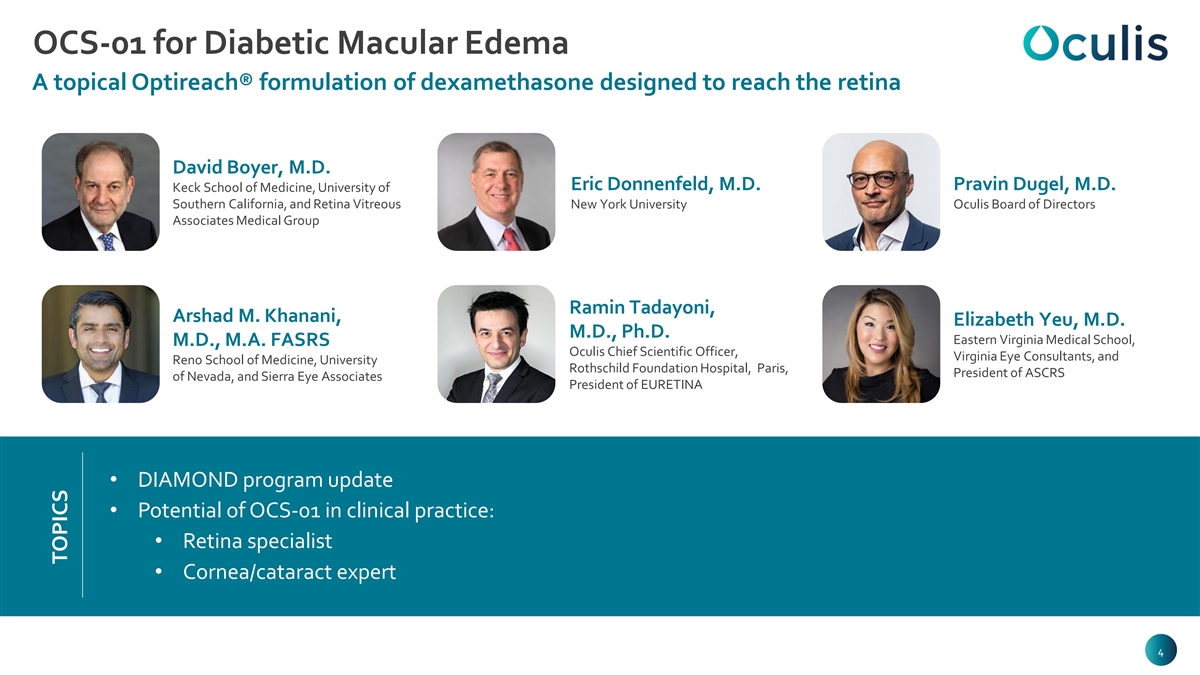
OCS-01 for Diabetic Macular Edema A topical Optireach® formulation of dexamethasone designed to reach the retina David Boyer, M.D. Eric Donnenfeld, M.D. Pravin Dugel, M.D. Keck School of Medicine, University of Southern California, and Retina Vitreous New York University Oculis Board of Directors Associates Medical Group Ramin Tadayoni, Arshad M. Khanani, Elizabeth Yeu, M.D. M.D., Ph.D. Eastern Virginia Medical School, M.D., M.A. FASRS Oculis Chief Scientific Officer, Virginia Eye Consultants, and Reno School of Medicine, University Rothschild Foundation Hospital, Paris, President of ASCRS of Nevada, and Sierra Eye Associates President of EURETINA • DIAMOND program update • Potential of OCS-01 in clinical practice: • Retina specialist • Cornea/cataract expert 4 4 4 4 TOPICS TOPICS
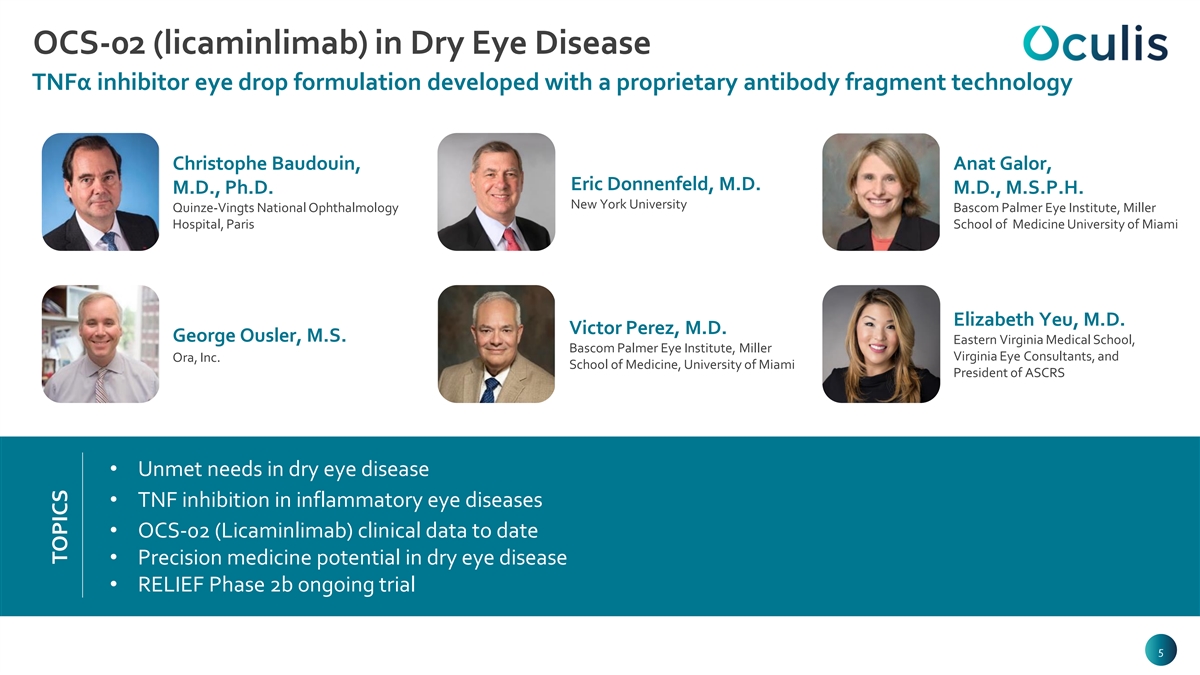
OCS-02 (licaminlimab) in Dry Eye Disease TNFα inhibitor eye drop formulation developed with a proprietary antibody fragment technology Christophe Baudouin, Anat Galor, Eric Donnenfeld, M.D. M.D., Ph.D. M.D., M.S.P.H. New York University Quinze-Vingts National Ophthalmology Bascom Palmer Eye Institute, Miller Hospital, Paris School of Medicine University of Miami Elizabeth Yeu, M.D. Victor Perez, M.D. George Ousler, M.S. Eastern Virginia Medical School, Bascom Palmer Eye Institute, Miller Virginia Eye Consultants, and Ora, Inc. School of Medicine, University of Miami President of ASCRS • Unmet needs in dry eye disease • TNF inhibition in inflammatory eye diseases • OCS-02 (Licaminlimab) clinical data to date • Precision medicine potential in dry eye disease • RELIEF Phase 2b ongoing trial 5 5 5 5 TOPICS TOPICS
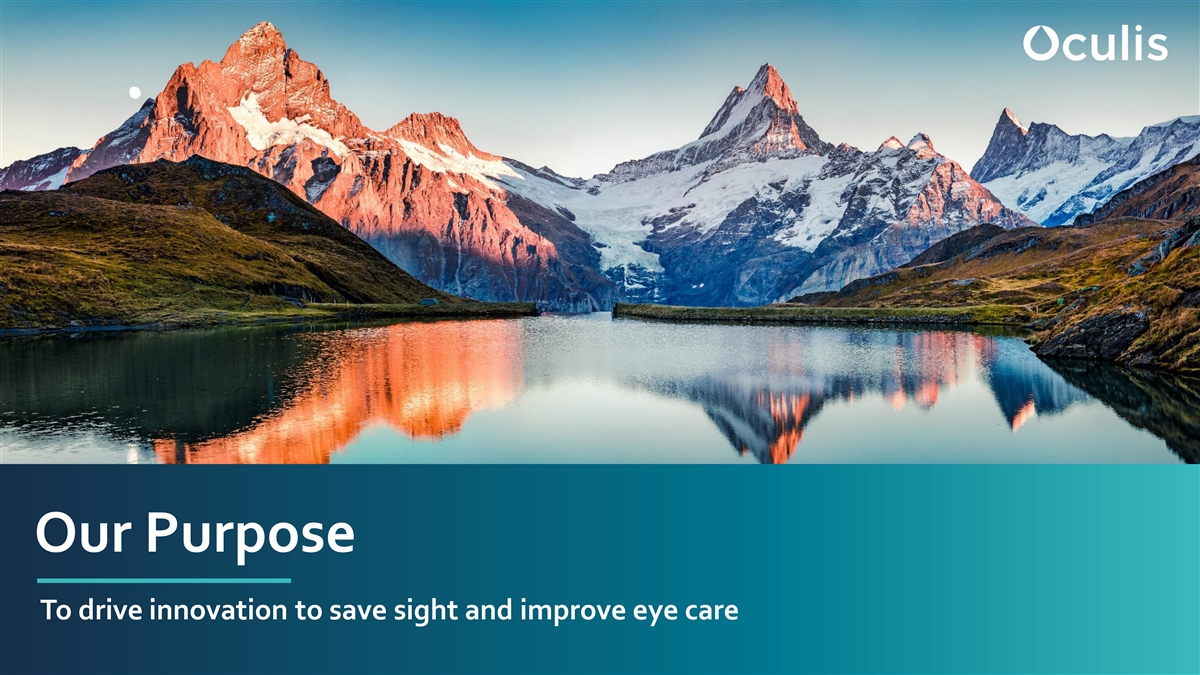
Our Purpose To drive innovation to save sight and improve eye care
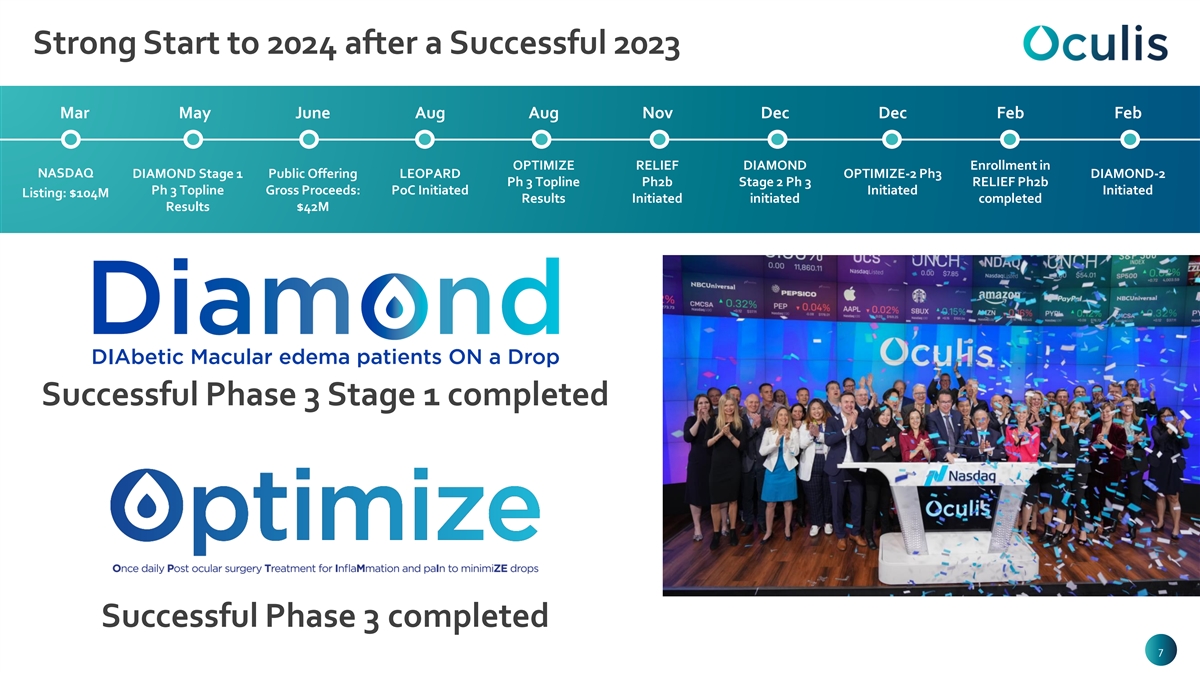
Strong Start to 2024 after a Successful 2023 Mar May June Aug Aug Nov Dec Dec Feb Feb OPTIMIZE RELIEF DIAMOND Enrollment in NASDAQ DIAMOND Stage 1 Public Offering LEOPARD OPTIMIZE-2 Ph3 DIAMOND-2 Ph 3 Topline Ph2b Stage 2 Ph 3 RELIEF Ph2b Ph 3 Topline Gross Proceeds: PoC Initiated Initiated Initiated Listing: $104M Results Initiated initiated completed Results $42M Successful Phase 3 Stage 1 completed Successful Phase 3 completed 7 7 7 7
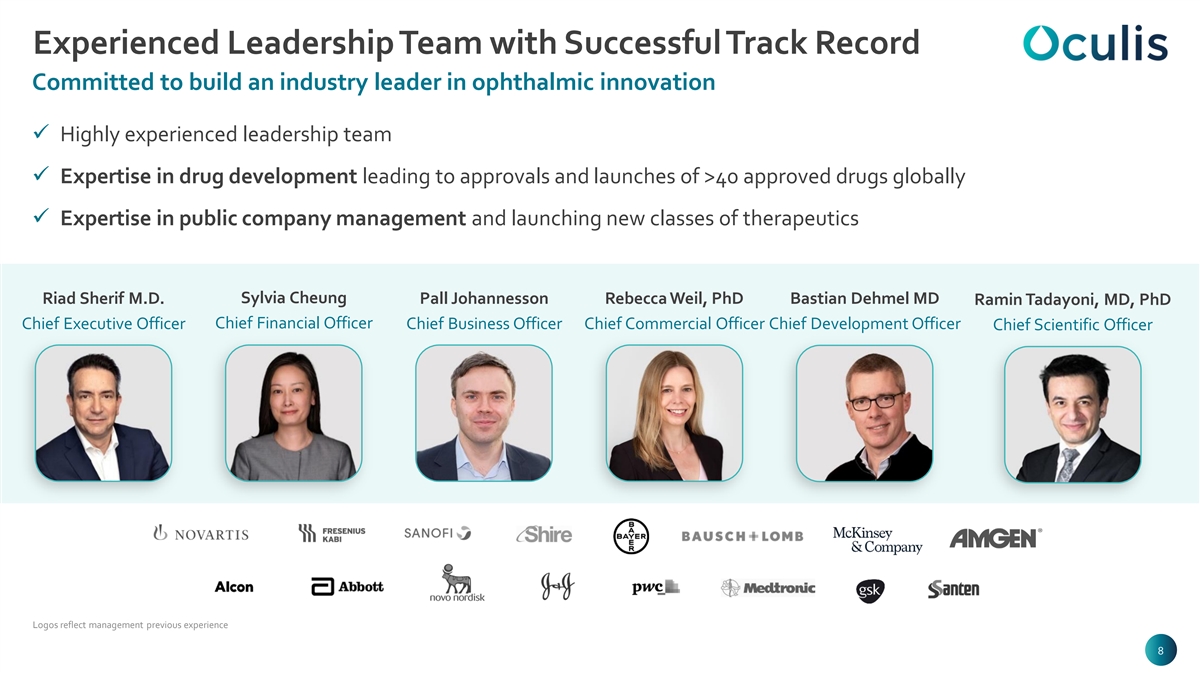
Experienced Leadership Team with Successful Track Record Committed to build an industry leader in ophthalmic innovation ✓ Highly experienced leadership team ✓ Expertise in drug development leading to approvals and launches of >40 approved drugs globally ✓ Expertise in public company management and launching new classes of therapeutics Riad Sherif M.D. Sylvia Cheung Pall Johannesson Rebecca Weil, PhD Bastian Dehmel MD Ramin Tadayoni, MD, PhD Chief Executive Officer Chief Financial Officer Chief Business Officer Chief Commercial Officer Chief Development Officer Chief Scientific Officer Logos reflect management previous experience 8 8 8 8
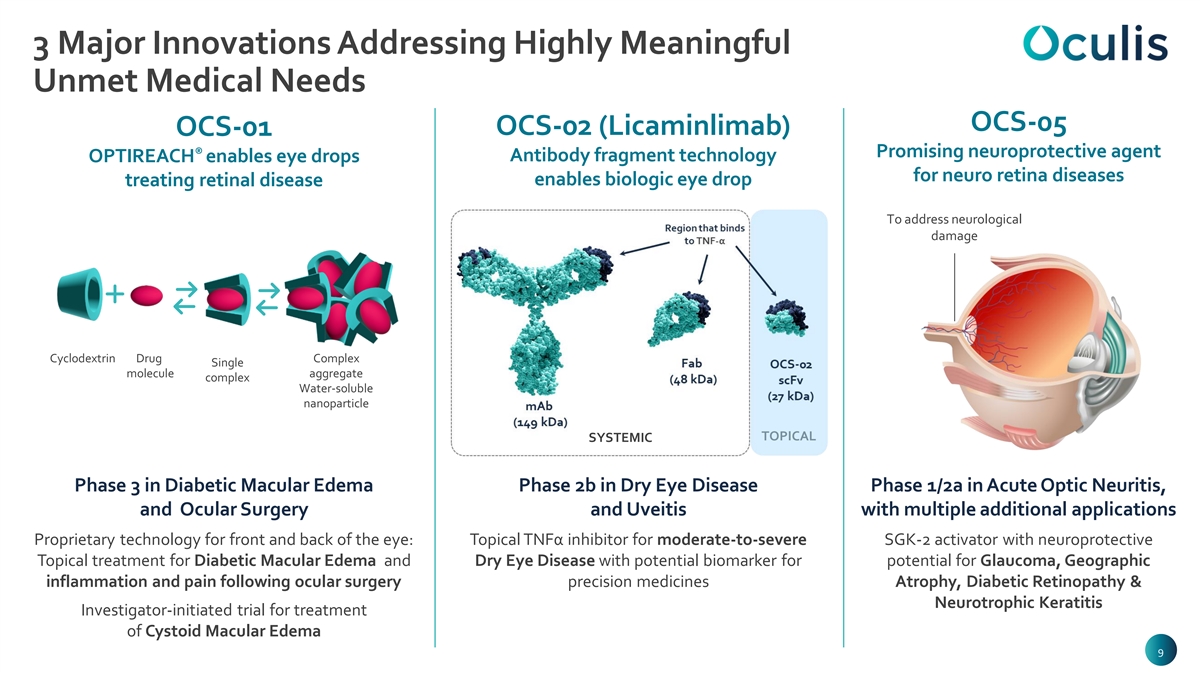
3 Major Innovations Addressing Highly Meaningful Unmet Medical Needs OCS-05 OCS-02 (Licaminlimab) OCS-01 ® Promising neuroprotective agent Antibody fragment technology OPTIREACH enables eye drops for neuro retina diseases enables biologic eye drop treating retinal disease To address neurological damage Cyclodextrin Drug Complex Single molecule aggregate complex Water-soluble nanoparticle TOPICAL SYSTEMIC Phase 3 in Diabetic Macular Edema Phase 2b in Dry Eye Disease Phase 1/2a in Acute Optic Neuritis, and Ocular Surgery and Uveitis with multiple additional applications Proprietary technology for front and back of the eye: Topical TNFα inhibitor for moderate-to-severe SGK-2 activator with neuroprotective Topical treatment for Diabetic Macular Edema and Dry Eye Disease with potential biomarker for potential for Glaucoma, Geographic inflammation and pain following ocular surgery precision medicines Atrophy, Diabetic Retinopathy & Neurotrophic Keratitis Investigator-initiated trial for treatment of Cystoid Macular Edema 9 9 9 9
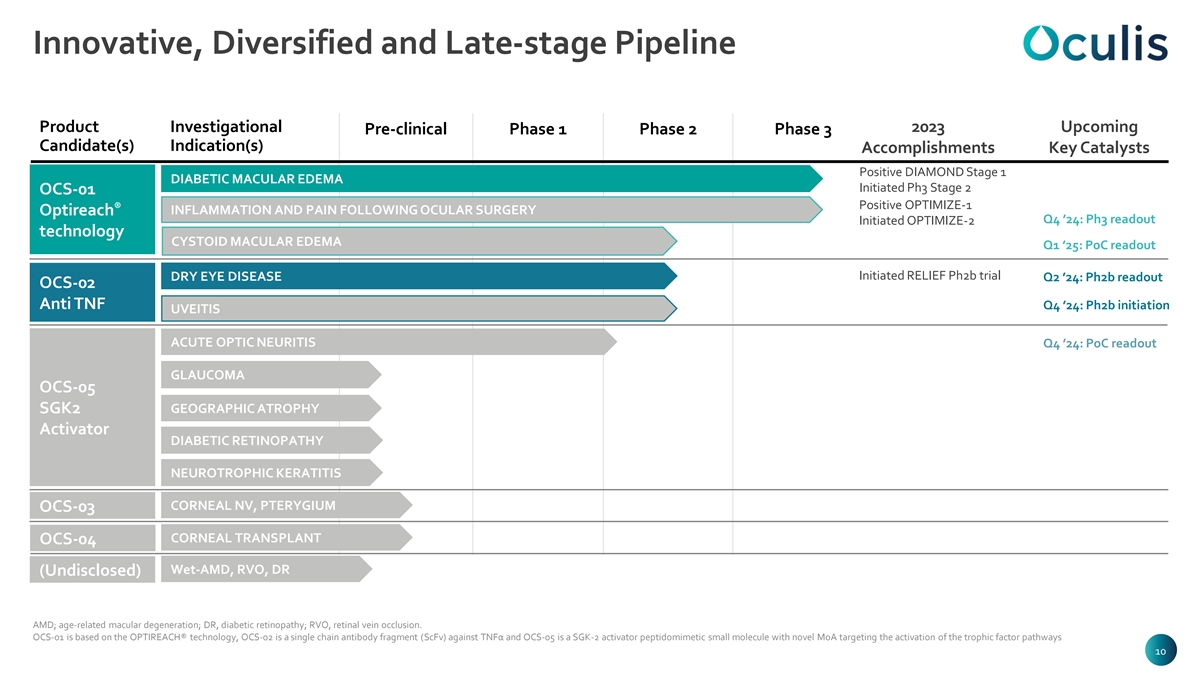
Innovative, Diversified and Late-stage Pipeline Product Investigational 2023 Upcoming Pre-clinical Phase 1 Phase 2 Phase 3 Candidate(s) Indication(s) Accomplishments Key Catalysts Positive DIAMOND Stage 1 DIABETIC MACULAR EDEMA Initiated Ph3 Stage 2 OCS-01 Positive OPTIMIZE-1 ® INFLAMMATION AND PAIN FOLLOWING OCULAR SURGERY Optireach Q4 ’24: Ph3 readout Initiated OPTIMIZE-2 technology CYSTOID MACULAR EDEMA Q1 ’25: PoC readout Initiated RELIEF Ph2b trial DRY EYE DISEASE Q2 ’24: Ph2b readout OCS-02 Anti TNF Q4 ’24: Ph2b initiation UVEITIS ACUTE OPTIC NEURITIS Q4 ’24: PoC readout GLAUCOMA OCS-05 SGK2 GEOGRAPHIC ATROPHY Activator DIABETIC RETINOPATHY NEUROTROPHIC KERATITIS CORNEAL NV, PTERYGIUM OCS-03 CORNEAL TRANSPLANT OCS-04 Wet-AMD, RVO, DR (Undisclosed) AMD; age-related macular degeneration; DR, diabetic retinopathy; RVO, retinal vein occlusion. OCS-01 is based on the OPTIREACH® technology, OCS-02 is a single chain antibody fragment (ScFv) against TNFα and OCS-05 is a SGK-2 activator peptidomimetic small molecule with novel MoA targeting the activation of the trophic factor pathways 10 10 10 10
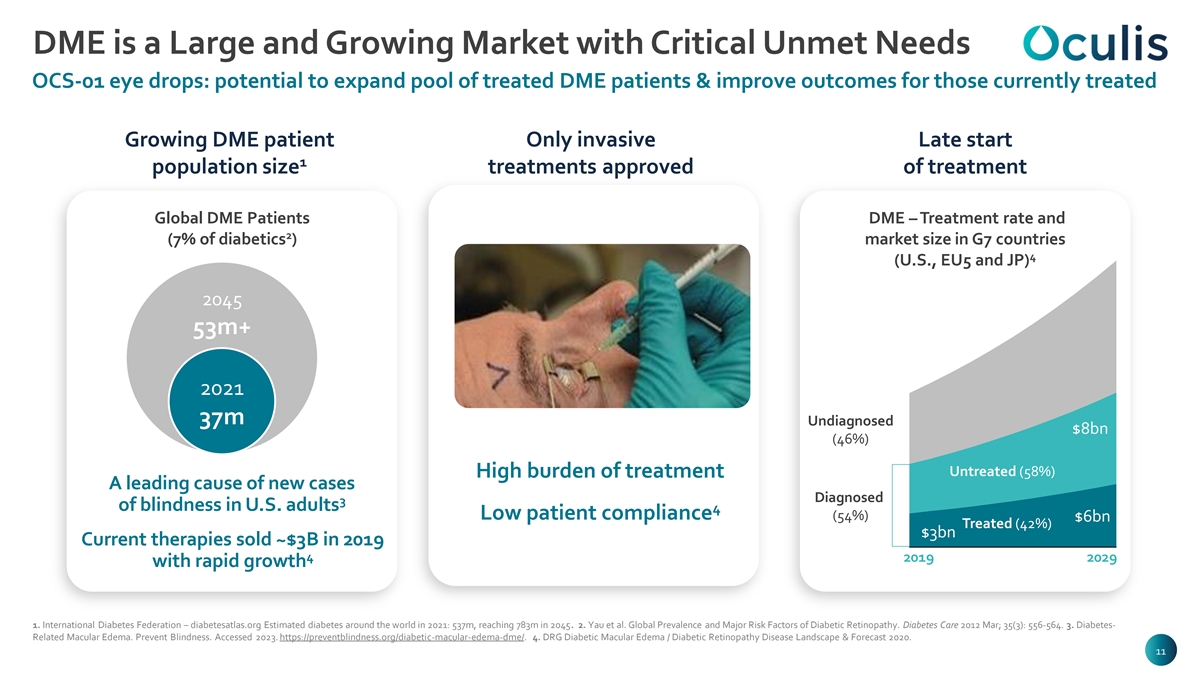
DME is a Large and Growing Market with Critical Unmet Needs OCS-01 eye drops: potential to expand pool of treated DME patients & improve outcomes for those currently treated Growing DME patient Only invasive Late start 1 population size treatments approved of treatment Global DME Patients DME – Treatment rate and 2 (7% of diabetics ) market size in G7 countries 4 (U.S., EU5 and JP) 2045 53m+ 2021 37m Undiagnosed $8bn (46%) Untreated (58%) High burden of treatment A leading cause of new cases Diagnosed 3 of blindness in U.S. adults 4 Low patient compliance (54%) $6bn Treated (42%) $3bn Current therapies sold ~$3B in 2019 4 2019 2029 with rapid growth 1. International Diabetes Federation – diabetesatlas.org Estimated diabetes around the world in 2021: 537m, reaching 783m in 2045. 2. Yau et al. Global Prevalence and Major Risk Factors of Diabetic Retinopathy. Diabetes Care 2012 Mar; 35(3): 556-564. 3. Diabetes- Related Macular Edema. Prevent Blindness. Accessed 2023. https://preventblindness.org/diabetic-macular-edema-dme/. 4. DRG Diabetic Macular Edema / Diabetic Retinopathy Disease Landscape & Forecast 2020. 11 11 11 11 11
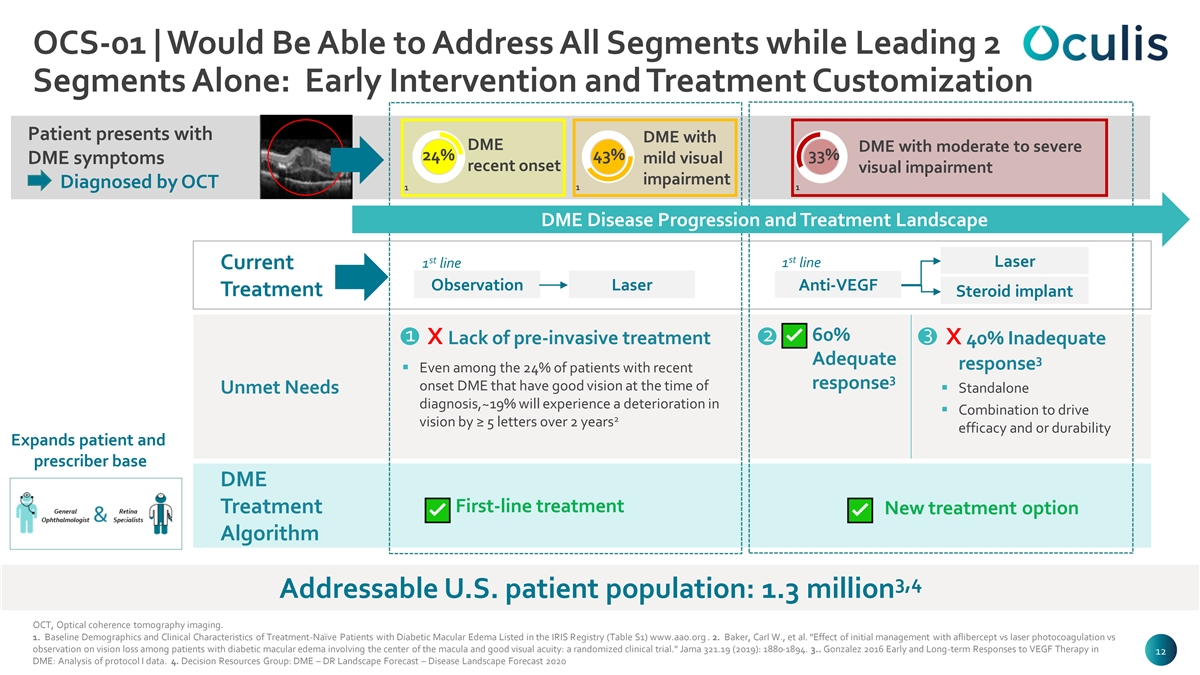
OCS-01 | Would Be Able to Address All Segments while Leading 2 Segments Alone: Early Intervention and Treatment Customization Patient presents with DME with DME DME with moderate to severe 43% 33% 24% DME symptoms mild visual recent onset visual impairment impairment Diagnosed by OCT 1 1 1 DME Disease Progression and Treatment Landscape st st 1 line 1 line Laser Current Observation Laser Anti-VEGF Treatment Steroid implant 3 1 2 60% 1 X Lack of pre-invasive treatment X 40% Inadequate 3 Adequate response ▪ Even among the 24% of patients with recent 3 response onset DME that have good vision at the time of ▪ Standalone Unmet Needs diagnosis,~19% will experience a deterioration in ▪ Combination to drive 2 vision by ≥ 5 letters over 2 years efficacy and or durability Expands patient and prescriber base DME First-line treatment Treatment New treatment option Algorithm 3,4 Addressable U.S. patient population: 1.3 million OCT, Optical coherence tomography imaging. 1. Baseline Demographics and Clinical Characteristics of Treatment-Naïve Patients with Diabetic Macular Edema Listed in the IRIS Registry (Table S1) www.aao.org . 2. Baker, Carl W., et al. Effect of initial management with aflibercept vs laser photocoagulation vs observation on vision loss among patients with diabetic macular edema involving the center of the macula and good visual acuity: a randomized clinical trial. Jama 321.19 (2019): 1880-1894. 3.. Gonzalez 2016 Early and Long-term Responses to VEGF Therapy in 12 12 12 12 DME: Analysis of protocol I data. 4. Decision Resources Group: DME – DR Landscape Forecast – Disease Landscape Forecast 2020
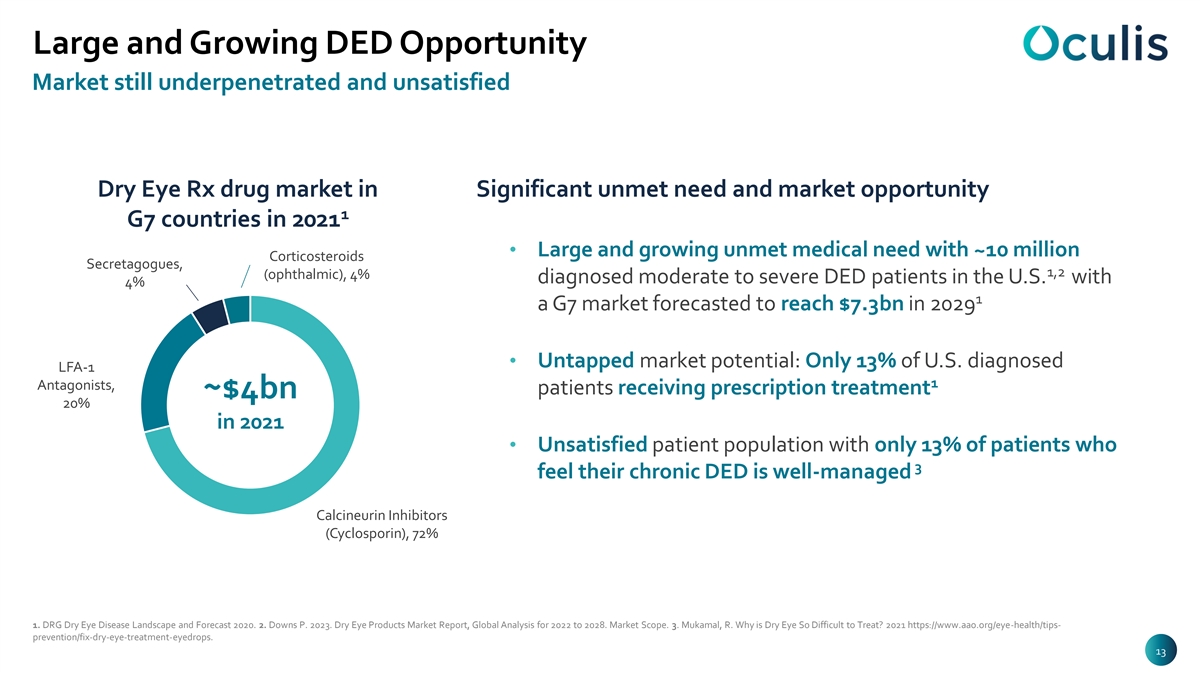
Large and Growing DED Opportunity Market still underpenetrated and unsatisfied Dry Eye Rx drug market in Significant unmet need and market opportunity 1 G7 countries in 2021 • Large and growing unmet medical need with ~10 million Corticosteroids Secretagogues, 1,2 (ophthalmic), 4% diagnosed moderate to severe DED patients in the U.S. with 4% 1 a G7 market forecasted to reach $7.3bn in 2029 • Untapped market potential: Only 13% of U.S. diagnosed LFA-1 1 Antagonists, patients receiving prescription treatment ~$4bn 20% in 2021 • Unsatisfied patient population with only 13% of patients who 3 feel their chronic DED is well-managed Calcineurin Inhibitors (Cyclosporin), 72% 1. DRG Dry Eye Disease Landscape and Forecast 2020. 2. Downs P. 2023. Dry Eye Products Market Report, Global Analysis for 2022 to 2028. Market Scope. 3. Mukamal, R. Why is Dry Eye So Difficult to Treat? 2021 https://www.aao.org/eye-health/tips- prevention/fix-dry-eye-treatment-eyedrops. 13 13 13 13
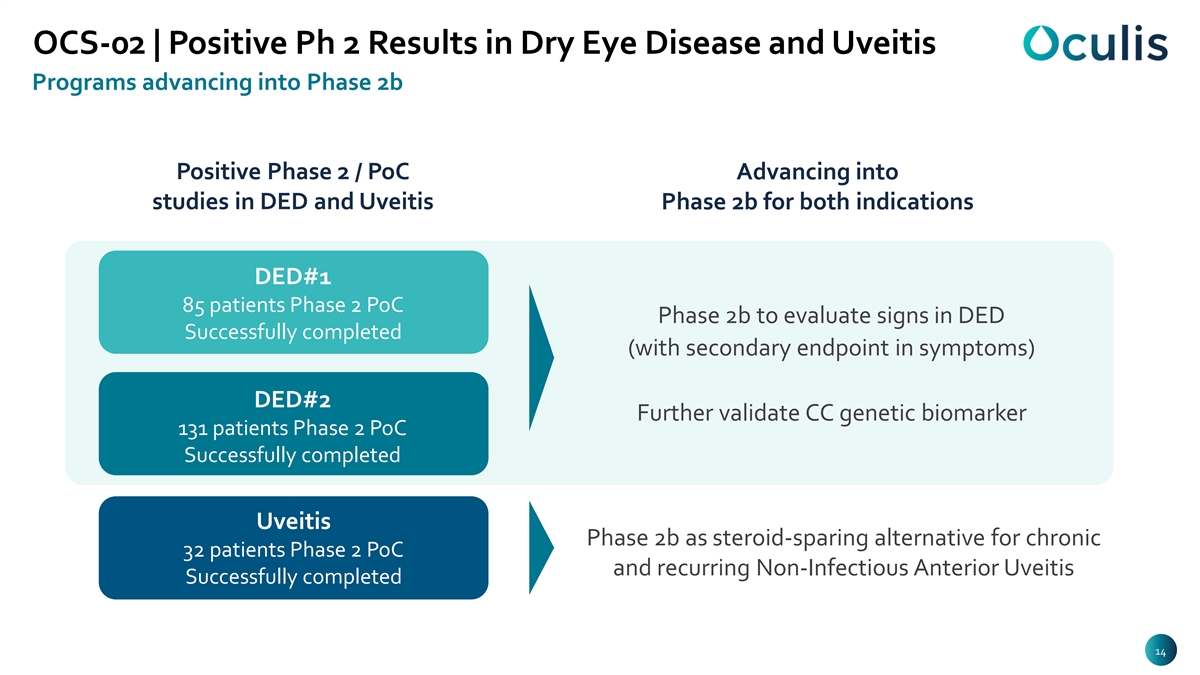
OCS-02 | Positive Ph 2 Results in Dry Eye Disease and Uveitis Programs advancing into Phase 2b Positive Phase 2 / PoC Advancing into studies in DED and Uveitis Phase 2b for both indications DED#1 85 patients Phase 2 PoC Phase 2b to evaluate signs in DED Successfully completed (with secondary endpoint in symptoms) DED#2 Further validate CC genetic biomarker 131 patients Phase 2 PoC Successfully completed Uveitis Phase 2b as steroid-sparing alternative for chronic 32 patients Phase 2 PoC and recurring Non-Infectious Anterior Uveitis Successfully completed 14 14 14 14
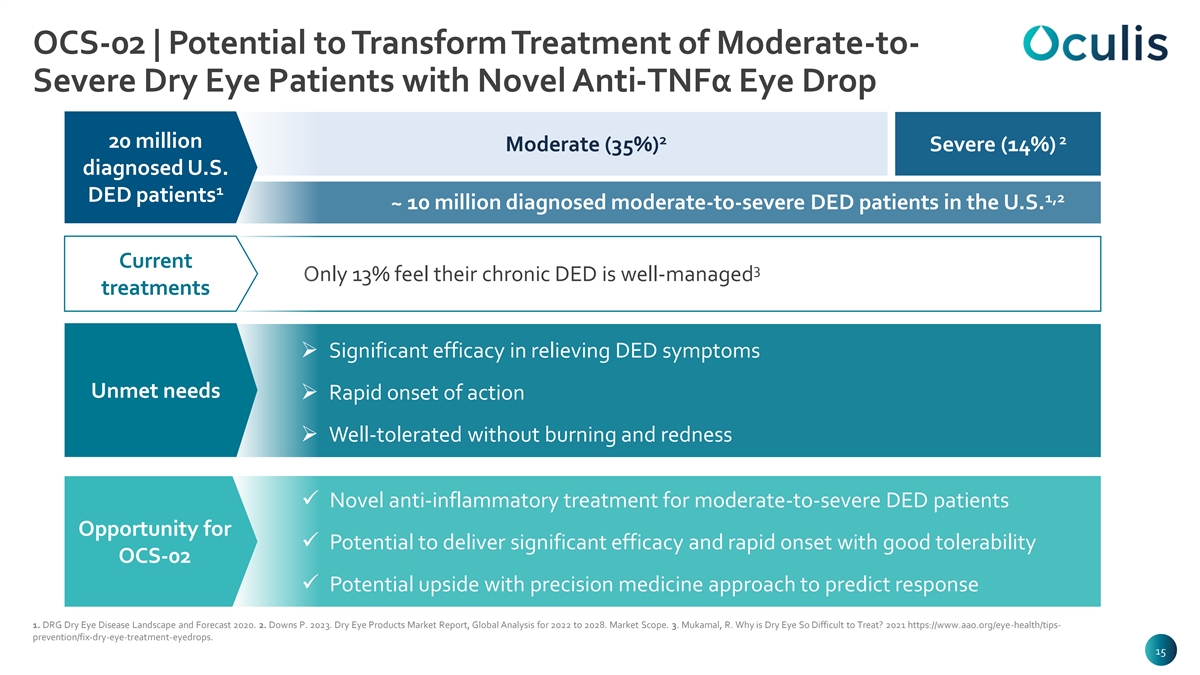
OCS-02 | Potential to Transform Treatment of Moderate-to- Severe Dry Eye Patients with Novel Anti-TNFα Eye Drop 2 2 20 million Moderate (35%) Severe (14%) diagnosed U.S. 1 DED patients 1,2 ~ 10 million diagnosed moderate-to-severe DED patients in the U.S. Current 3 Only 13% feel their chronic DED is well-managed treatments ➢ Significant efficacy in relieving DED symptoms Unmet needs ➢ Rapid onset of action ➢ Well-tolerated without burning and redness ✓ Novel anti-inflammatory treatment for moderate-to-severe DED patients Opportunity for ✓ Potential to deliver significant efficacy and rapid onset with good tolerability OCS-02 ✓ Potential upside with precision medicine approach to predict response 1. DRG Dry Eye Disease Landscape and Forecast 2020. 2. Downs P. 2023. Dry Eye Products Market Report, Global Analysis for 2022 to 2028. Market Scope. 3. Mukamal, R. Why is Dry Eye So Difficult to Treat? 2021 https://www.aao.org/eye-health/tips- prevention/fix-dry-eye-treatment-eyedrops. 15 15 15 15
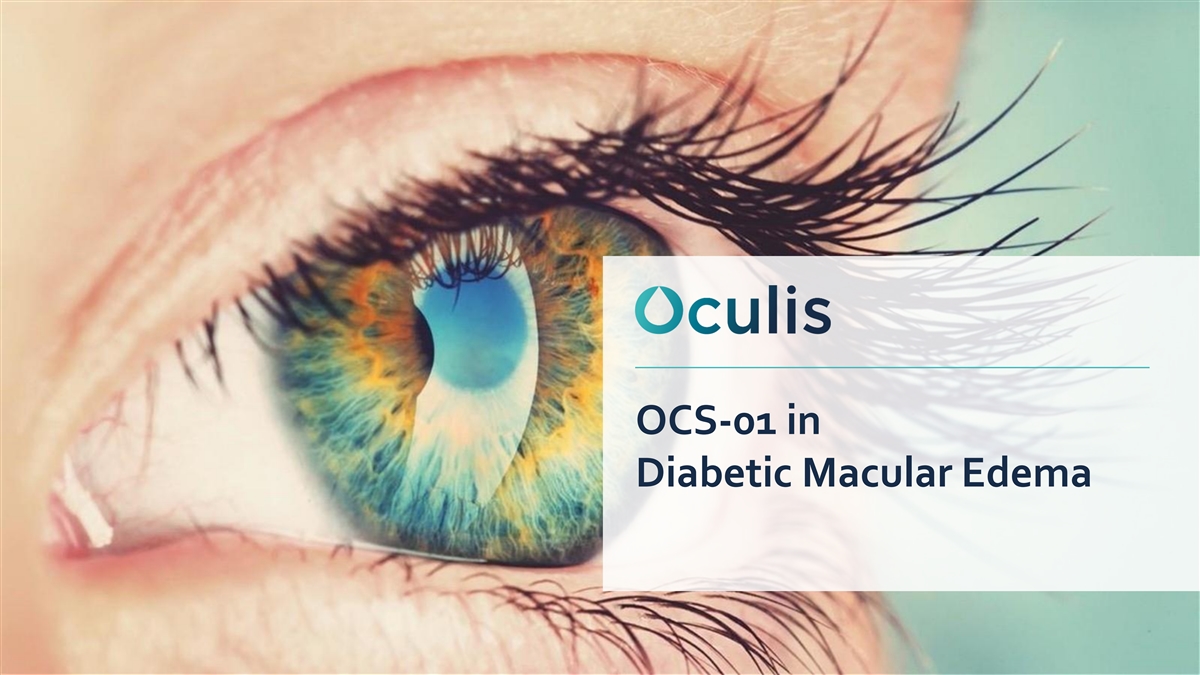
OCS-01 in Diabetic Macular Edema
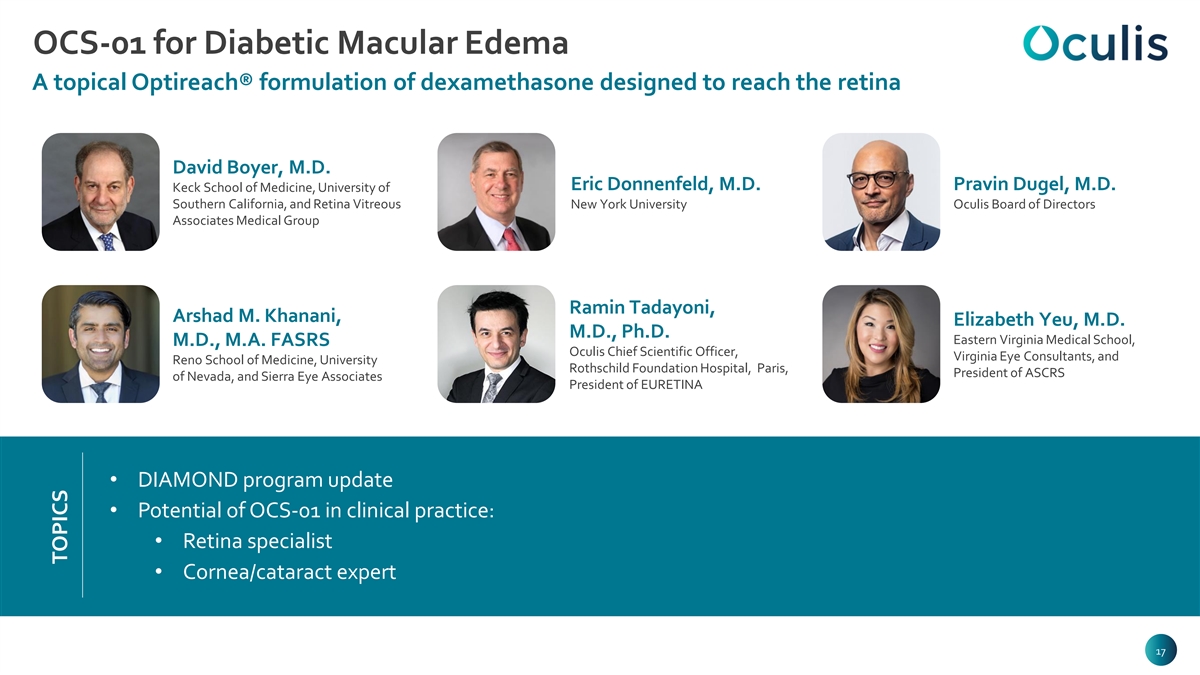
OCS-01 for Diabetic Macular Edema A topical Optireach® formulation of dexamethasone designed to reach the retina David Boyer, M.D. Eric Donnenfeld, M.D. Pravin Dugel, M.D. Keck School of Medicine, University of Southern California, and Retina Vitreous New York University Oculis Board of Directors Associates Medical Group Ramin Tadayoni, Arshad M. Khanani, Elizabeth Yeu, M.D. M.D., Ph.D. Eastern Virginia Medical School, M.D., M.A. FASRS Oculis Chief Scientific Officer, Virginia Eye Consultants, and Reno School of Medicine, University Rothschild Foundation Hospital, Paris, President of ASCRS of Nevada, and Sierra Eye Associates President of EURETINA • DIAMOND program update • Potential of OCS-01 in clinical practice: • Retina specialist • Cornea/cataract expert 17 17 17 17 TOPICS TOPICS
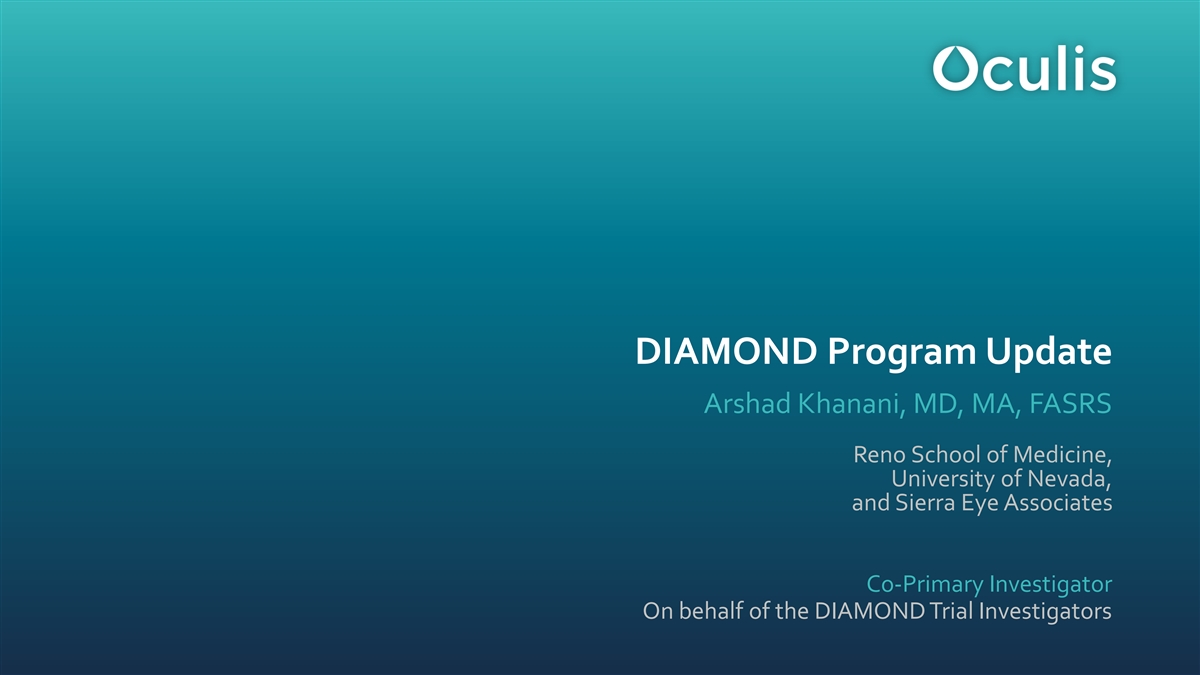
DIAMOND Program Update Arshad Khanani, MD, MA, FASRS Reno School of Medicine, University of Nevada, and Sierra Eye Associates Co-Primary Investigator On behalf of the DIAMOND Trial Investigators 18 18
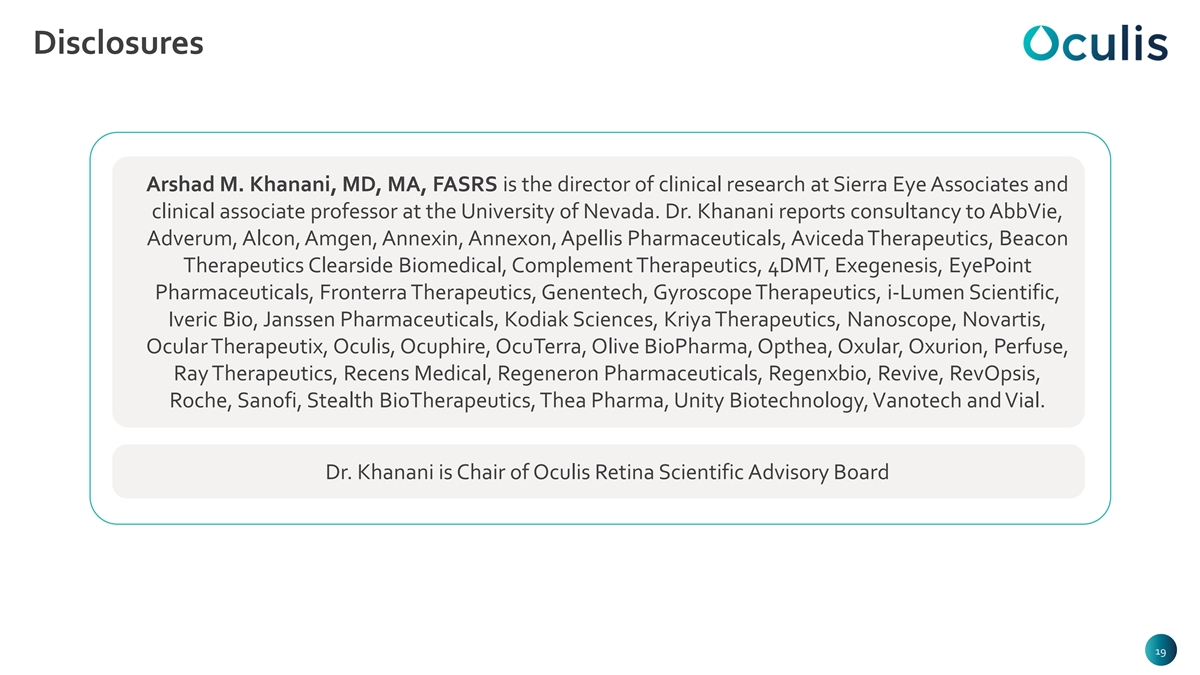
Disclosures Arshad M. Khanani, MD, MA, FASRS is the director of clinical research at Sierra Eye Associates and clinical associate professor at the University of Nevada. Dr. Khanani reports consultancy to AbbVie, Adverum, Alcon, Amgen, Annexin, Annexon, Apellis Pharmaceuticals, Aviceda Therapeutics, Beacon Therapeutics Clearside Biomedical, Complement Therapeutics, 4DMT, Exegenesis, EyePoint Pharmaceuticals, Fronterra Therapeutics, Genentech, Gyroscope Therapeutics, i-Lumen Scientific, Iveric Bio, Janssen Pharmaceuticals, Kodiak Sciences, Kriya Therapeutics, Nanoscope, Novartis, Ocular Therapeutix, Oculis, Ocuphire, OcuTerra, Olive BioPharma, Opthea, Oxular, Oxurion, Perfuse, Ray Therapeutics, Recens Medical, Regeneron Pharmaceuticals, Regenxbio, Revive, RevOpsis, Roche, Sanofi, Stealth BioTherapeutics, Thea Pharma, Unity Biotechnology, Vanotech and Vial. Dr. Khanani is Chair of Oculis Retina Scientific Advisory Board 19 19 19 19
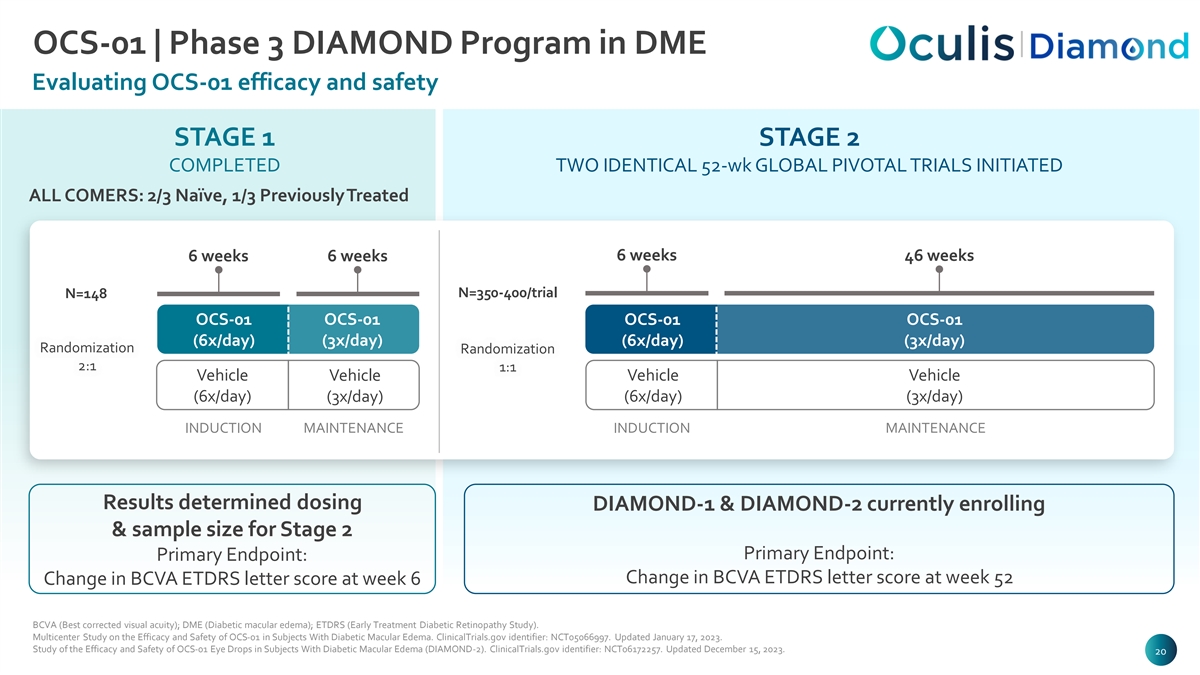
OCS-01 | Phase 3 DIAMOND Program in DME Evaluating OCS-01 efficacy and safety STAGE 1 STAGE 2 COMPLETED TWO IDENTICAL 52-wk GLOBAL PIVOTAL TRIALS INITIATED ALL COMERS: 2/3 Naïve, 1/3 Previously Treated 6 weeks 6 weeks 6 weeks 46 weeks N=350-400/trial N=148 OCS-01 OCS-01 OCS-01 OCS-01 (6x/day) (3x/day) (6x/day) (3x/day) Randomization Randomization 2:1 1:1 Vehicle Vehicle Vehicle Vehicle (6x/day) (6x/day) (3x/day) (3x/day) INDUCTION MAINTENANCE INDUCTION MAINTENANCE Results determined dosing DIAMOND-1 & DIAMOND-2 currently enrolling & sample size for Stage 2 Primary Endpoint: Primary Endpoint: Change in BCVA ETDRS letter score at week 52 Change in BCVA ETDRS letter score at week 6 BCVA (Best corrected visual acuity); DME (Diabetic macular edema); ETDRS (Early Treatment Diabetic Retinopathy Study). Multicenter Study on the Efficacy and Safety of OCS-01 in Subjects With Diabetic Macular Edema. ClinicalTrials.gov identifier: NCT05066997. Updated January 17, 2023. Study of the Efficacy and Safety of OCS-01 Eye Drops in Subjects With Diabetic Macular Edema (DIAMOND-2). ClinicalTrials.gov identifier: NCT06172257. Updated December 15, 2023. 20 20 20 20
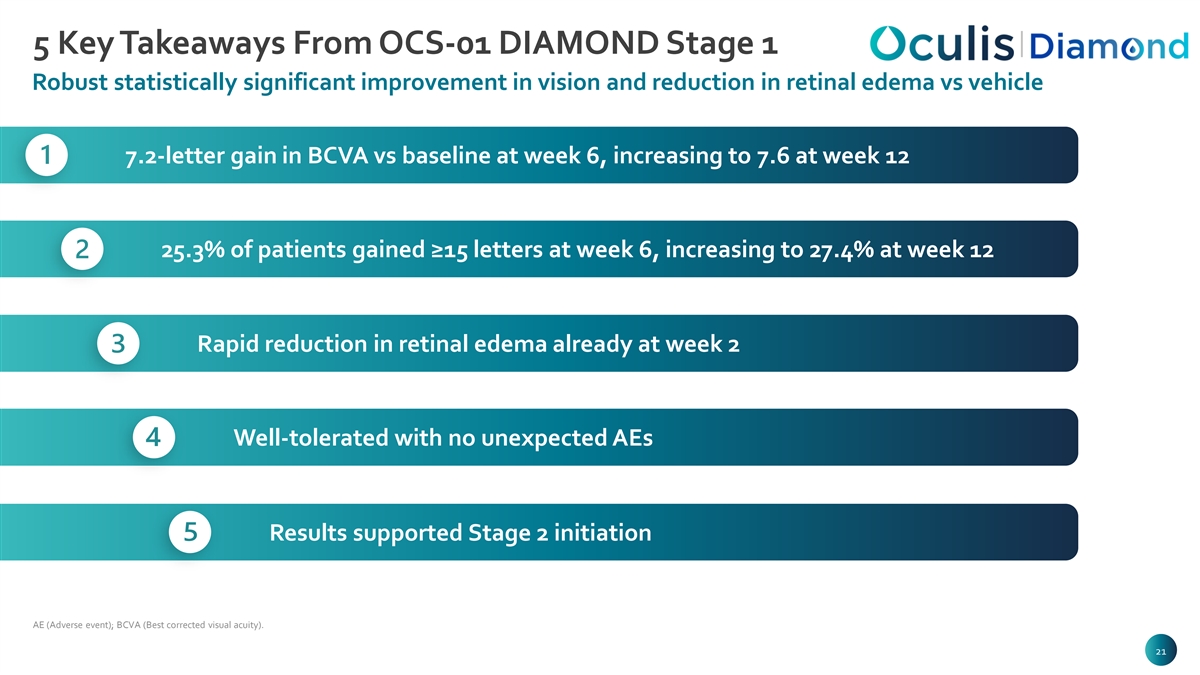
5 Key Takeaways From OCS-01 DIAMOND Stage 1 Robust statistically significant improvement in vision and reduction in retinal edema vs vehicle 7.2-letter gain in BCVA vs baseline at week 6, increasing to 7.6 at week 12 25.3% of patients gained ≥15 letters at week 6, increasing to 27.4% at week 12 Rapid reduction in retinal edema already at week 2 Well-tolerated with no unexpected AEs Results supported Stage 2 initiation AE (Adverse event); BCVA (Best corrected visual acuity). 21 21 21 21
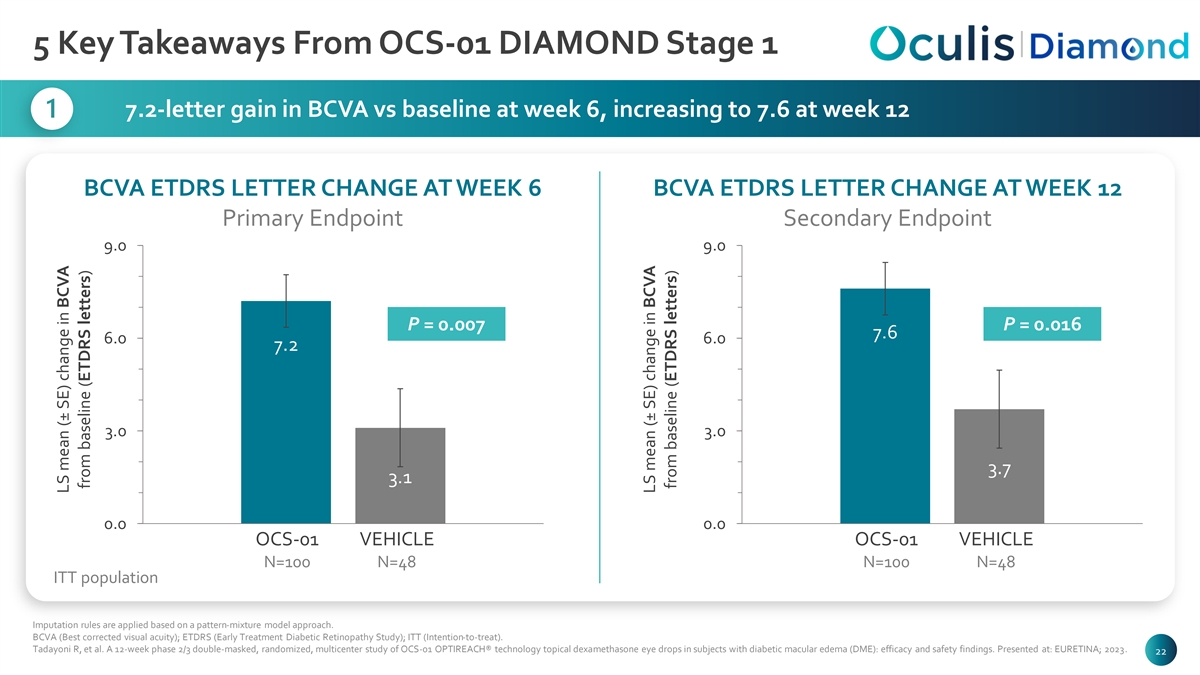
5 Key Takeaways From OCS-01 DIAMOND Stage 1 7.2-letter gain in BCVA vs baseline at week 6, increasing to 7.6 at week 12 BCVA ETDRS LETTER CHANGE AT WEEK 6 BCVA ETDRS LETTER CHANGE AT WEEK 12 Primary Endpoint Secondary Endpoint 9.0 9.0 P = 0.007 P = 0.016 7.6 6.0 6.0 7.2 3.0 3.0 3.7 3.1 0.0 0.0 OCS-01 VEHICLE OCS-01 VEHICLE N=100 N=48 N=100 N=48 ITT population Imputation rules are applied based on a pattern-mixture model approach. BCVA (Best corrected visual acuity); ETDRS (Early Treatment Diabetic Retinopathy Study); ITT (Intention-to-treat). Tadayoni R, et al. A 12-week phase 2/3 double-masked, randomized, multicenter study of OCS-01 OPTIREACH® technology topical dexamethasone eye drops in subjects with diabetic macular edema (DME): efficacy and safety findings. Presented at: EURETINA; 2023. 22 22 22 22 LS mean (± SE) change in BCVA from baseline (ETDRS letters) LS mean (± SE) change in BCVA from baseline (ETDRS letters)
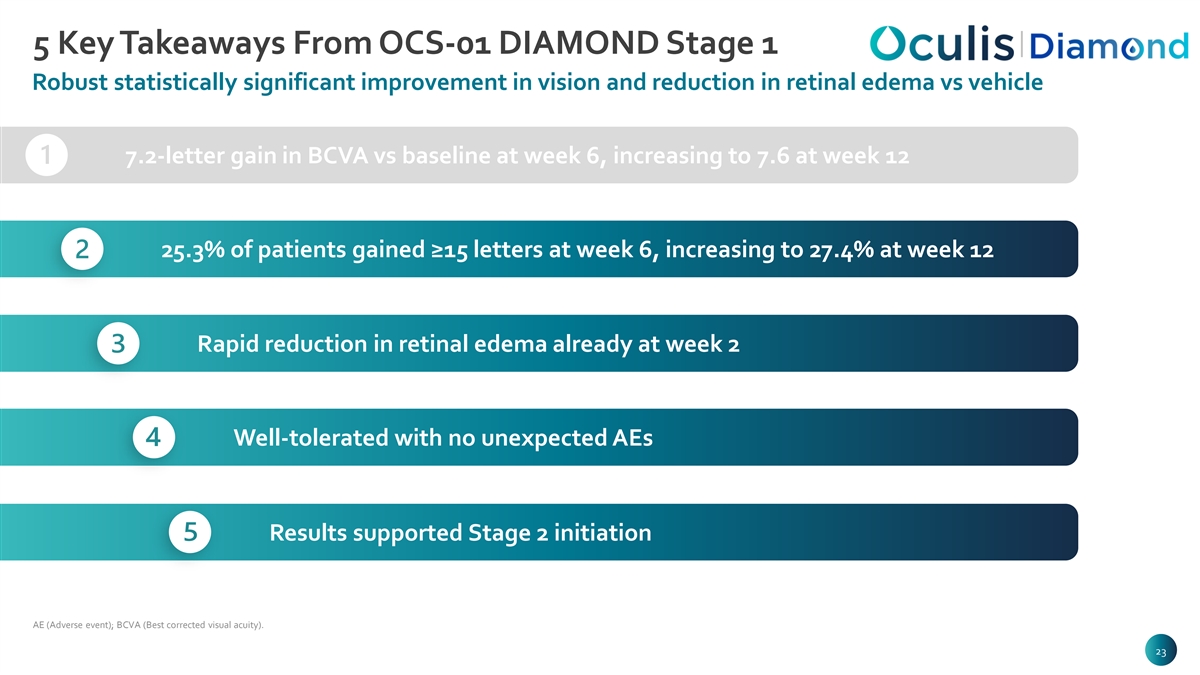
5 Key Takeaways From OCS-01 DIAMOND Stage 1 Robust statistically significant improvement in vision and reduction in retinal edema vs vehicle 7.2-letter gain in BCVA vs baseline at week 6, increasing to 7.6 at week 12 25.3% of patients gained ≥15 letters at week 6, increasing to 27.4% at week 12 Rapid reduction in retinal edema already at week 2 Well-tolerated with no unexpected AEs Results supported Stage 2 initiation AE (Adverse event); BCVA (Best corrected visual acuity). 23 23 23 23
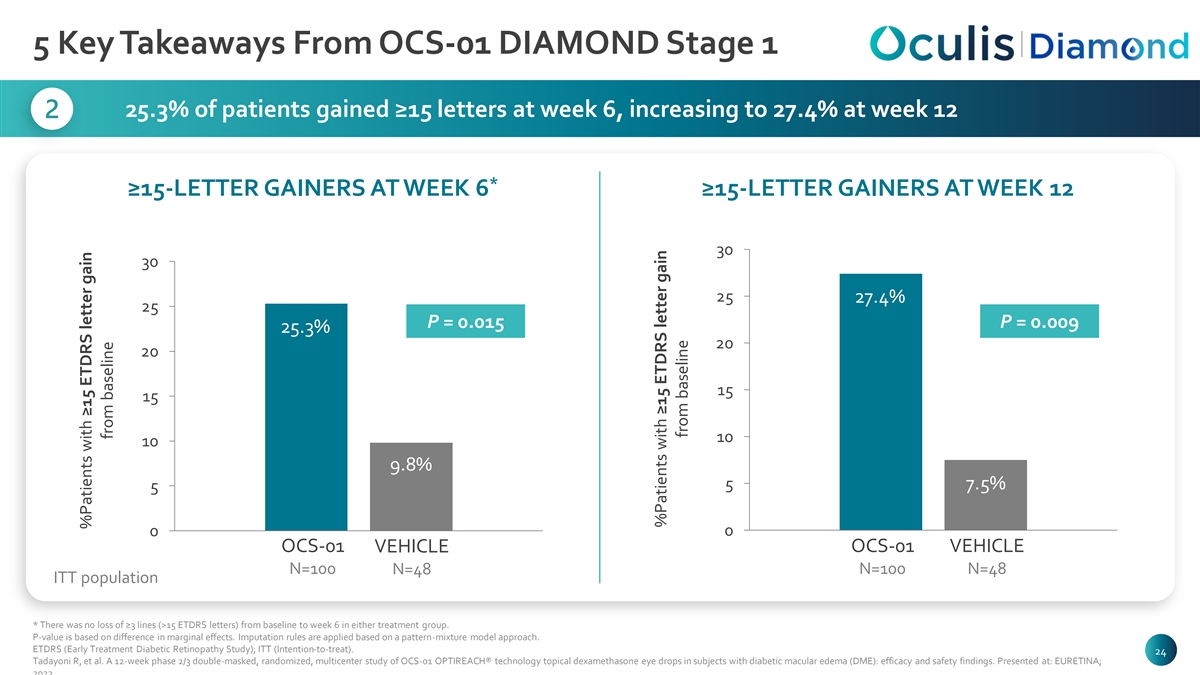
5 Key Takeaways From OCS-01 DIAMOND Stage 1 25.3% of patients gained ≥15 letters at week 6, increasing to 27.4% at week 12 * ≥15-LETTER GAINERS AT WEEK 6 ≥15-LETTER GAINERS AT WEEK 12 30 30 25 27.4% 25 P = 0.015 P = 0.009 25.3% 20 20 15 15 10 10 9.8% 5 7.5% 5 0 0 OCS-01 VEHICLE OCS-01 VEHICLE N=100 N=100 N=48 N=48 ITT population * There was no loss of ≥3 lines (>15 ETDRS letters) from baseline to week 6 in either treatment group. P-value is based on difference in marginal effects. Imputation rules are applied based on a pattern-mixture model approach. ETDRS (Early Treatment Diabetic Retinopathy Study); ITT (Intention-to-treat). 24 24 24 24 Tadayoni R, et al. A 12-week phase 2/3 double-masked, randomized, multicenter study of OCS-01 OPTIREACH® technology topical dexamethasone eye drops in subjects with diabetic macular edema (DME): efficacy and safety findings. Presented at: EURETINA; 2023. %Patients with ≥15 ETDRS letter gain from baseline %Patients with ≥15 ETDRS letter gain from baseline
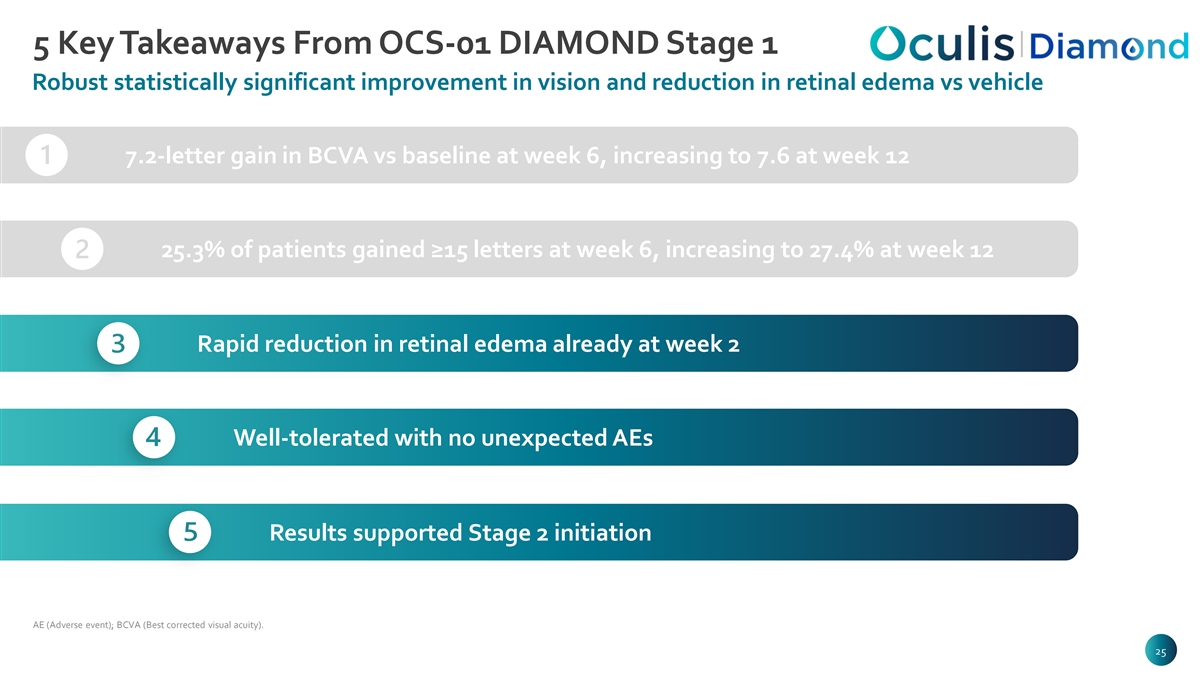
5 Key Takeaways From OCS-01 DIAMOND Stage 1 Robust statistically significant improvement in vision and reduction in retinal edema vs vehicle 7.2-letter gain in BCVA vs baseline at week 6, increasing to 7.6 at week 12 25.3% of patients gained ≥15 letters at week 6, increasing to 27.4% at week 12 Rapid reduction in retinal edema already at week 2 Well-tolerated with no unexpected AEs Results supported Stage 2 initiation AE (Adverse event); BCVA (Best corrected visual acuity). 25 25 25 25
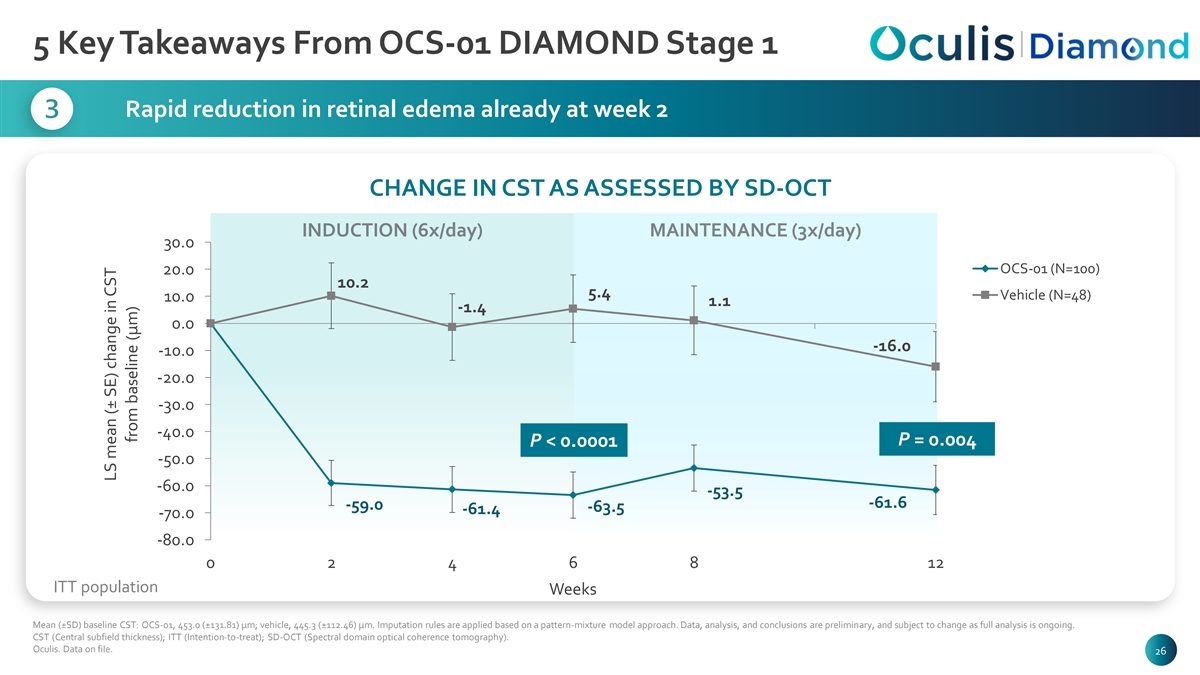
5 Key Takeaways From OCS-01 DIAMOND Stage 1 Rapid reduction in retinal edema already at week 2 CHANGE IN CST AS ASSESSED BY SD-OCT 30.0 OCS-01 (N=100) 20.0 10.2 5.4 Vehicle (N=48) 10.0 1.1 -1.4 0.0 -16.0 -10.0 -20.0 -30.0 -40.0 P = 0.004 P < 0.0001 -50.0 -60.0 -53.5 -61.6 -59.0 -63.5 -61.4 -70.0 -80.0 0 2 4 6 8 10 12 ITT population Weeks Mean (±SD) baseline CST: OCS-01, 453.0 (±131.81) µm; vehicle, 445.3 (±112.46) µm. Imputation rules are applied based on a pattern-mixture model approach. Data, analysis, and conclusions are preliminary, and subject to change as full analysis is ongoing. CST (Central subfield thickness); ITT (Intention-to-treat); SD-OCT (Spectral domain optical coherence tomography). Oculis. Data on file. 26 26 26 26 LS mean (± SE) change in CST from baseline (µm)
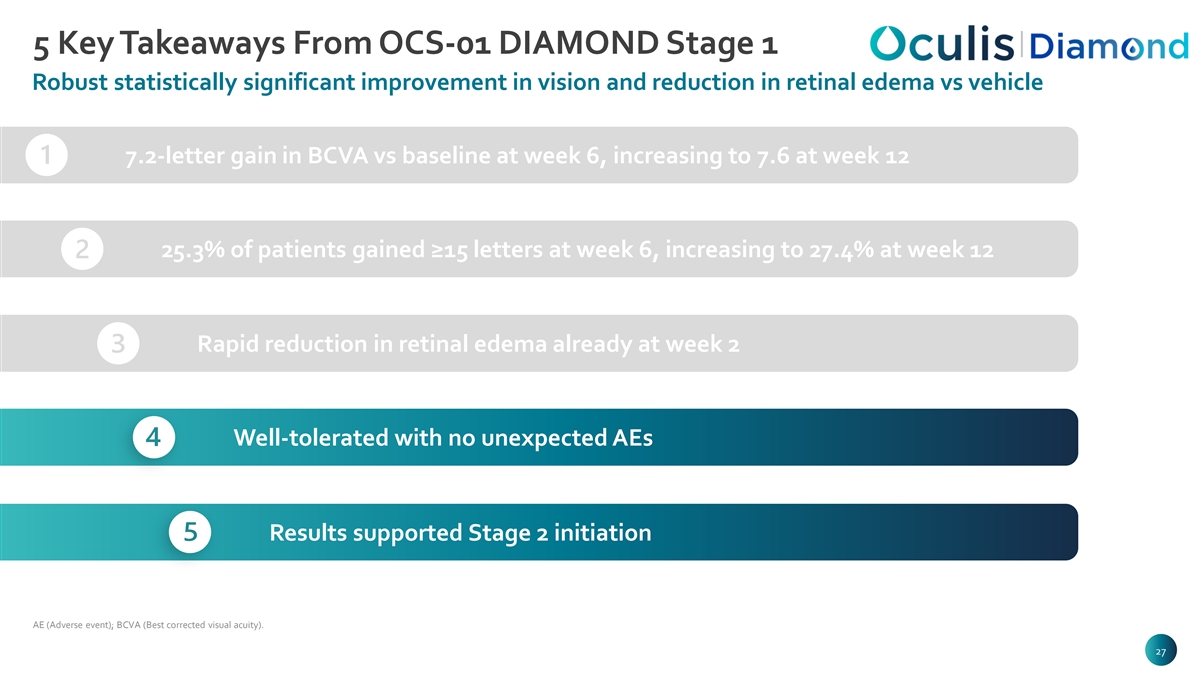
5 Key Takeaways From OCS-01 DIAMOND Stage 1 Robust statistically significant improvement in vision and reduction in retinal edema vs vehicle 7.2-letter gain in BCVA vs baseline at week 6, increasing to 7.6 at week 12 25.3% of patients gained ≥15 letters at week 6, increasing to 27.4% at week 12 Rapid reduction in retinal edema already at week 2 Well-tolerated with no unexpected AEs Results supported Stage 2 initiation AE (Adverse event); BCVA (Best corrected visual acuity). 27 27 27 27
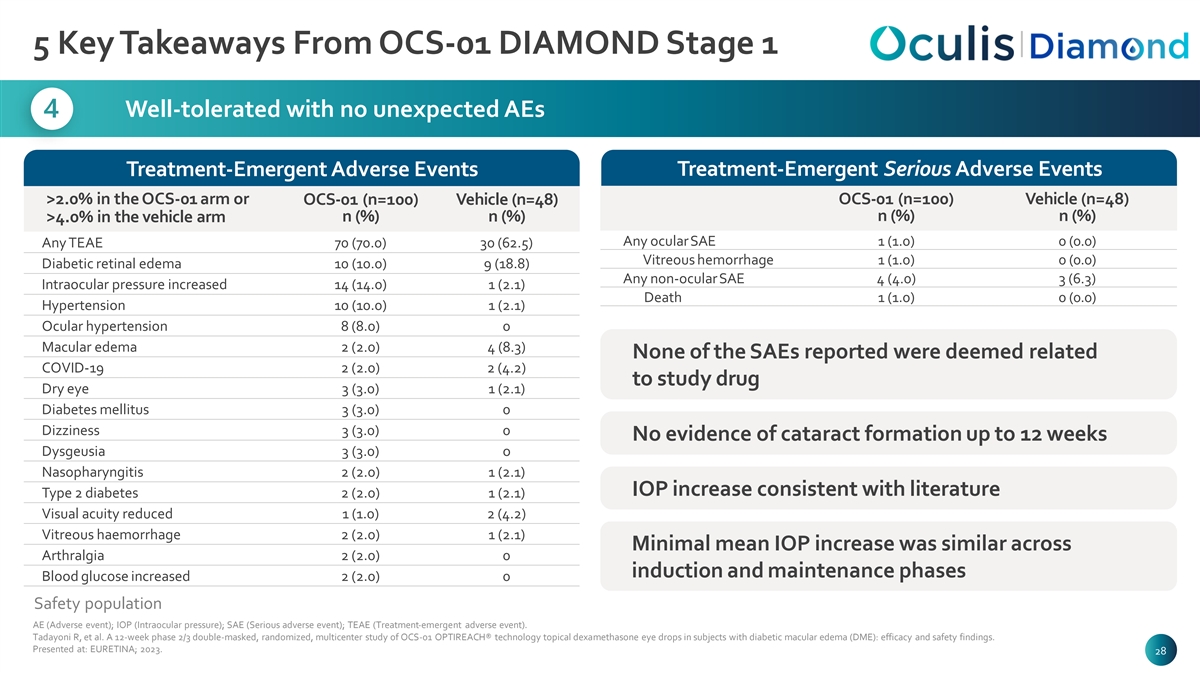
5 Key Takeaways From OCS-01 DIAMOND Stage 1 Well-tolerated with no unexpected AEs Treatment-Emergent Adverse Events Treatment-Emergent Serious Adverse Events >2.0% in the OCS-01 arm or OCS-01 (n=100) Vehicle (n=48) OCS-01 (n=100) Vehicle (n=48) n (%) n (%) n (%) n (%) >4.0% in the vehicle arm Any ocular SAE 1 (1.0) 0 (0.0) Any TEAE 70 (70.0) 30 (62.5) Vitreous hemorrhage 1 (1.0) 0 (0.0) Diabetic retinal edema 10 (10.0) 9 (18.8) Any non-ocular SAE 4 (4.0) 3 (6.3) Intraocular pressure increased 14 (14.0) 1 (2.1) Death 1 (1.0) 0 (0.0) Hypertension 10 (10.0) 1 (2.1) Ocular hypertension 8 (8.0) 0 Macular edema 2 (2.0) 4 (8.3) None of the SAEs reported were deemed related COVID-19 2 (2.0) 2 (4.2) to study drug Dry eye 3 (3.0) 1 (2.1) Diabetes mellitus 3 (3.0) 0 Dizziness 3 (3.0) 0 No evidence of cataract formation up to 12 weeks Dysgeusia 3 (3.0) o Nasopharyngitis 2 (2.0) 1 (2.1) IOP increase consistent with literature Type 2 diabetes 2 (2.0) 1 (2.1) Visual acuity reduced 1 (1.0) 2 (4.2) Vitreous haemorrhage 2 (2.0) 1 (2.1) Minimal mean IOP increase was similar across Arthralgia 2 (2.0) 0 induction and maintenance phases Blood glucose increased 2 (2.0) 0 Safety population AE (Adverse event); IOP (Intraocular pressure); SAE (Serious adverse event); TEAE (Treatment-emergent adverse event). Tadayoni R, et al. A 12-week phase 2/3 double-masked, randomized, multicenter study of OCS-01 OPTIREACH® technology topical dexamethasone eye drops in subjects with diabetic macular edema (DME): efficacy and safety findings. Presented at: EURETINA; 2023. 28 28 28 28
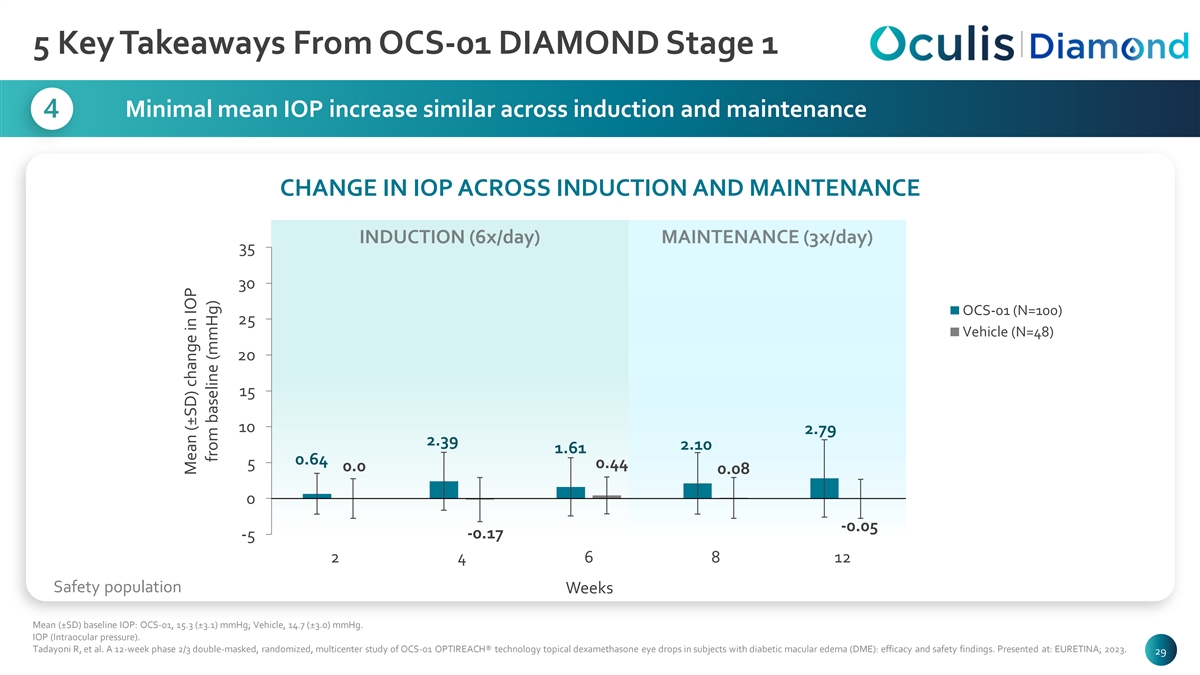
5 Key Takeaways From OCS-01 DIAMOND Stage 1 Minimal mean IOP increase similar across induction and maintenance CHANGE IN IOP ACROSS INDUCTION AND MAINTENANCE 35 30 OCS-01 (N=100) 25 Vehicle (N=48) 20 15 10 2.79 2.39 2.10 1.61 0.64 5 0.44 0.0 0.08 0 -0.05 -0.17 -5 2 4 6 8 12 Safety population Weeks Mean (±SD) baseline IOP: OCS-01, 15.3 (±3.1) mmHg; Vehicle, 14.7 (±3.0) mmHg. IOP (Intraocular pressure). Tadayoni R, et al. A 12-week phase 2/3 double-masked, randomized, multicenter study of OCS-01 OPTIREACH® technology topical dexamethasone eye drops in subjects with diabetic macular edema (DME): efficacy and safety findings. Presented at: EURETINA; 2023. 29 29 29 29 Mean (±SD) change in IOP from baseline (mmHg)
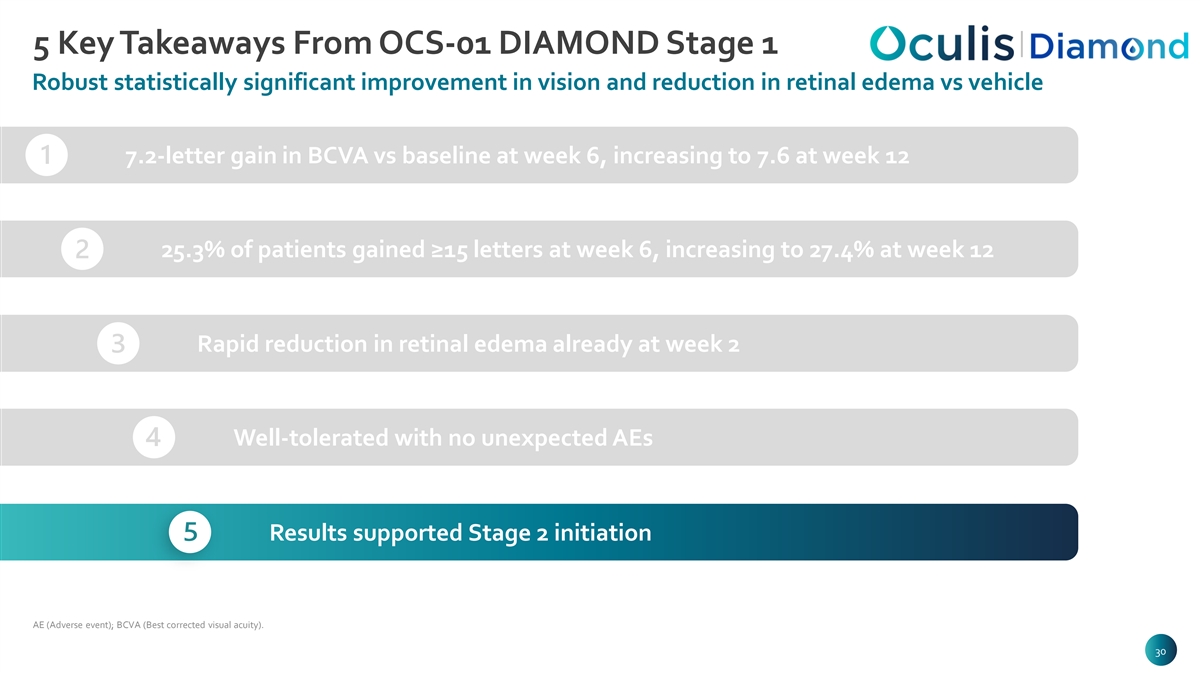
5 Key Takeaways From OCS-01 DIAMOND Stage 1 Robust statistically significant improvement in vision and reduction in retinal edema vs vehicle 7.2-letter gain in BCVA vs baseline at week 6, increasing to 7.6 at week 12 25.3% of patients gained ≥15 letters at week 6, increasing to 27.4% at week 12 Rapid reduction in retinal edema already at week 2 Well-tolerated with no unexpected AEs Results supported Stage 2 initiation AE (Adverse event); BCVA (Best corrected visual acuity). 30 30 30 30
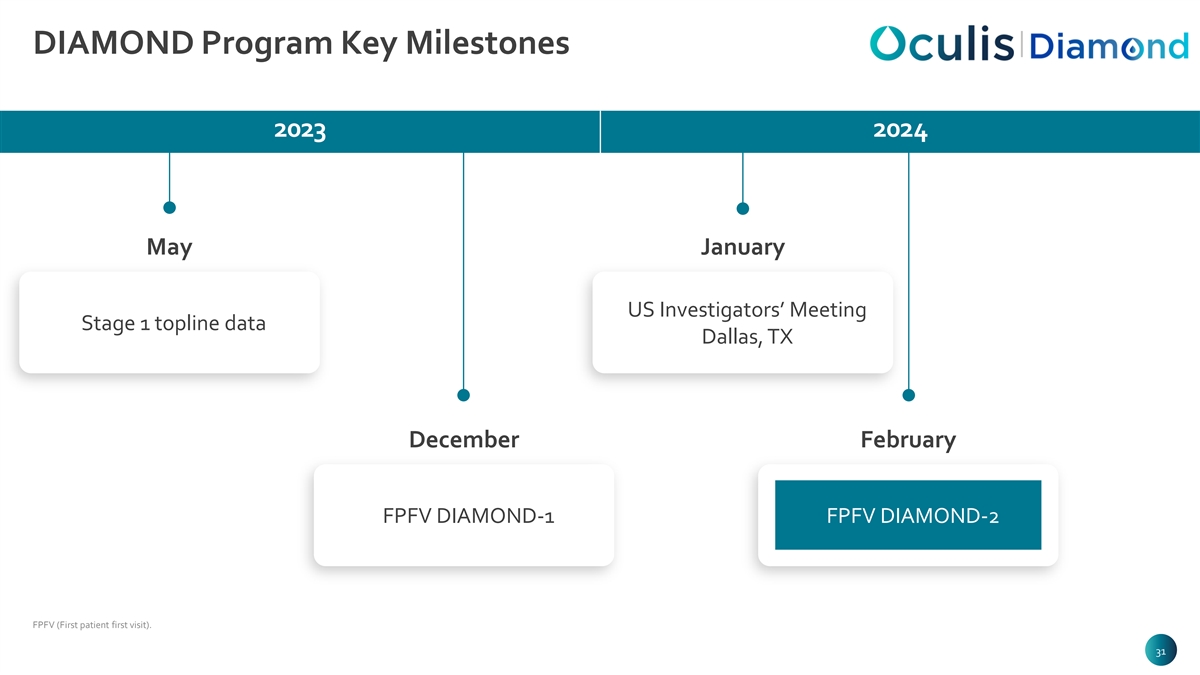
DIAMOND Program Key Milestones 2023 2024 May January US Investigators’ Meeting Stage 1 topline data Dallas, TX December February FPFV DIAMOND-1 FPFV DIAMOND-2 FPFV (First patient first visit). 31 31 31 31
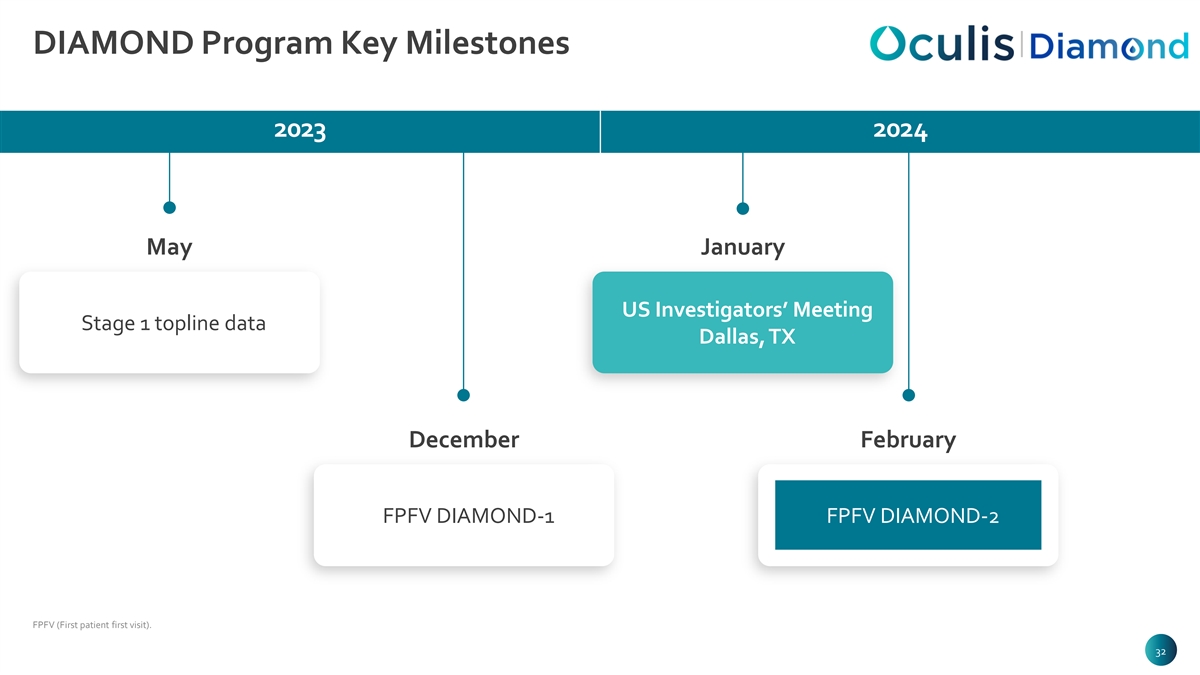
DIAMOND Program Key Milestones 2023 2024 May January US Investigators’ Meeting Stage 1 topline data Dallas, TX December February FPFV DIAMOND-1 FPFV DIAMOND-2 FPFV (First patient first visit). 32 32 32 32
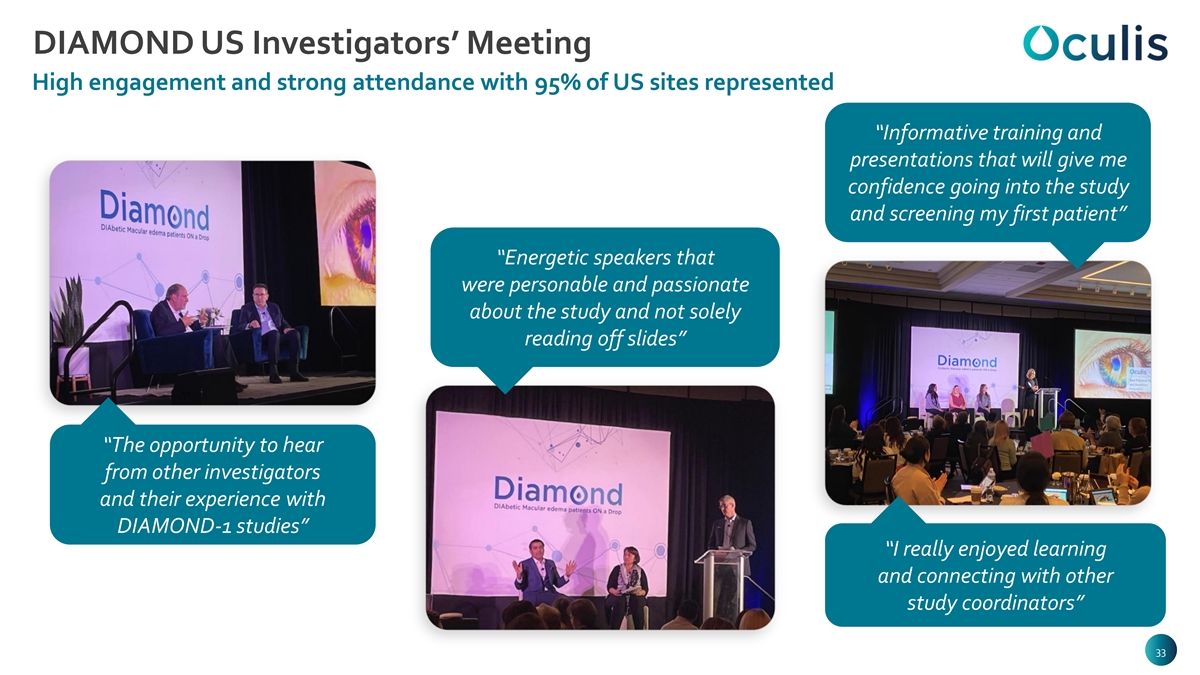
DIAMOND US Investigators’ Meeting High engagement and strong attendance with 95% of US sites represented “Informative training and presentations that will give me confidence going into the study and screening my first patient” “Energetic speakers that were personable and passionate about the study and not solely reading off slides” “The opportunity to hear from other investigators and their experience with DIAMOND-1 studies” “I really enjoyed learning and connecting with other study coordinators” 33 33 33 33
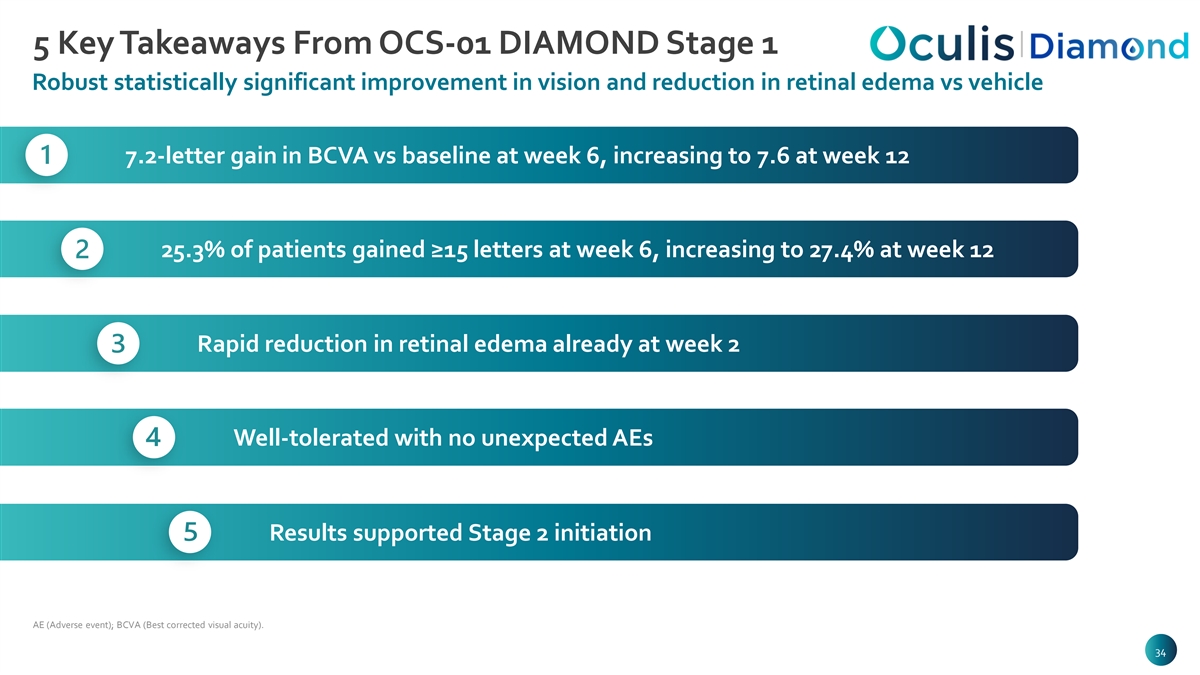
5 Key Takeaways From OCS-01 DIAMOND Stage 1 Robust statistically significant improvement in vision and reduction in retinal edema vs vehicle 7.2-letter gain in BCVA vs baseline at week 6, increasing to 7.6 at week 12 25.3% of patients gained ≥15 letters at week 6, increasing to 27.4% at week 12 Rapid reduction in retinal edema already at week 2 Well-tolerated with no unexpected AEs Results supported Stage 2 initiation AE (Adverse event); BCVA (Best corrected visual acuity). 34 34 34 34
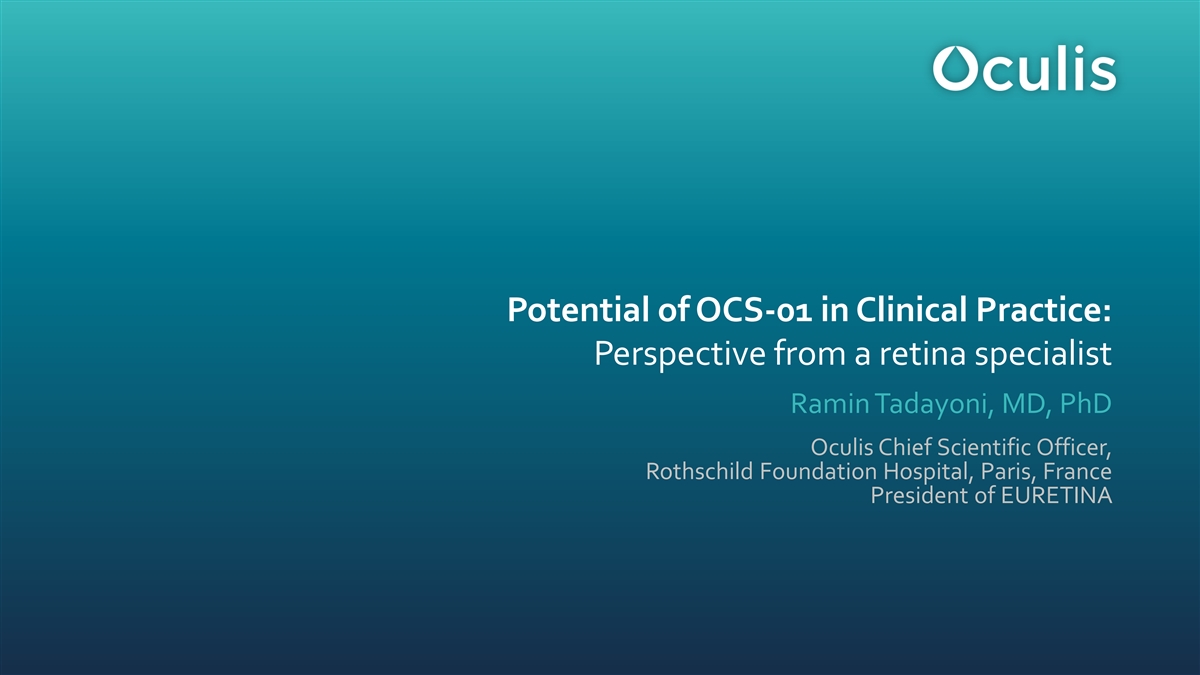
Potential of OCS-01 in Clinical Practice: Perspective from a retina specialist Ramin Tadayoni, MD, PhD Oculis Chief Scientific Officer, Rothschild Foundation Hospital, Paris, France President of EURETINA 35 35
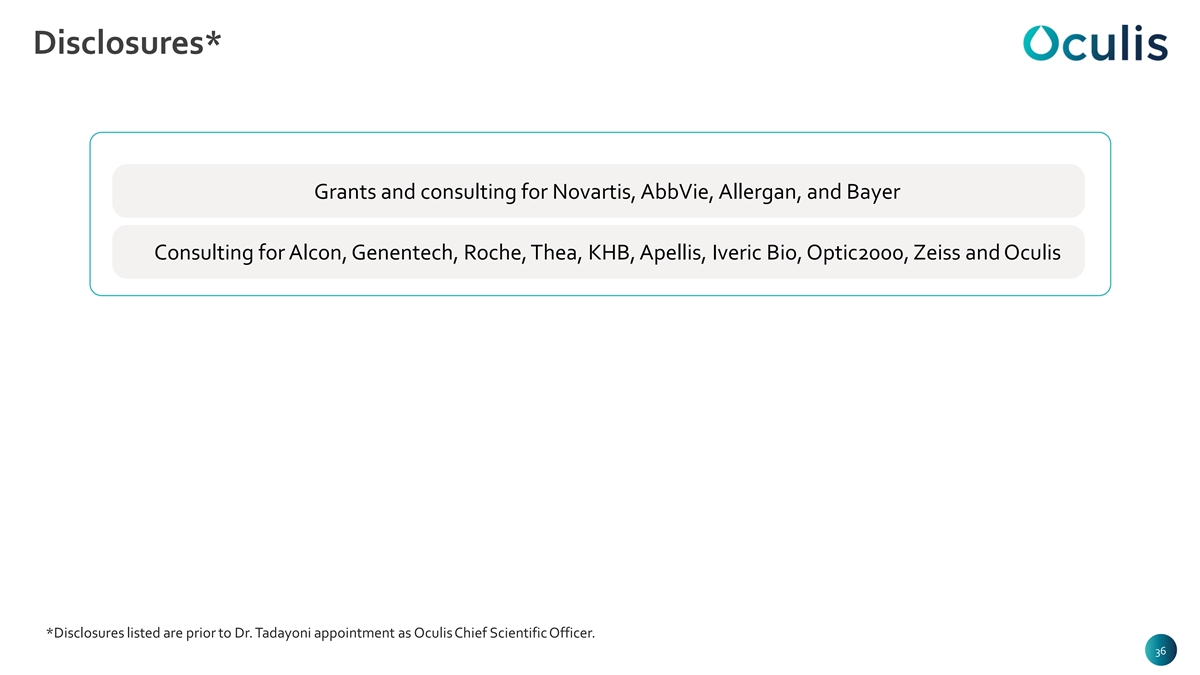
Disclosures* Grants and consulting for Novartis, AbbVie, Allergan, and Bayer Consulting for Alcon, Genentech, Roche, Thea, KHB, Apellis, Iveric Bio, Optic2000, Zeiss and Oculis *Disclosures listed are prior to Dr. Tadayoni appointment as Oculis Chief Scientific Officer. 36 36 36 36
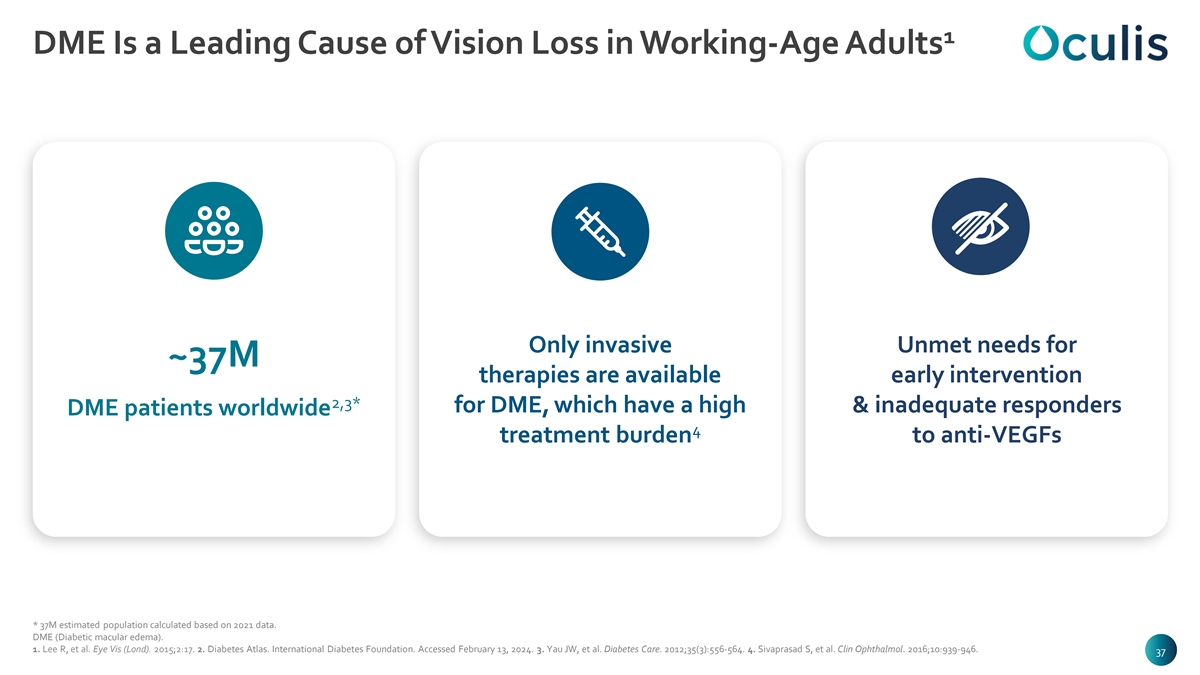
1 DME Is a Leading Cause of Vision Loss in Working-Age Adults Only invasive Unmet needs for ~37M therapies are available early intervention 2,3* for DME, which have a high & inadequate responders DME patients worldwide 4 treatment burden to anti-VEGFs * 37M estimated population calculated based on 2021 data. DME (Diabetic macular edema). 1. Lee R, et al. Eye Vis (Lond). 2015;2:17. 2. Diabetes Atlas. International Diabetes Foundation. Accessed February 13, 2024. 3. Yau JW, et al. Diabetes Care. 2012;35(3):556-564. 4. Sivaprasad S, et al. Clin Ophthalmol. 2016;10:939-946. 37 37 37 37
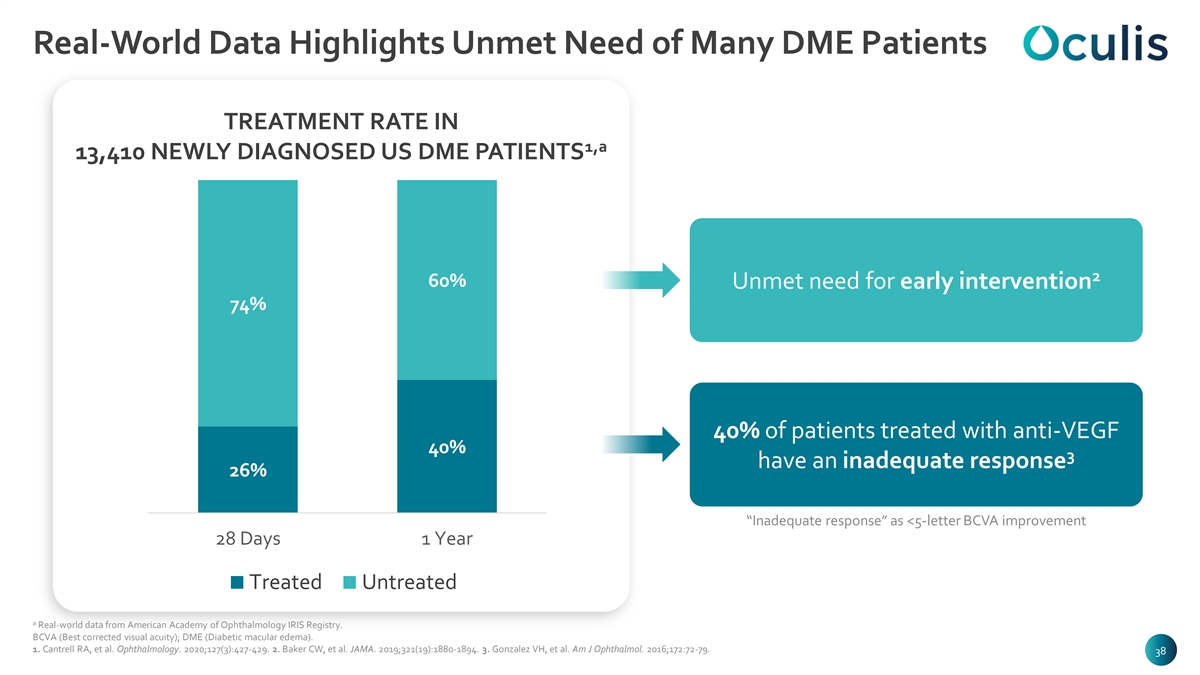
Real-World Data Highlights Unmet Need of Many DME Patients TREATMENT RATE IN 1,a 13,410 NEWLY DIAGNOSED US DME PATIENTS 2 60% Unmet need for early intervention 74% 40% of patients treated with anti-VEGF 40% 3 have an inadequate response 26% “Inadequate response” as <5-letter BCVA improvement 28 Days 1 Year Treated Untreated a Real-world data from American Academy of Ophthalmology IRIS Registry. BCVA (Best corrected visual acuity); DME (Diabetic macular edema). 1. Cantrell RA, et al. Ophthalmology. 2020;127(3):427-429. 2. Baker CW, et al. JAMA. 2019;321(19):1880-1894. 3. Gonzalez VH, et al. Am J Ophthalmol. 2016;172:72-79. 38 38 38 38
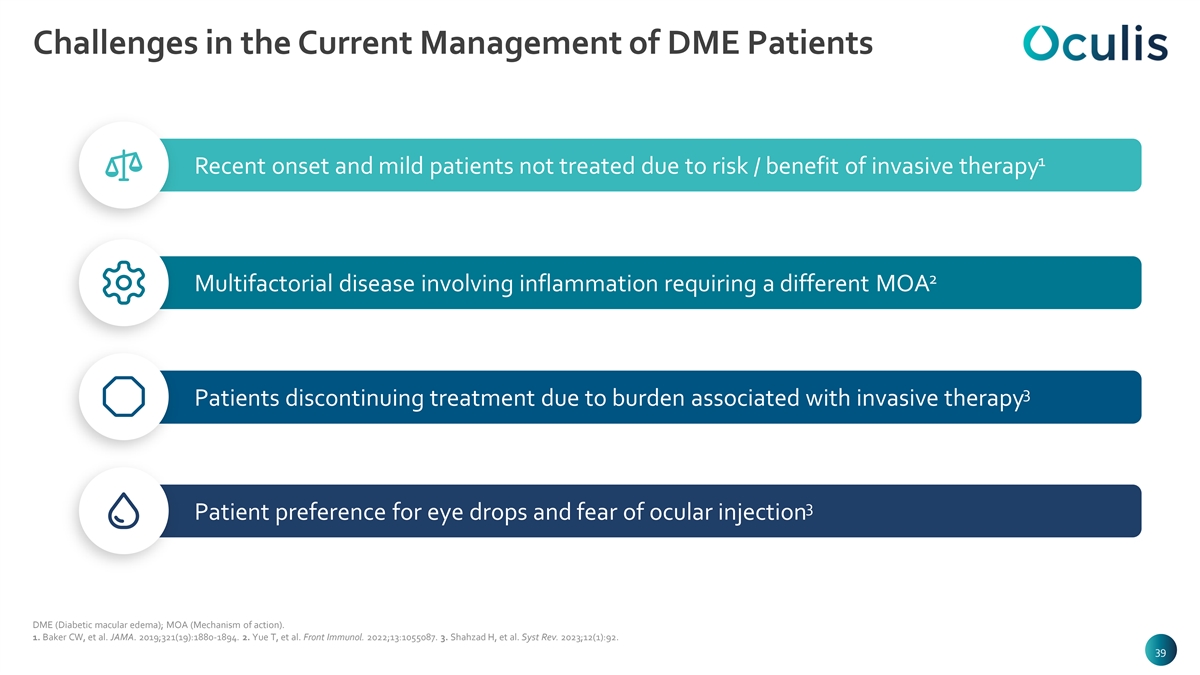
Challenges in the Current Management of DME Patients 1 Recent onset and mild patients not treated due to risk / benefit of invasive therapy 2 Multifactorial disease involving inflammation requiring a different MOA 3 Patients discontinuing treatment due to burden associated with invasive therapy 3 Patient preference for eye drops and fear of ocular injection DME (Diabetic macular edema); MOA (Mechanism of action). 1. Baker CW, et al. JAMA. 2019;321(19):1880-1894. 2. Yue T, et al. Front Immunol. 2022;13:1055087. 3. Shahzad H, et al. Syst Rev. 2023;12(1):92. 39 39 39 39
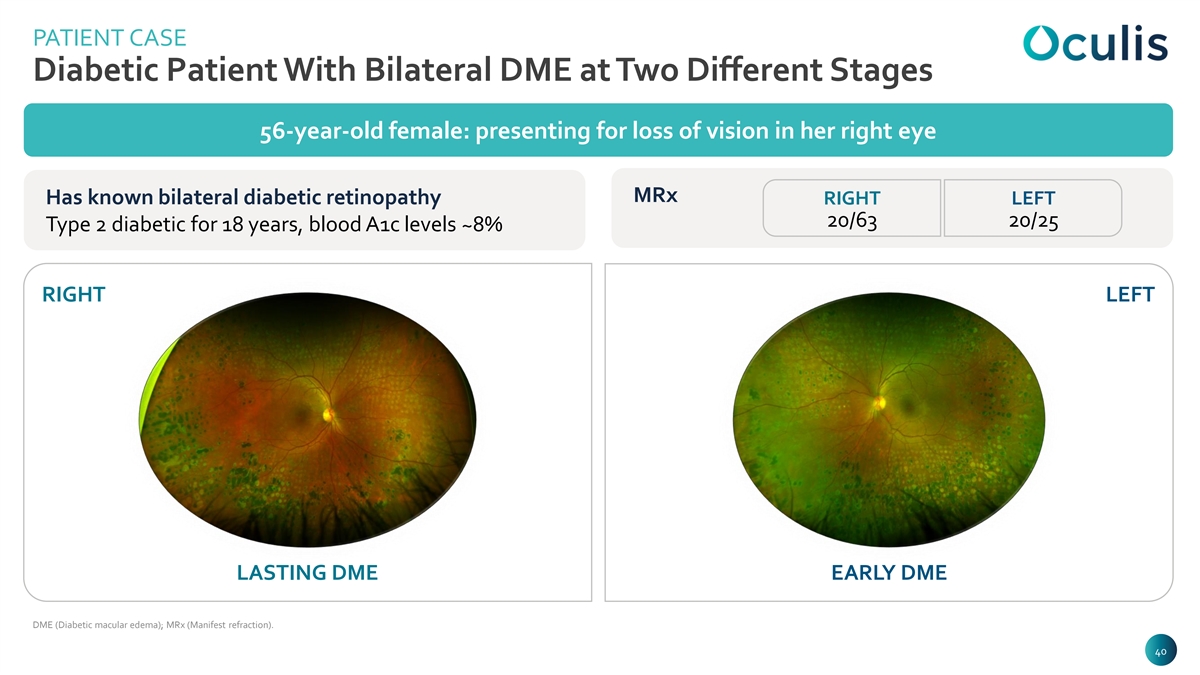
PATIENT CASE Diabetic Patient With Bilateral DME at Two Different Stages 56-year-old female: presenting for loss of vision in her right eye MRx Has known bilateral diabetic retinopathy RIGHT LEFT 20/63 20/25 Type 2 diabetic for 18 years, blood A1c levels ~8% RIGHT LEFT LASTING DME EARLY DME DME (Diabetic macular edema); MRx (Manifest refraction). 40 40 40 40
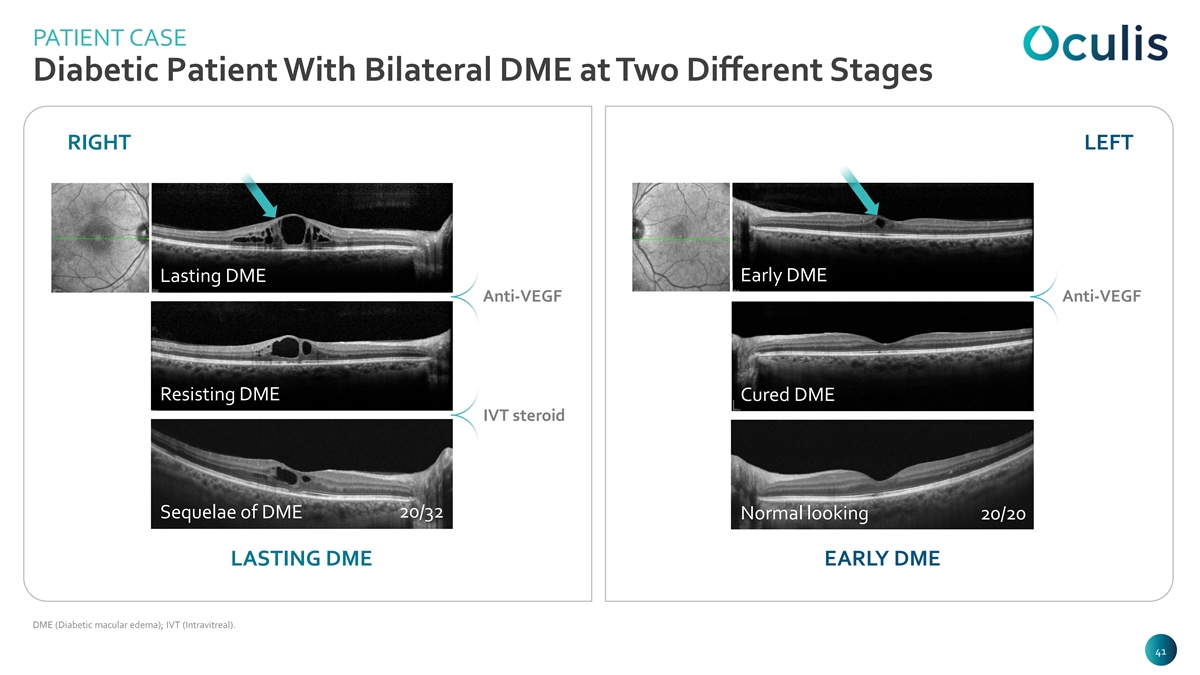
PATIENT CASE Diabetic Patient With Bilateral DME at Two Different Stages RIGHT LEFT Early DME Lasting DME Anti-VEGF Anti-VEGF Resisting DME Cured DME IVT steroid 20/32 Sequelae of DME Normal looking 20/20 LASTING DME EARLY DME DME (Diabetic macular edema); IVT (Intravitreal). 41 41 41 41
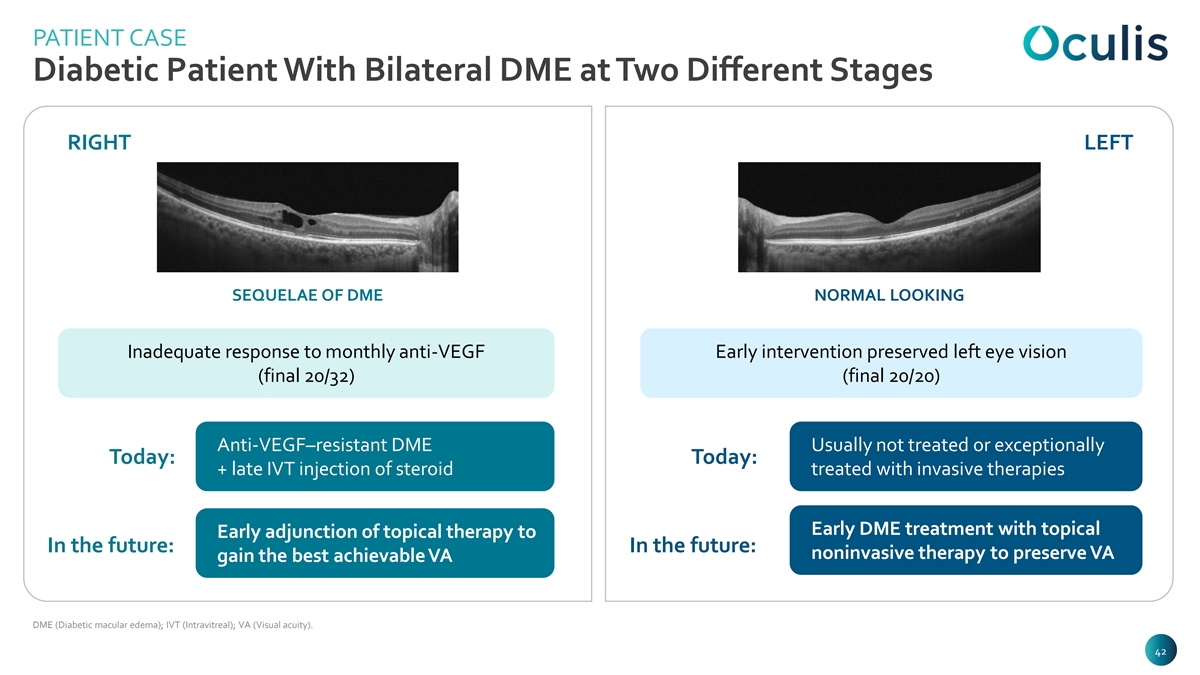
PATIENT CASE Diabetic Patient With Bilateral DME at Two Different Stages RIGHT LEFT SEQUELAE OF DME NORMAL LOOKING Inadequate response to monthly anti-VEGF Early intervention preserved left eye vision (final 20/32) (final 20/20) Anti-VEGF–resistant DME Usually not treated or exceptionally Today: Today: + late IVT injection of steroid treated with invasive therapies Early DME treatment with topical Early adjunction of topical therapy to In the future: In the future: noninvasive therapy to preserve VA gain the best achievable VA DME (Diabetic macular edema); IVT (Intravitreal); VA (Visual acuity). 42 42 42 42
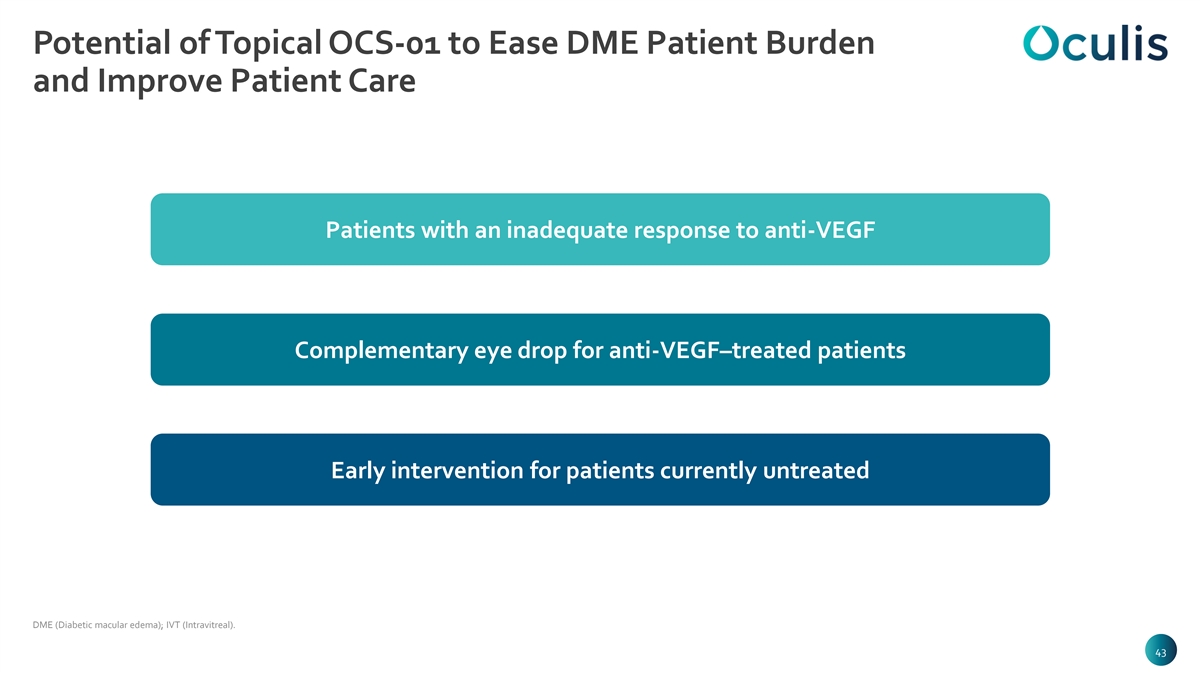
Potential of Topical OCS-01 to Ease DME Patient Burden and Improve Patient Care Patients with an inadequate response to anti-VEGF Complementary eye drop for anti-VEGF–treated patients Early intervention for patients currently untreated DME (Diabetic macular edema); IVT (Intravitreal). 43 43 43 43
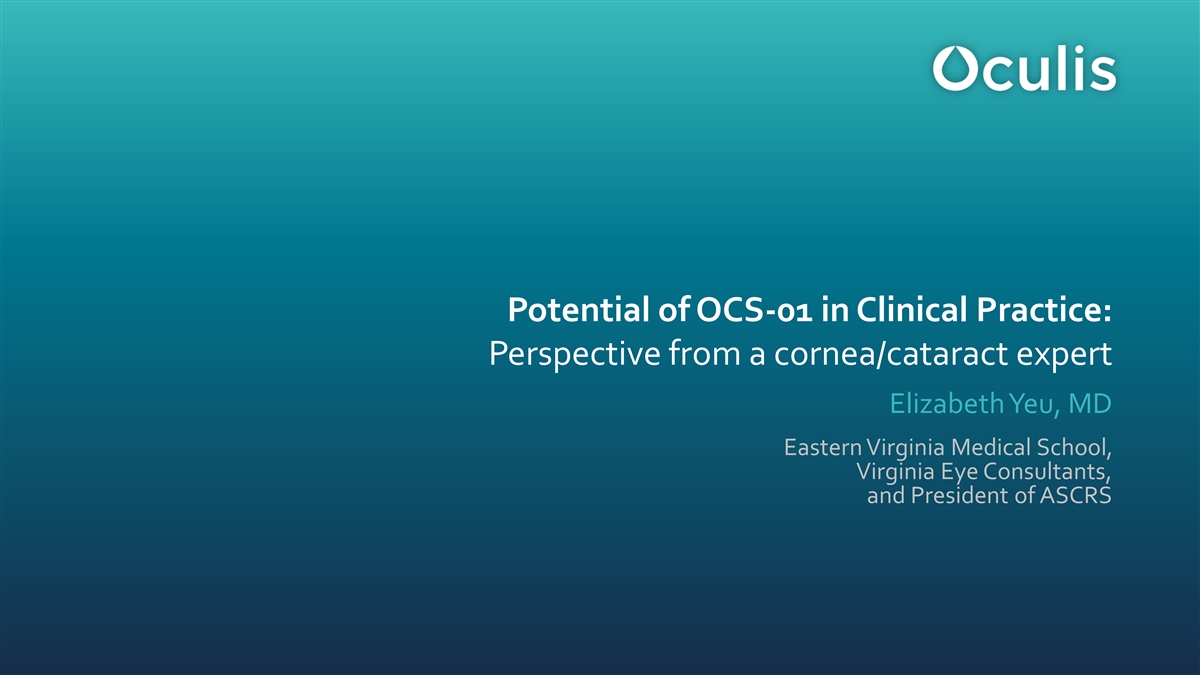
Potential of OCS-01 in Clinical Practice: Perspective from a cornea/cataract expert Elizabeth Yeu, MD Eastern Virginia Medical School, Virginia Eye Consultants, and President of ASCRS 44 44
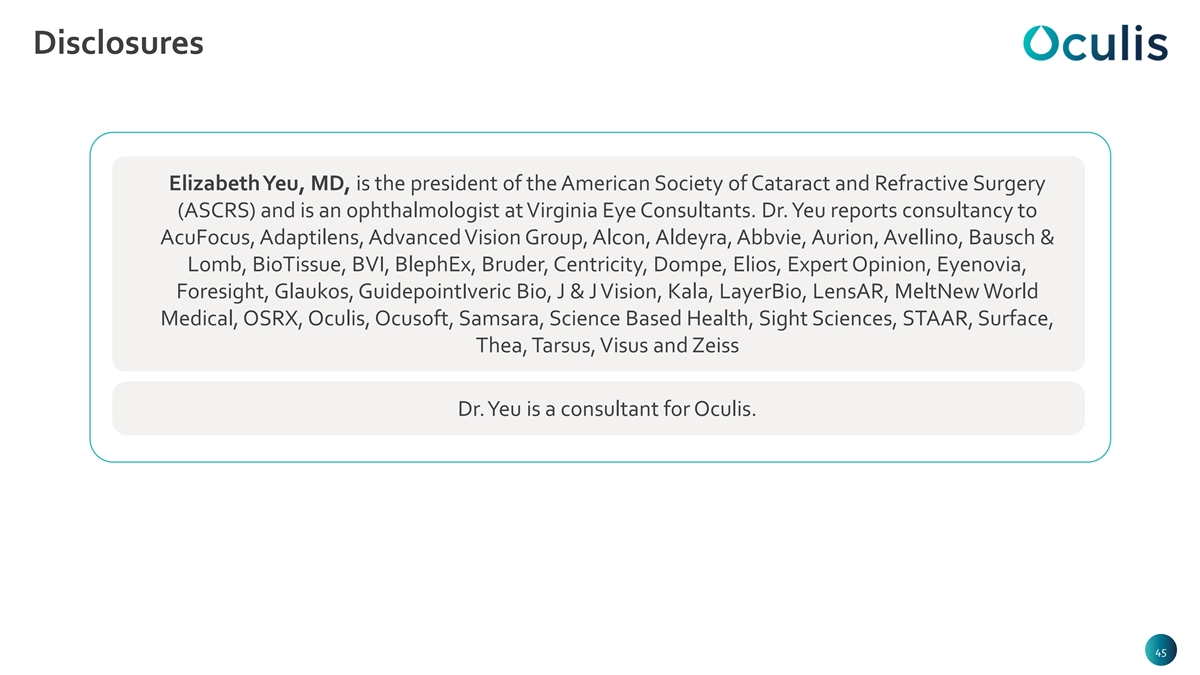
Disclosures Elizabeth Yeu, MD, is the president of the American Society of Cataract and Refractive Surgery (ASCRS) and is an ophthalmologist at Virginia Eye Consultants. Dr. Yeu reports consultancy to AcuFocus, Adaptilens, Advanced Vision Group, Alcon, Aldeyra, Abbvie, Aurion, Avellino, Bausch & Lomb, BioTissue, BVI, BlephEx, Bruder, Centricity, Dompe, Elios, Expert Opinion, Eyenovia, Foresight, Glaukos, GuidepointIveric Bio, J & J Vision, Kala, LayerBio, LensAR, MeltNew World Medical, OSRX, Oculis, Ocusoft, Samsara, Science Based Health, Sight Sciences, STAAR, Surface, Thea, Tarsus, Visus and Zeiss Dr. Yeu is a consultant for Oculis. 45 45 45 45
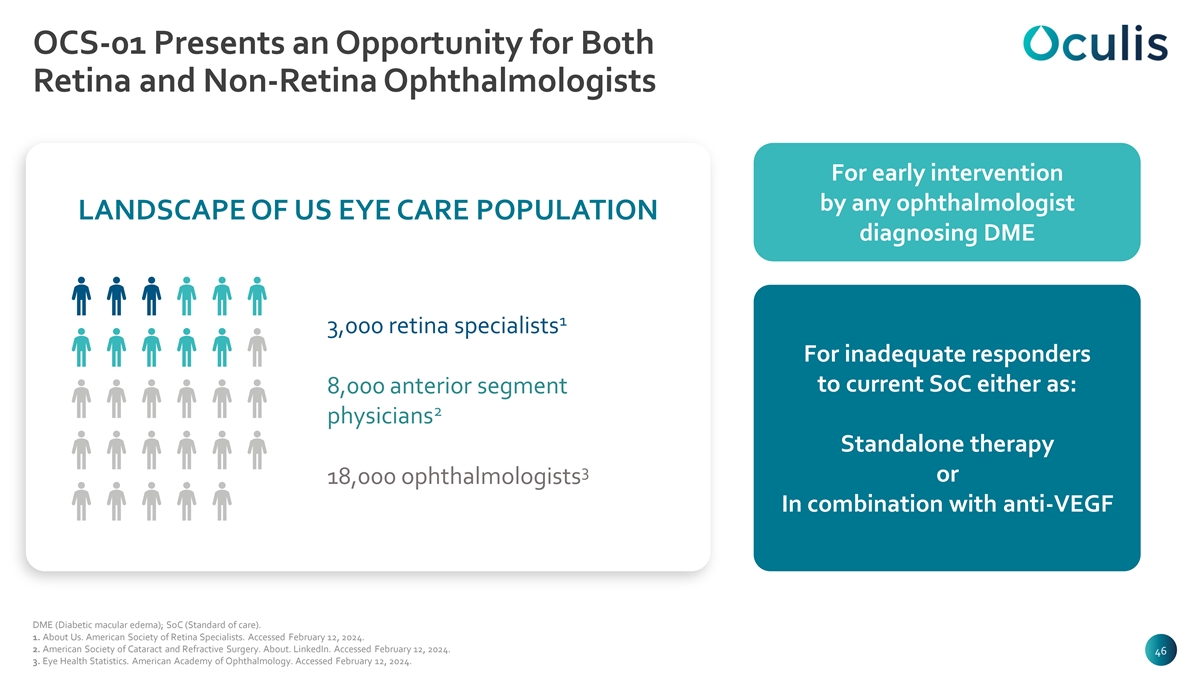
OCS-01 Presents an Opportunity for Both Retina and Non-Retina Ophthalmologists For early intervention by any ophthalmologist LANDSCAPE OF US EYE CARE POPULATION diagnosing DME 1 3,000 retina specialists For inadequate responders to current SoC either as: 8,000 anterior segment 2 physicians Standalone therapy 3 or 18,000 ophthalmologists In combination with anti-VEGF DME (Diabetic macular edema); SoC (Standard of care). 1. About Us. American Society of Retina Specialists. Accessed February 12, 2024. 2. American Society of Cataract and Refractive Surgery. About. LinkedIn. Accessed February 12, 2024. 46 46 46 46 3. Eye Health Statistics. American Academy of Ophthalmology. Accessed February 12, 2024.
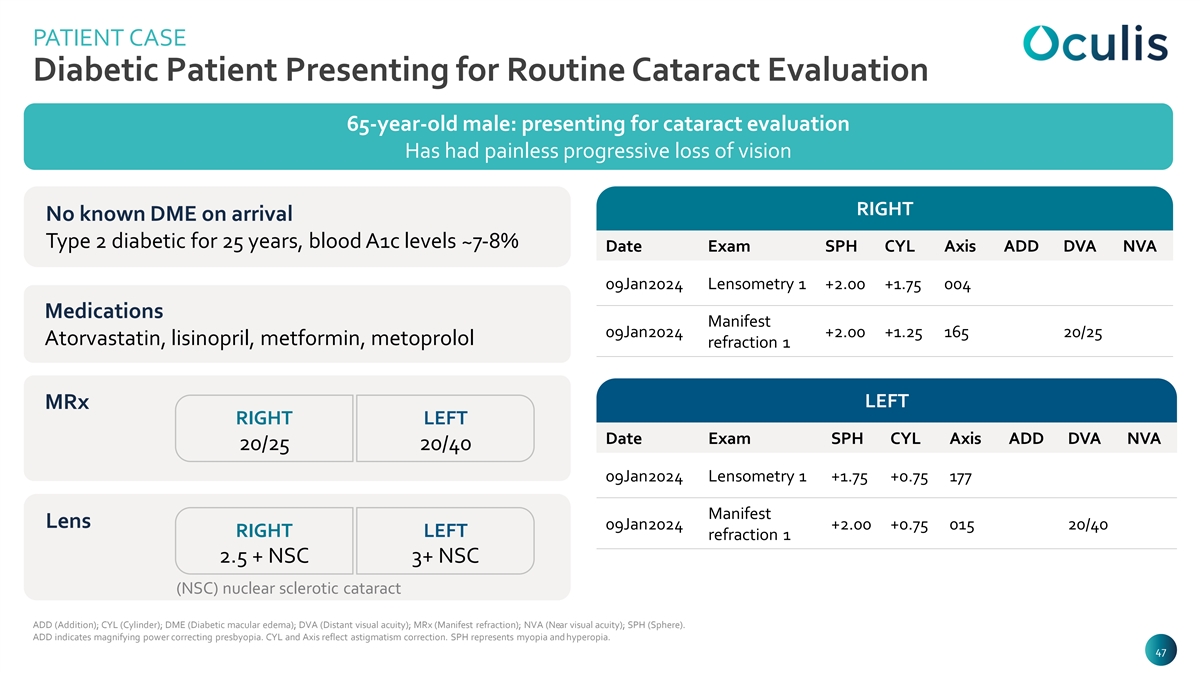
PATIENT CASE Diabetic Patient Presenting for Routine Cataract Evaluation 65-year-old male: presenting for cataract evaluation Has had painless progressive loss of vision RIGHT No known DME on arrival Type 2 diabetic for 25 years, blood A1c levels ~7-8% Date Exam SPH CYL Axis ADD DVA NVA 09Jan2024 Lensometry 1 +2.00 +1.75 004 Medications Manifest 09Jan2024 +2.00 +1.25 165 20/25 Atorvastatin, lisinopril, metformin, metoprolol refraction 1 LEFT MRx RIGHT LEFT Date Exam SPH CYL Axis ADD DVA NVA 20/25 20/40 09Jan2024 Lensometry 1 +1.75 +0.75 177 Manifest Lens 09Jan2024 +2.00 +0.75 015 20/40 RIGHT LEFT refraction 1 2.5 + NSC 3+ NSC (NSC) nuclear sclerotic cataract ADD (Addition); CYL (Cylinder); DME (Diabetic macular edema); DVA (Distant visual acuity); MRx (Manifest refraction); NVA (Near visual acuity); SPH (Sphere). ADD indicates magnifying power correcting presbyopia. CYL and Axis reflect astigmatism correction. SPH represents myopia and hyperopia. 47 47 47 47
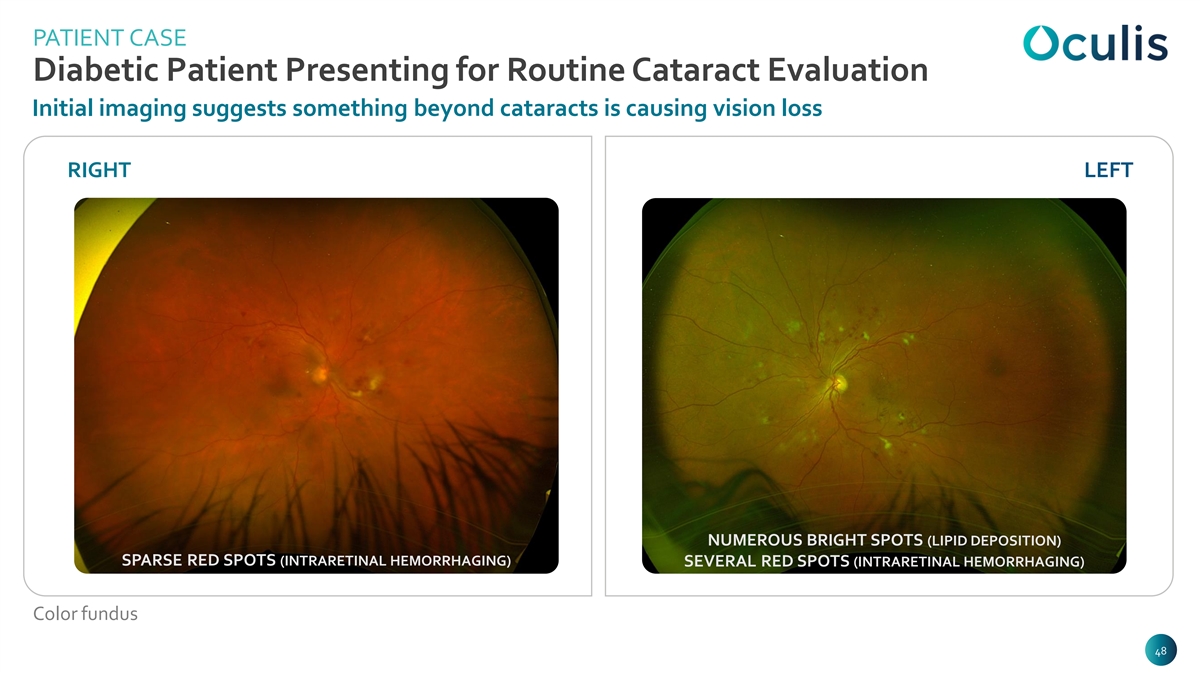
PATIENT CASE Diabetic Patient Presenting for Routine Cataract Evaluation Initial imaging suggests something beyond cataracts is causing vision loss RIGHT LEFT NUMEROUS BRIGHT SPOTS (LIPID DEPOSITION) SPARSE RED SPOTS (INTRARETINAL HEMORRHAGING) SEVERAL RED SPOTS (INTRARETINAL HEMORRHAGING) Color fundus 48 48 48 48
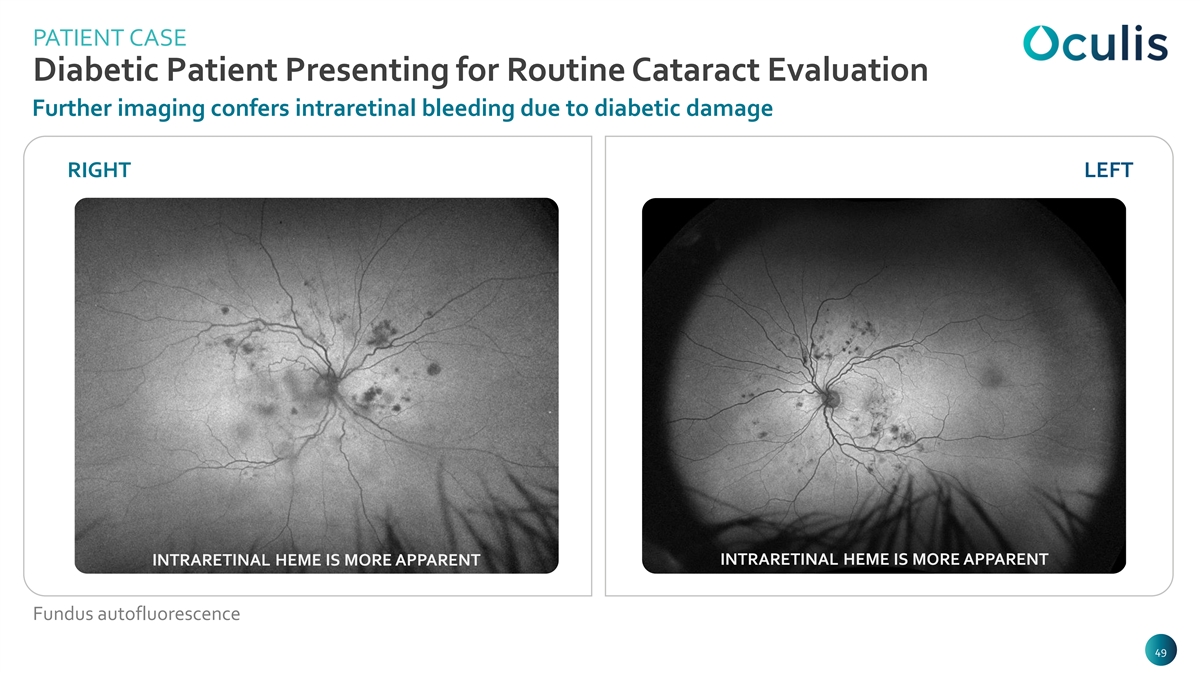
PATIENT CASE Diabetic Patient Presenting for Routine Cataract Evaluation Further imaging confers intraretinal bleeding due to diabetic damage RIGHT LEFT INTRARETINAL HEME IS MORE APPARENT INTRARETINAL HEME IS MORE APPARENT Fundus autofluorescence 49 49 49 49
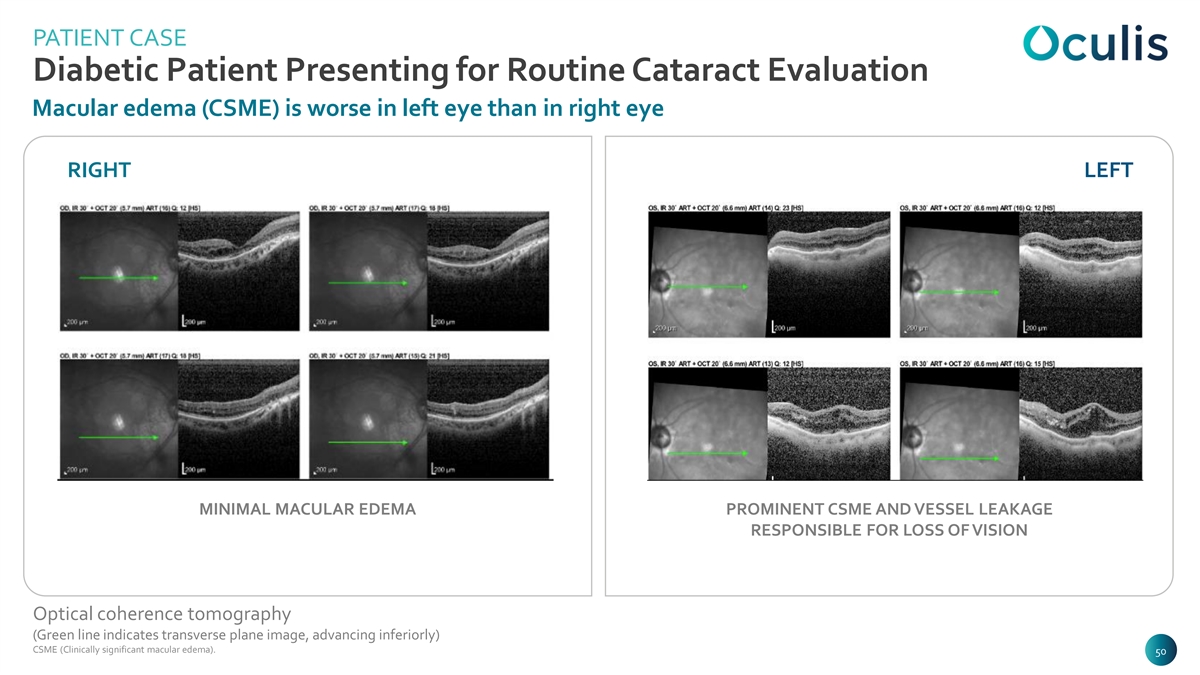
PATIENT CASE Diabetic Patient Presenting for Routine Cataract Evaluation Macular edema (CSME) is worse in left eye than in right eye RIGHT LEFT MINIMAL MACULAR EDEMA PROMINENT CSME AND VESSEL LEAKAGE RESPONSIBLE FOR LOSS OF VISION Optical coherence tomography (Green line indicates transverse plane image, advancing inferiorly) CSME (Clinically significant macular edema). 50 50 50 50
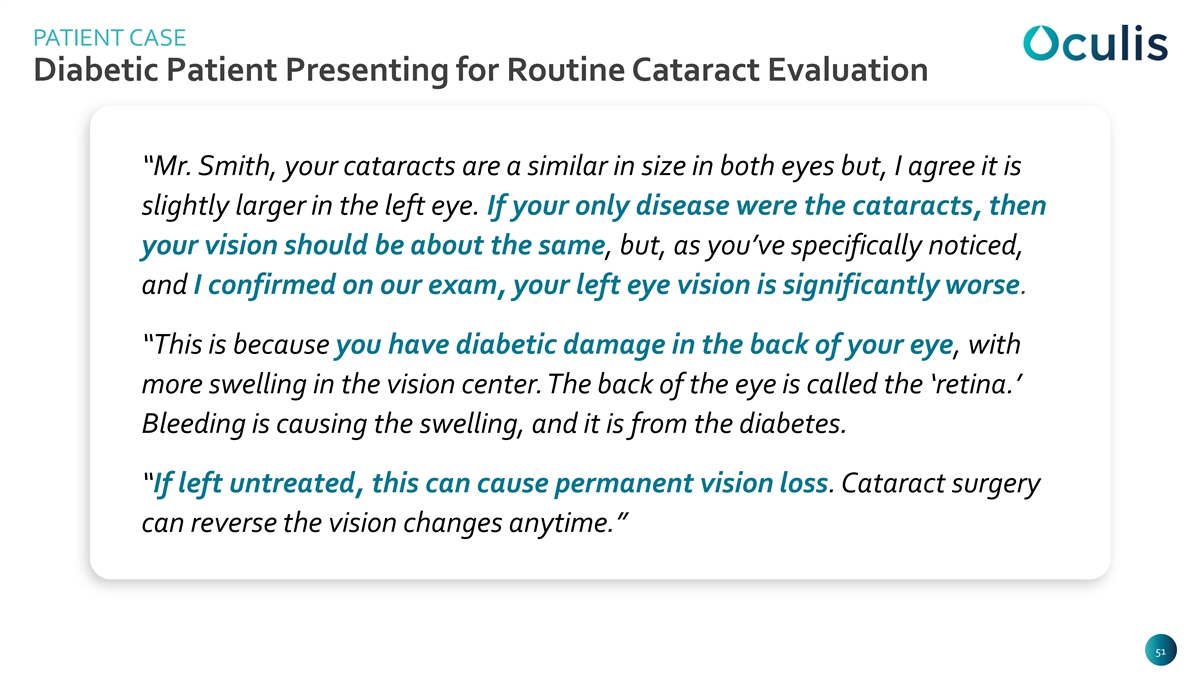
PATIENT CASE Diabetic Patient Presenting for Routine Cataract Evaluation “Mr. Smith, your cataracts are a similar in size in both eyes but, I agree it is slightly larger in the left eye. If your only disease were the cataracts, then your vision should be about the same, but, as you’ve specifically noticed, and I confirmed on our exam, your left eye vision is significantly worse. “This is because you have diabetic damage in the back of your eye, with more swelling in the vision center. The back of the eye is called the ‘retina.’ Bleeding is causing the swelling, and it is from the diabetes. “If left untreated, this can cause permanent vision loss. Cataract surgery can reverse the vision changes anytime.” 51 51 51 51
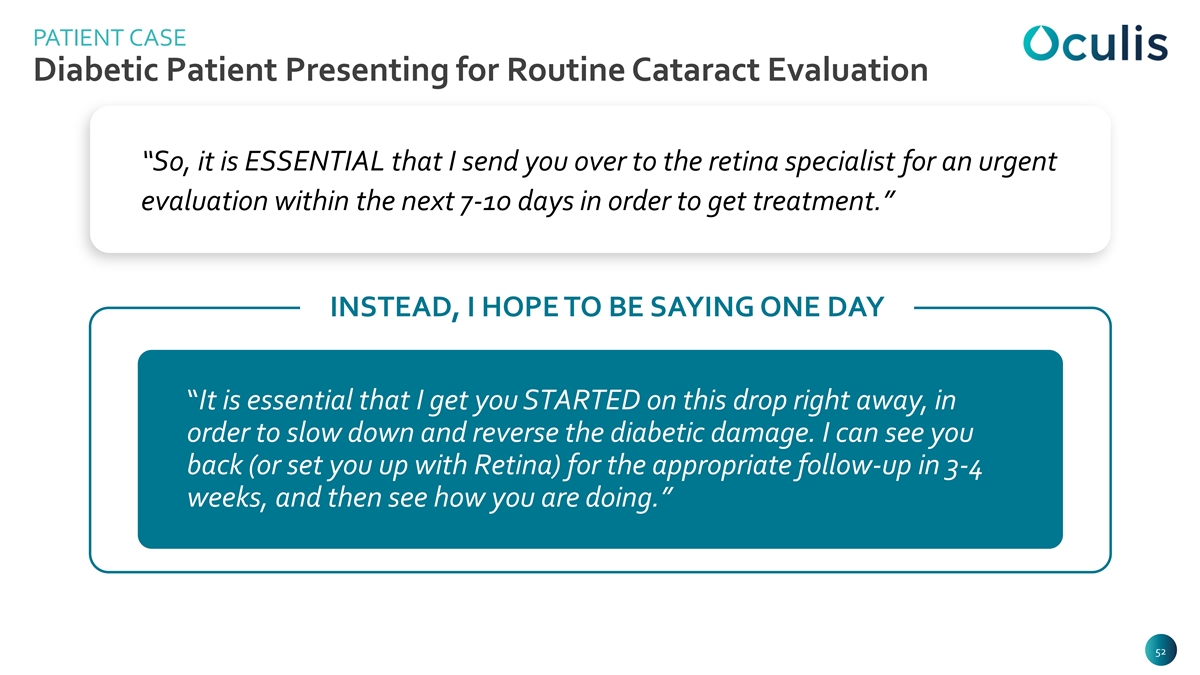
PATIENT CASE Diabetic Patient Presenting for Routine Cataract Evaluation “So, it is ESSENTIAL that I send you over to the retina specialist for an urgent evaluation within the next 7-10 days in order to get treatment.” INSTEAD, I HOPE TO BE SAYING ONE DAY “It is essential that I get you STARTED on this drop right away, in order to slow down and reverse the diabetic damage. I can see you back (or set you up with Retina) for the appropriate follow-up in 3-4 weeks, and then see how you are doing.” 52 52 52 52
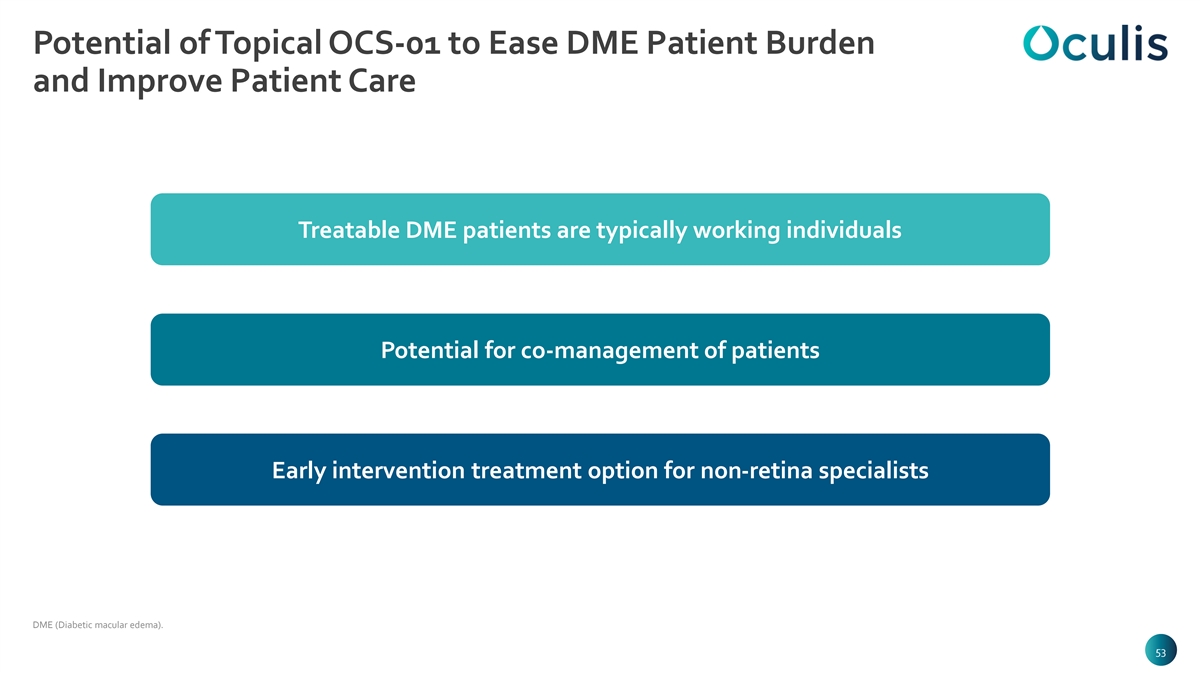
Potential of Topical OCS-01 to Ease DME Patient Burden and Improve Patient Care Treatable DME patients are typically working individuals Potential for co-management of patients Early intervention treatment option for non-retina specialists DME (Diabetic macular edema). 53 53 53 53
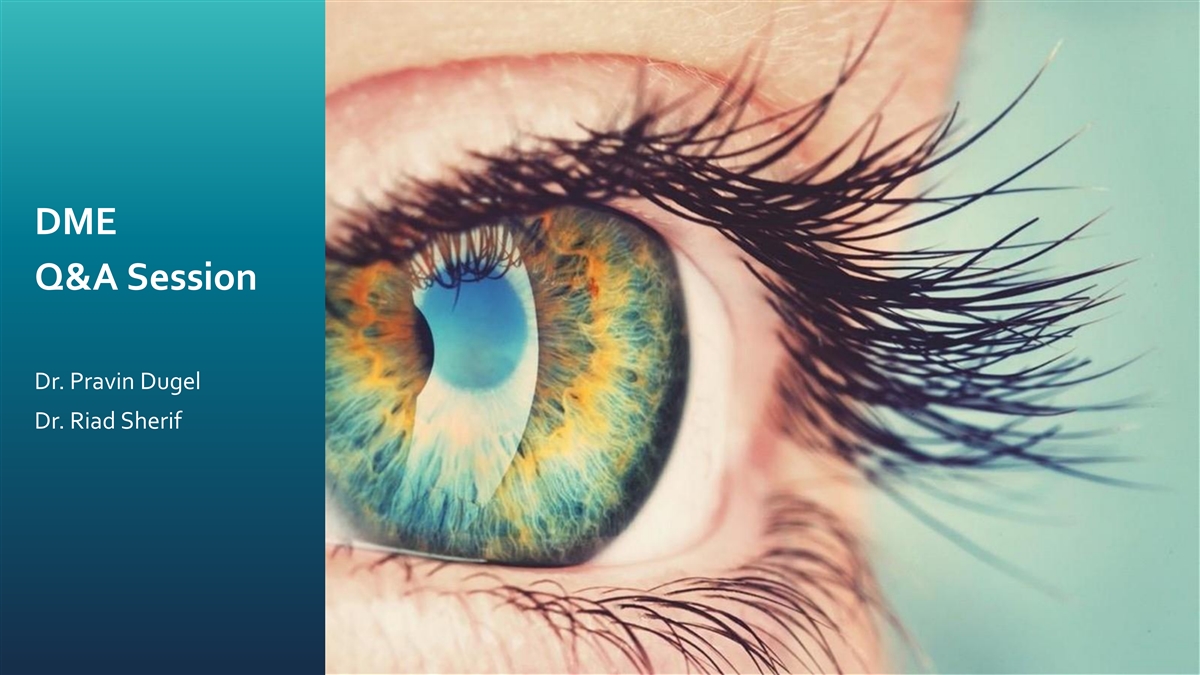
DME Q&A Session Dr. Pravin Dugel Dr. Riad Sherif
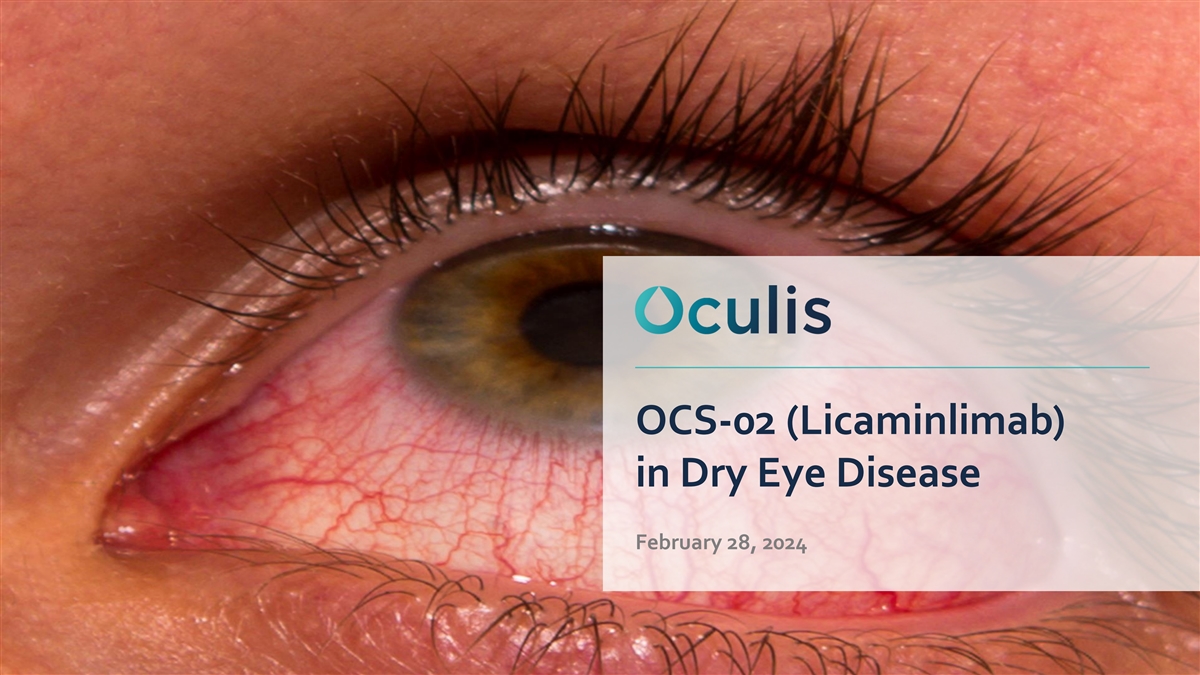
OCS-02 (Licaminlimab) in Dry Eye Disease February 28, 2024
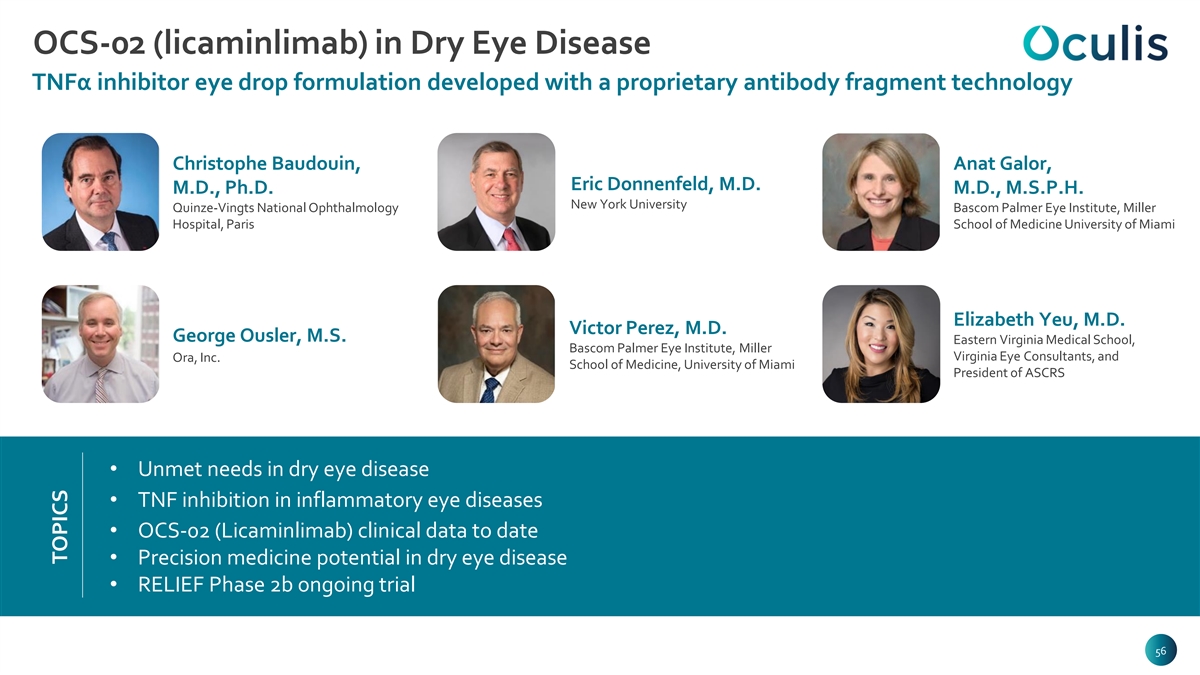
OCS-02 (licaminlimab) in Dry Eye Disease TNFα inhibitor eye drop formulation developed with a proprietary antibody fragment technology Christophe Baudouin, Anat Galor, Eric Donnenfeld, M.D. M.D., Ph.D. M.D., M.S.P.H. New York University Quinze-Vingts National Ophthalmology Bascom Palmer Eye Institute, Miller Hospital, Paris School of Medicine University of Miami Elizabeth Yeu, M.D. Victor Perez, M.D. George Ousler, M.S. Eastern Virginia Medical School, Bascom Palmer Eye Institute, Miller Virginia Eye Consultants, and Ora, Inc. School of Medicine, University of Miami President of ASCRS • Unmet needs in dry eye disease • TNF inhibition in inflammatory eye diseases • OCS-02 (Licaminlimab) clinical data to date • Precision medicine potential in dry eye disease • RELIEF Phase 2b ongoing trial 56 56 56 56 TOPICS TOPICS
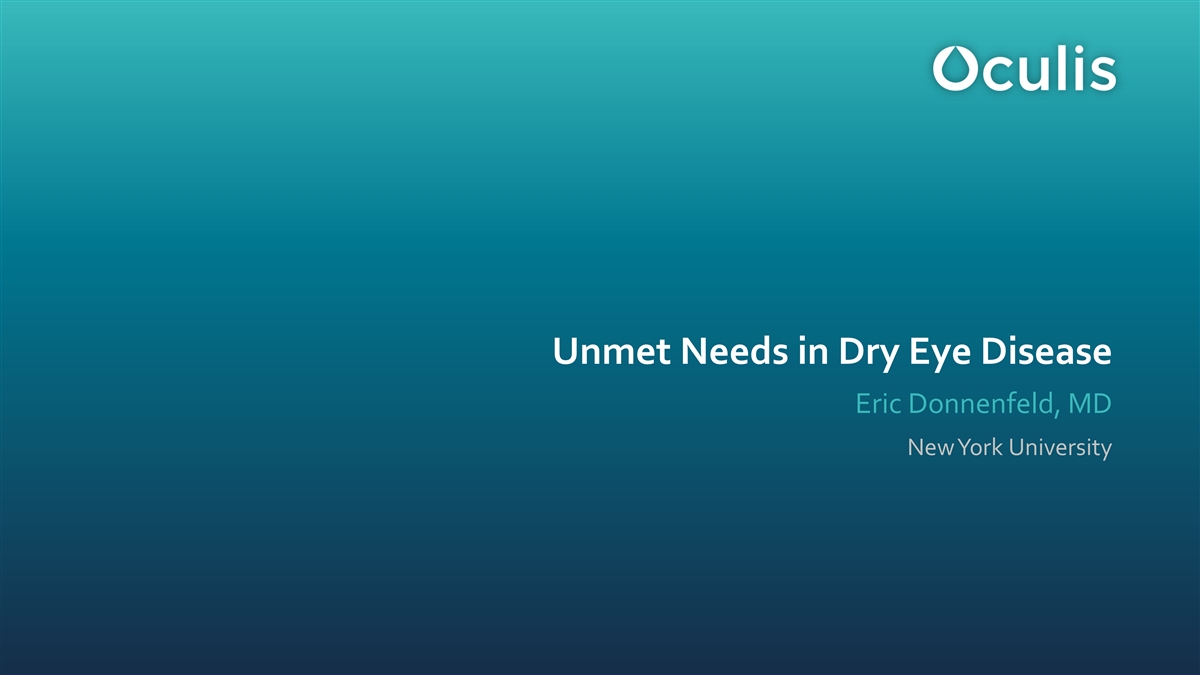
Unmet Needs in Dry Eye Disease Eric Donnenfeld, MD New York University 57 57
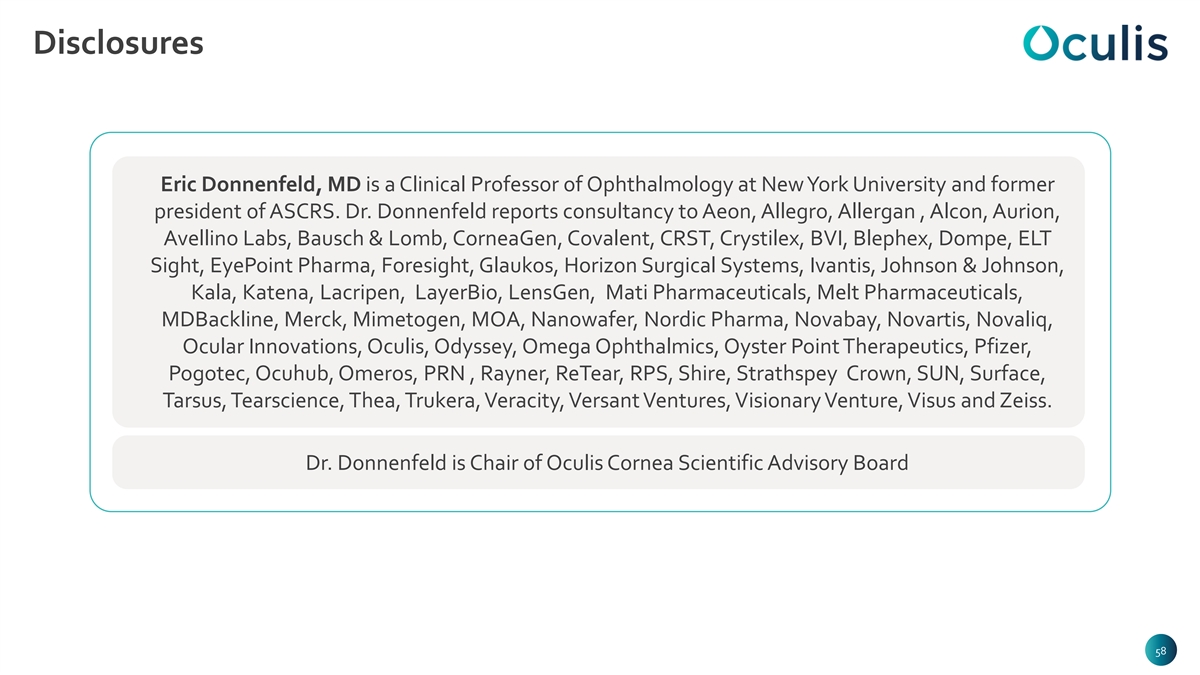
Disclosures Eric Donnenfeld, MD is a Clinical Professor of Ophthalmology at New York University and former president of ASCRS. Dr. Donnenfeld reports consultancy to Aeon, Allegro, Allergan , Alcon, Aurion, Avellino Labs, Bausch & Lomb, CorneaGen, Covalent, CRST, Crystilex, BVI, Blephex, Dompe, ELT Sight, EyePoint Pharma, Foresight, Glaukos, Horizon Surgical Systems, Ivantis, Johnson & Johnson, Kala, Katena, Lacripen, LayerBio, LensGen, Mati Pharmaceuticals, Melt Pharmaceuticals, MDBackline, Merck, Mimetogen, MOA, Nanowafer, Nordic Pharma, Novabay, Novartis, Novaliq, Ocular Innovations, Oculis, Odyssey, Omega Ophthalmics, Oyster Point Therapeutics, Pfizer, Pogotec, Ocuhub, Omeros, PRN , Rayner, ReTear, RPS, Shire, Strathspey Crown, SUN, Surface, Tarsus, Tearscience, Thea, Trukera, Veracity, Versant Ventures, Visionary Venture, Visus and Zeiss. Dr. Donnenfeld is Chair of Oculis Cornea Scientific Advisory Board 58 58 58 58
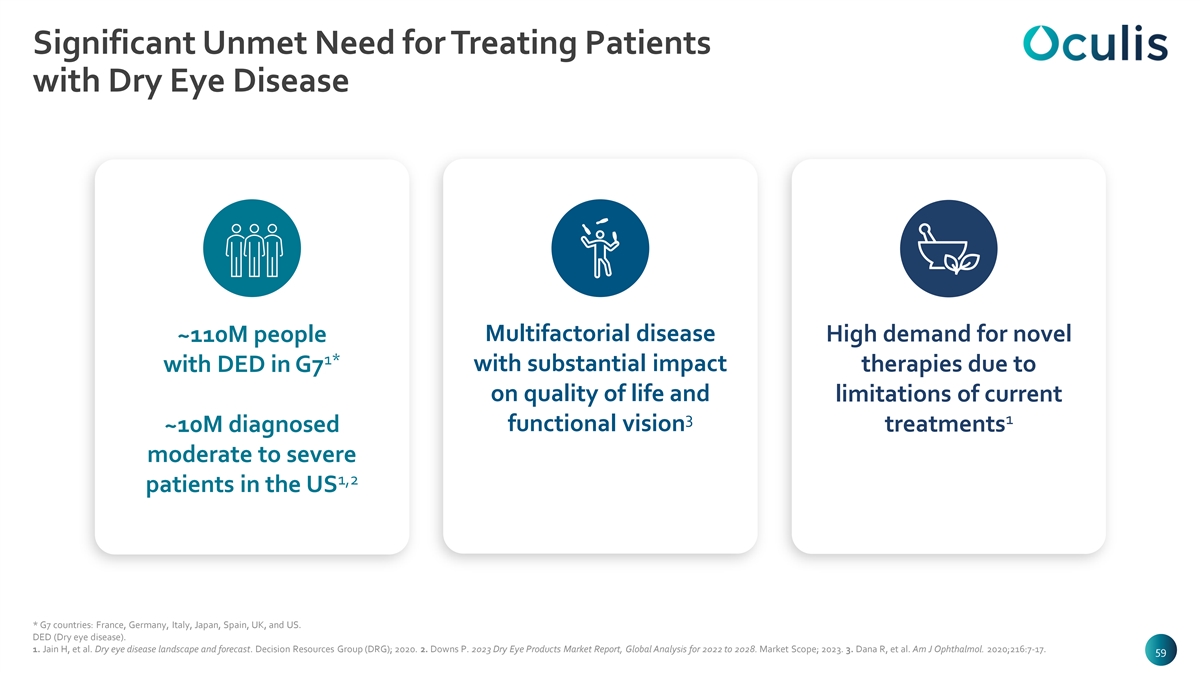
Significant Unmet Need for Treating Patients with Dry Eye Disease Multifactorial disease High demand for novel ~110M people 1* with substantial impact therapies due to with DED in G7 on quality of life and limitations of current 3 1 functional vision treatments ~10M diagnosed moderate to severe 1,2 patients in the US * G7 countries: France, Germany, Italy, Japan, Spain, UK, and US. DED (Dry eye disease). 1. Jain H, et al. Dry eye disease landscape and forecast. Decision Resources Group (DRG); 2020. 2. Downs P. 2023 Dry Eye Products Market Report, Global Analysis for 2022 to 2028. Market Scope; 2023. 3. Dana R, et al. Am J Ophthalmol. 2020;216:7-17. 59 59 59 59
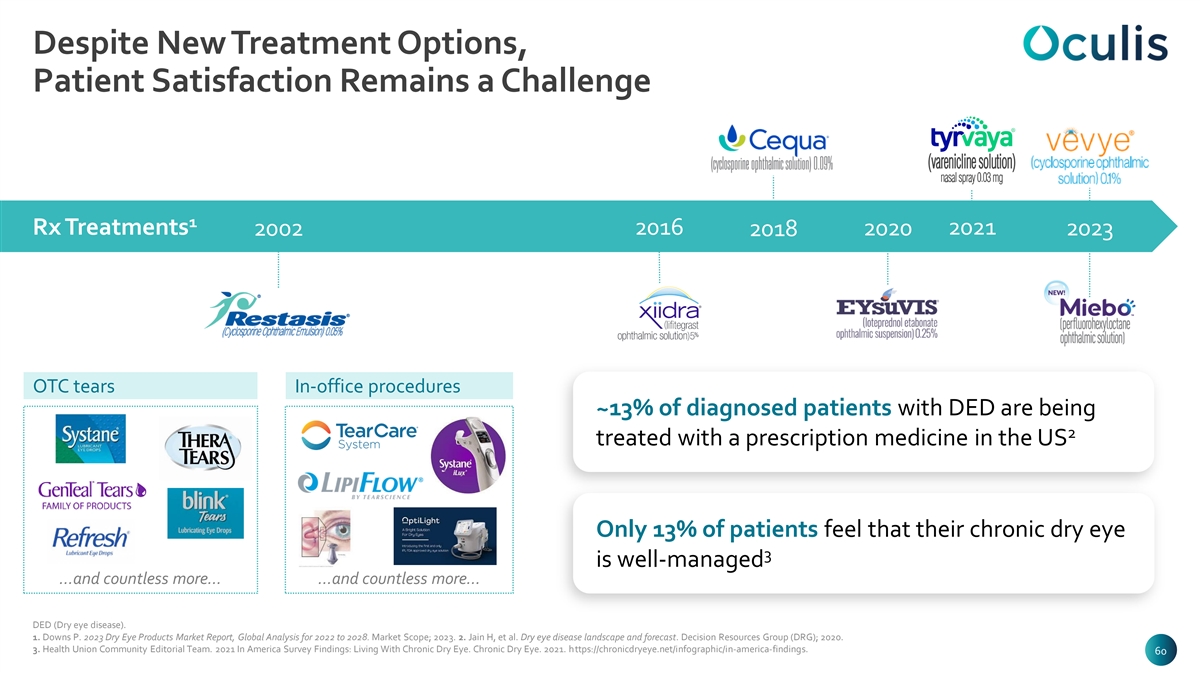
Despite New Treatment Options, Patient Satisfaction Remains a Challenge 1 Rx Treatments 2016 2021 2002 2018 2020 2023 OTC tears In-office procedures ~13% of diagnosed patients with DED are being 2 treated with a prescription medicine in the US Only 13% of patients feel that their chronic dry eye 3 is well-managed …and countless more… …and countless more… DED (Dry eye disease). 1. Downs P. 2023 Dry Eye Products Market Report, Global Analysis for 2022 to 2028. Market Scope; 2023. 2. Jain H, et al. Dry eye disease landscape and forecast. Decision Resources Group (DRG); 2020. 3. Health Union Community Editorial Team. 2021 In America Survey Findings: Living With Chronic Dry Eye. Chronic Dry Eye. 2021. h ttps://chronicdryeye.net/infographic/in-america-findings. 60 60 60 60
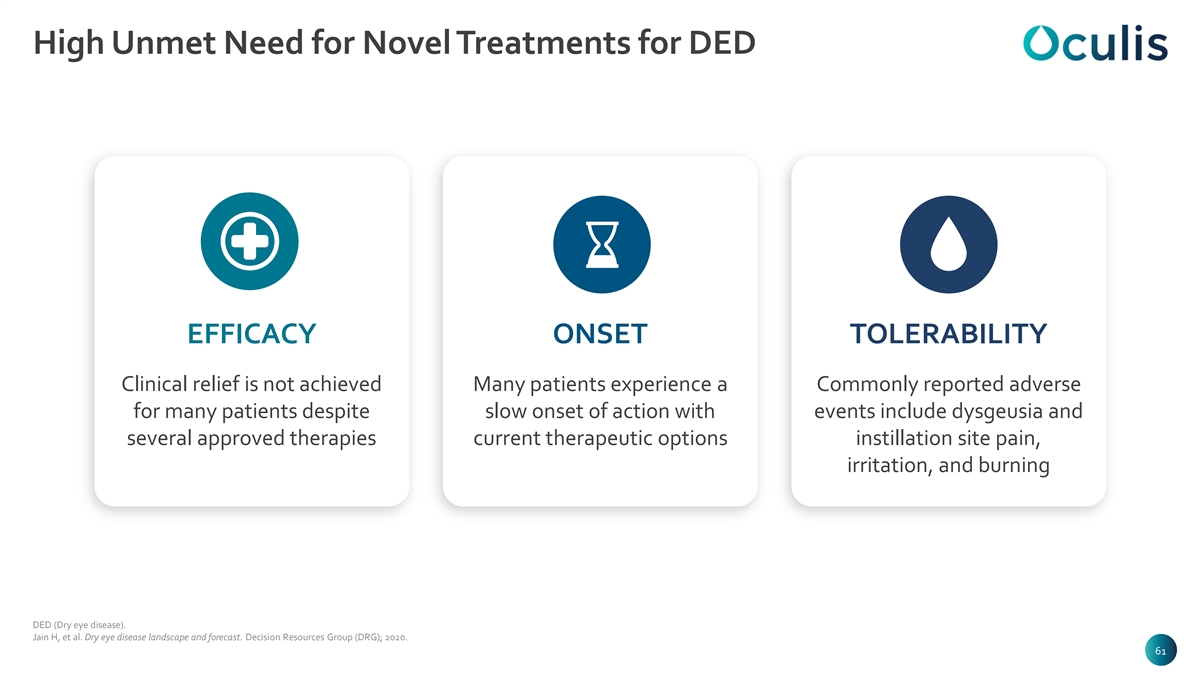
High Unmet Need for Novel Treatments for DED EFFICACY ONSET TOLERABILITY Clinical relief is not achieved Many patients experience a Commonly reported adverse for many patients despite slow onset of action with events include dysgeusia and several approved therapies current therapeutic options instillation site pain, irritation, and burning DED (Dry eye disease). Jain H, et al. Dry eye disease landscape and forecast. Decision Resources Group (DRG); 2020. 61 61 61 61
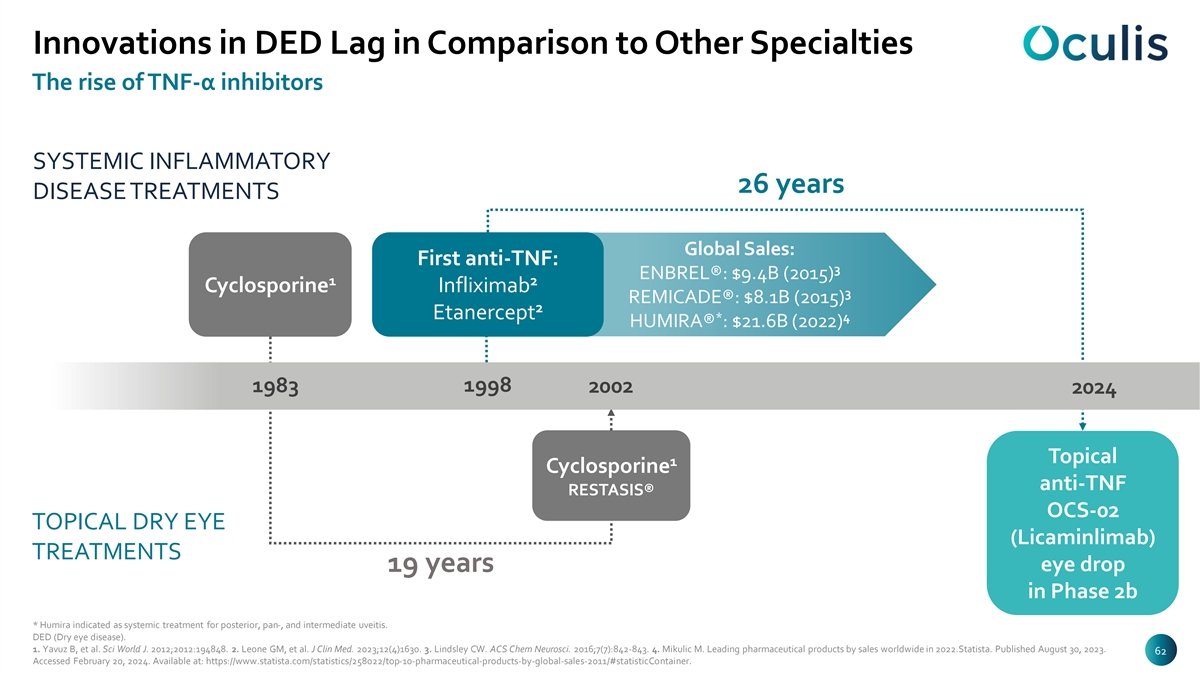
Innovations in DED Lag in Comparison to Other Specialties The rise of TNF-α inhibitors SYSTEMIC INFLAMMATORY 26 years DISEASE TREATMENTS Global Sales: First anti-TNF: 3 ENBREL®: $9.4B (2015) 1 2 Cyclosporine Infliximab 3 REMICADE®: $8.1B (2015) 2 Etanercept * 4 HUMIRA® : $21.6B (2022) 1983 1998 2002 2024 Topical 1 Cyclosporine anti-TNF RESTASIS® OCS-02 TOPICAL DRY EYE (Licaminlimab) TREATMENTS eye drop 19 years in Phase 2b * Humira indicated as systemic treatment for posterior, pan-, and intermediate uveitis. DED (Dry eye disease). 1. Yavuz B, et al. Sci World J. 2012;2012:194848. 2. Leone GM, et al. J Clin Med. 2023;12(4)1630. 3. Lindsley CW. ACS Chem Neurosci. 2016;7(7):842-843. 4. Mikulic M. Leading pharmaceutical products by sales worldwide in 2022.Statista. Published August 30, 2023. 62 62 62 62 Accessed February 20, 2024. Available at: https://www.statista.com/statistics/258022/top-10-pharmaceutical-products-by-global-sales-2011/#statisticContainer.
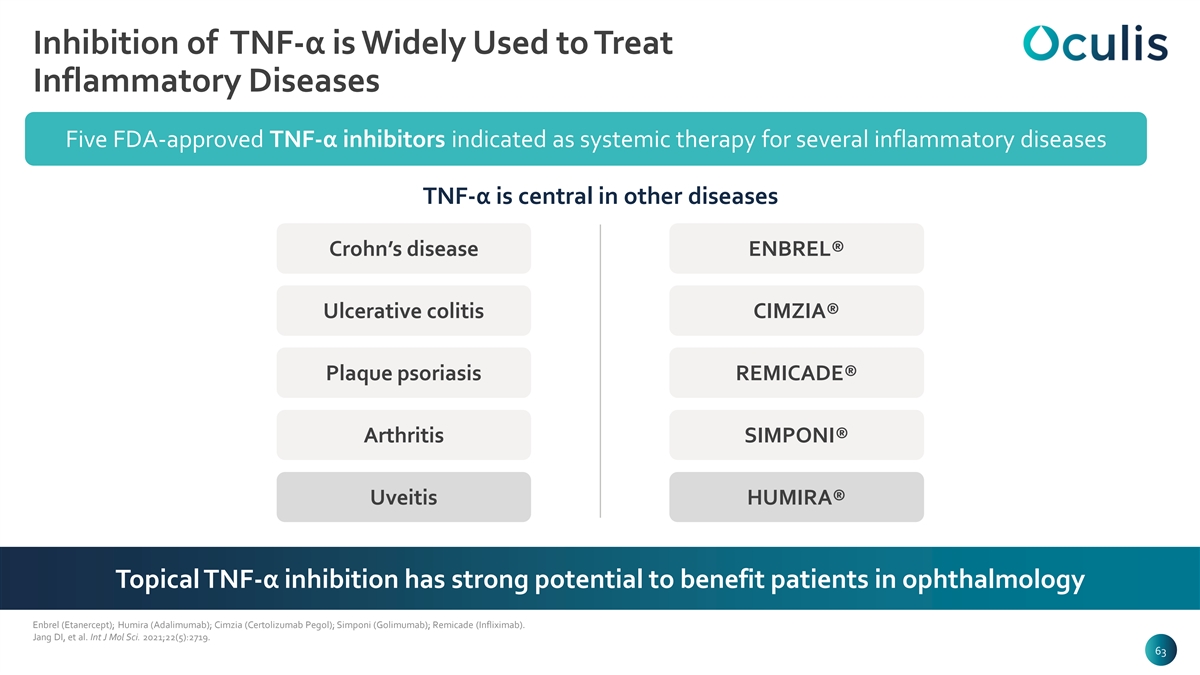
Inhibition of TNF-α is Widely Used to Treat Inflammatory Diseases Five FDA-approved TNF-α inhibitors indicated as systemic therapy for several inflammatory diseases TNF-α is central in other diseases Crohn’s disease ENBREL® Ulcerative colitis CIMZIA® Plaque psoriasis REMICADE® Arthritis SIMPONI® Uveitis HUMIRA® Topical TNF-α inhibition has strong potential to benefit patients in ophthalmology Enbrel (Etanercept); Humira (Adalimumab); Cimzia (Certolizumab Pegol); Simponi (Golimumab); Remicade (Infliximab). Jang DI, et al. Int J Mol Sci. 2021;22(5):2719. 63 63 63 63
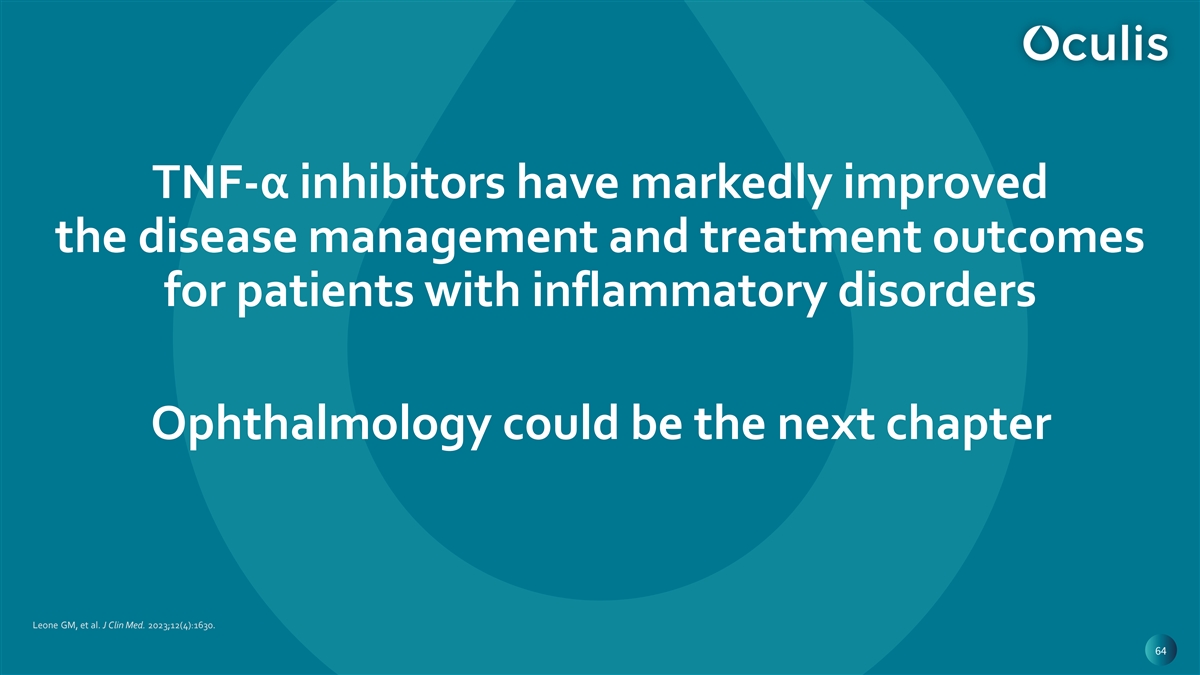
TNF-α inhibitors have markedly improved the disease management and treatment outcomes for patients with inflammatory disorders Ophthalmology could be the next chapter Leone GM, et al. J Clin Med. 2023;12(4):1630. 64 64 64 64
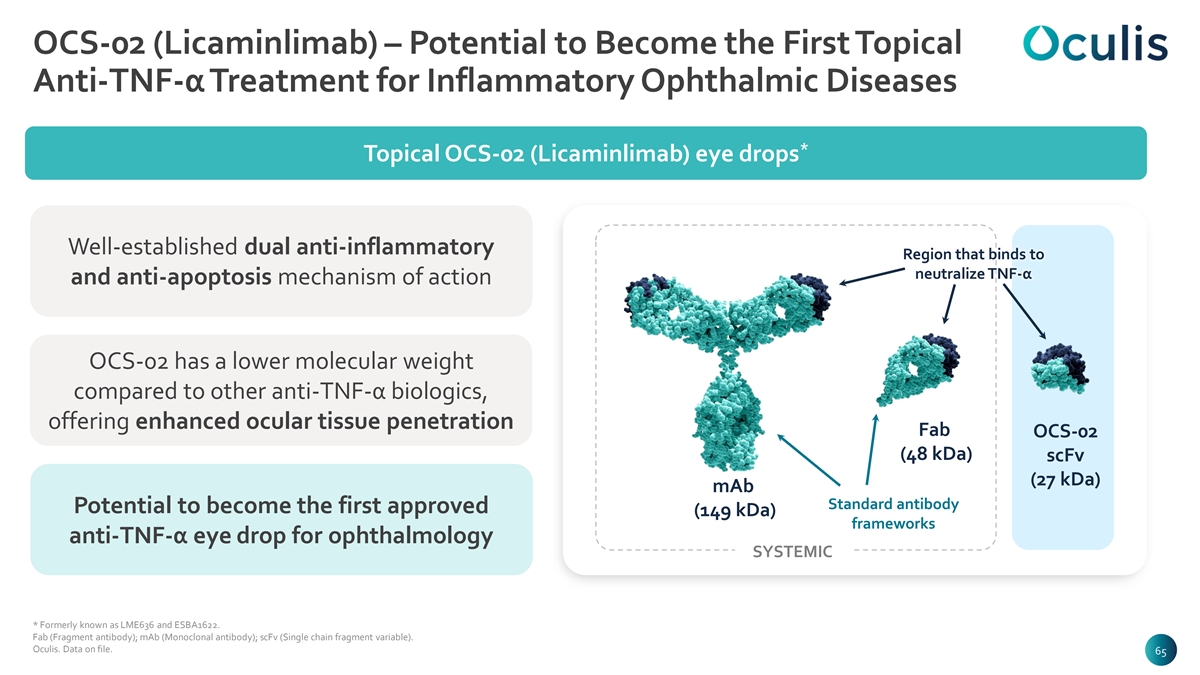
OCS-02 (Licaminlimab) – Potential to Become the First Topical Anti-TNF-α Treatment for Inflammatory Ophthalmic Diseases * Topical OCS-02 (Licaminlimab) eye drops Illustration of fragment technology Illustration of fragment technology scFv* IgG Fab (OCS-02) Illustration of fragment technology scFv* IgG Fab Well-established dual anti-inflammatory (OCS-02) Region that binds to scFv* IgG FaR b egions that bind to (OCS-02) neutralize TNF-α � Reg n io en us tr t a h lia zt e b TiN nd F to and anti-apoptosis mechanism of action � neutralize TNF Regions that bind to neutralize TNF� OCS-02 has a lower molecular weight compared to other anti-TNF-α biologics, offering enhanced ocular tissue penetration Fab OCS-02 Framework for OCS-02 Framework for OCS-02 optimized for stability Standard (48 kDa) scFv optimized for stability and other drug-like Standard antibody Framework for OCS-02 and other drug-like properties antibody frameworks optimized for stability properties Standard (27 kDa) frameworks mAb and other drug-like antibody properties framewoS rkt sandard antibody Potential to become the first approved (149 kDa) frameworks anti-TNF-α eye drop for ophthalmology SYSTEMIC * Formerly known as LME636 and ESBA1622. Fab (Fragment antibody); mAb (Monoclonal antibody); scFv (Single chain fragment variable). Oculis. Data on file. 65 65 65 65
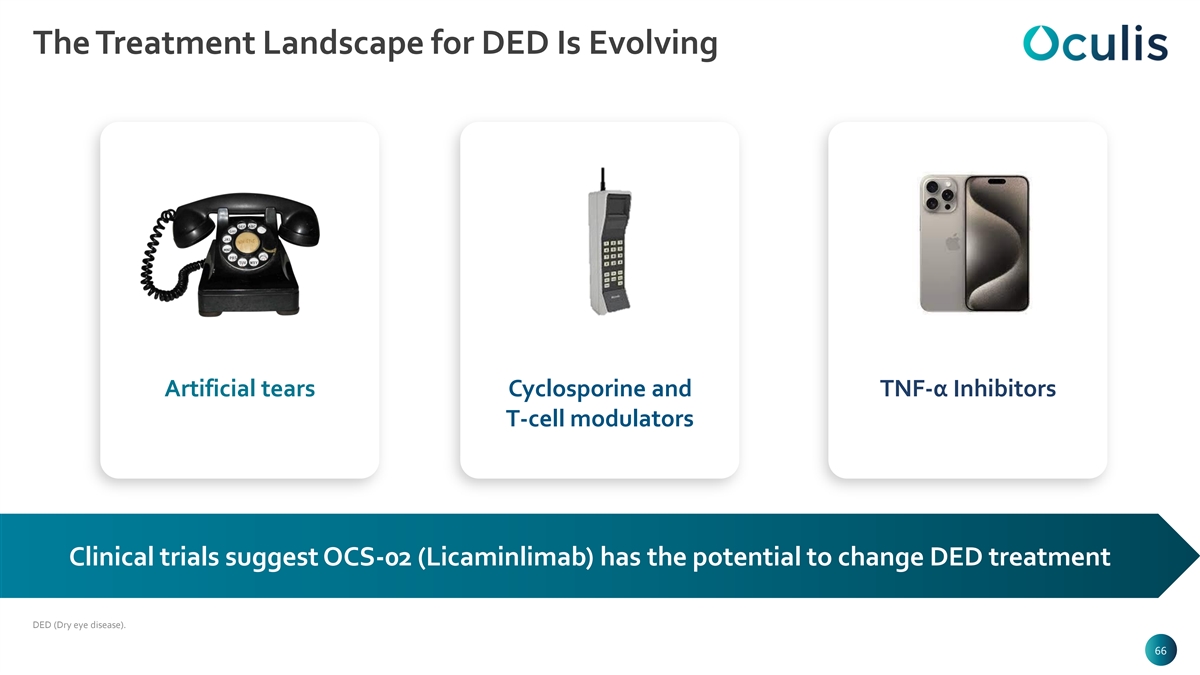
The Treatment Landscape for DED Is Evolving Artificial tears Cyclosporine and TNF-α Inhibitors T-cell modulators Clinical trials suggest OCS-02 (Licaminlimab) has the potential to change DED treatment DED (Dry eye disease). 66 66 66 66
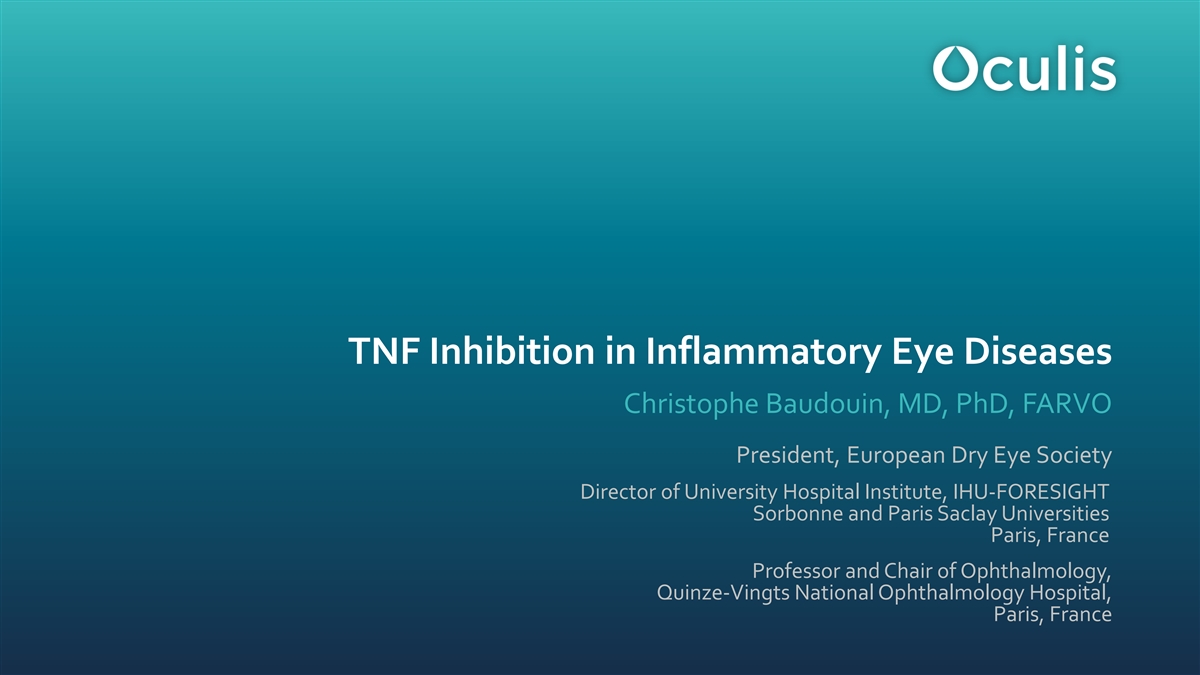
TNF Inhibition in Inflammatory Eye Diseases Christophe Baudouin, MD, PhD, FARVO President, European Dry Eye Society Director of University Hospital Institute, IHU-FORESIGHT Sorbonne and Paris Saclay Universities Paris, France Professor and Chair of Ophthalmology, Quinze-Vingts National Ophthalmology Hospital, Paris, France 67 67
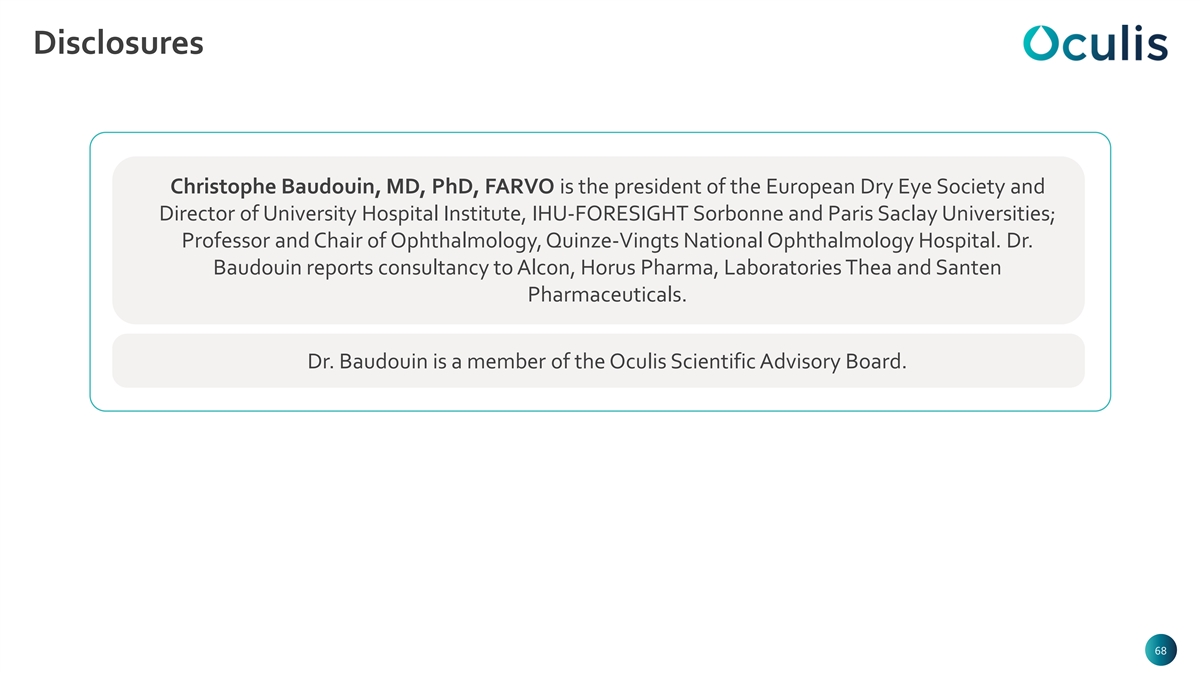
Disclosures Christophe Baudouin, MD, PhD, FARVO is the president of the European Dry Eye Society and Director of University Hospital Institute, IHU-FORESIGHT Sorbonne and Paris Saclay Universities; Professor and Chair of Ophthalmology, Quinze-Vingts National Ophthalmology Hospital. Dr. Baudouin reports consultancy to Alcon, Horus Pharma, Laboratories Thea and Santen Pharmaceuticals. Dr. Baudouin is a member of the Oculis Scientific Advisory Board. 68 68 68 68
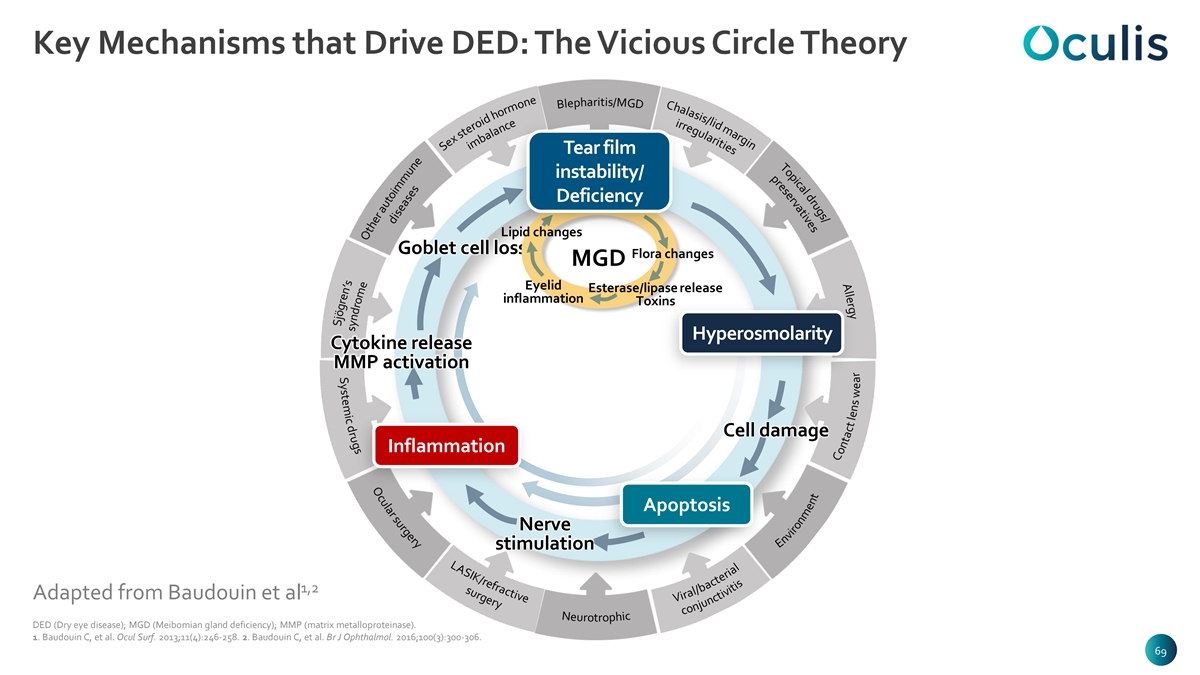
S y s t e y m g r i e c l l d A r u g s O / s c s g e u l v u i a r t r a d s v l u r a e r s g c i e e r p r p o y T n i g r a L s e A m i t S i s I r d K a u i l / l r u r / e g g s f e e i r r a s r r c y a i t l i v a e h C D N G e M u / r s i o t Key Mechanisms that Drive DED: The Vicious Circle Theory Tear film instability/ Deficiency Lipid changes Goblet cell loss Flora changes MGD Eyelid Esterase/lipase release inflammation Toxins Hyperosmolarity Cytokine release MMP activation Cell damage Inflammation Apoptosis Nerve stimulation 1,2 Adapted from Baudouin et al t DED (Dry eye disease); MGD (Meibomian gland deficiency); MMP (matrix metalloproteinase). 1. Baudouin C, et al. Ocul Surf. 2013;11(4):246-258. 2. Baudouin C, et al. Br J Ophthalmol. 2016;100(3):300-306. 69 69 69 69 i r r a o h p p h e i l c B e c V n o i o r n m a j r l u e / o c b h n n a a d c l i a c t o b t i r m e v e i i r t i t s i a x s l e E S n v i r e n u o m m s e n i s o a e t s i u d a r m e C h t O e o n n t t s ’ e a n m c e o t r r d g l n e ö y j n s S s w e a r
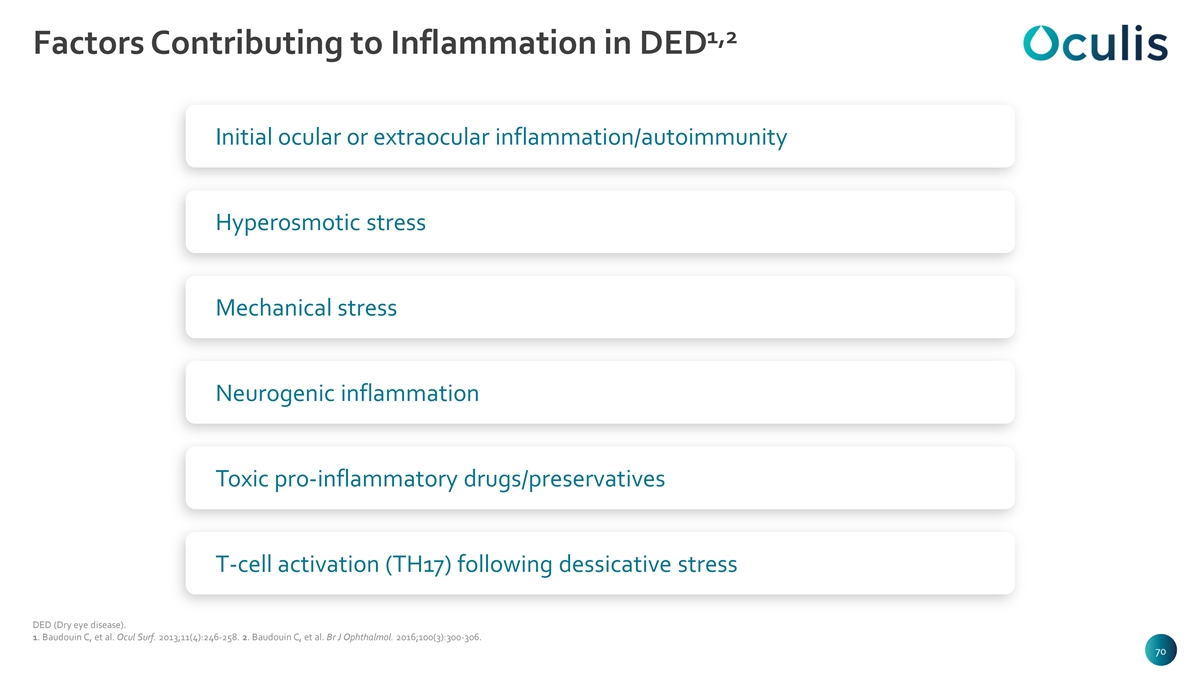
1,2 Factors Contributing to Inflammation in DED Initial ocular or extraocular inflammation/autoimmunity Hyperosmotic stress Mechanical stress Neurogenic inflammation Toxic pro-inflammatory drugs/preservatives T-cell activation (TH17) following dessicative stress DED (Dry eye disease). 1. Baudouin C, et al. Ocul Surf. 2013;11(4):246-258. 2. Baudouin C, et al. Br J Ophthalmol. 2016;100(3):300-306. 70 70 70 70
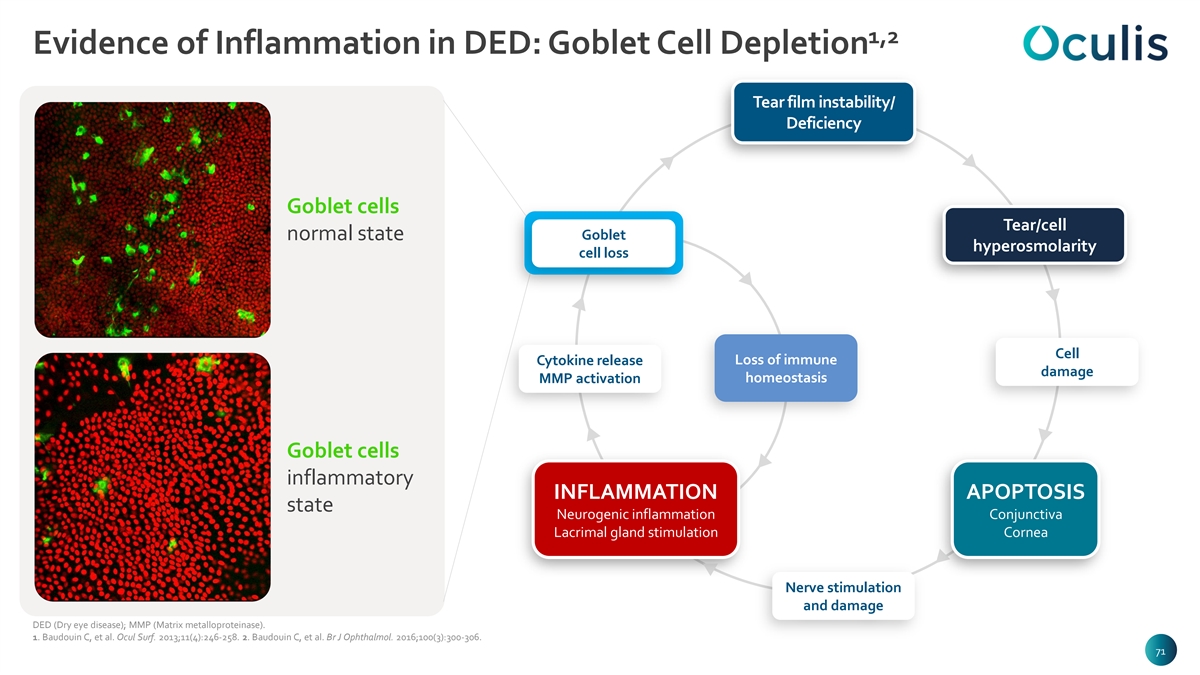
1,2 Evidence of Inflammation in DED: Goblet Cell Depletion Tear film instability/ Tear film instability Deficiency /imbalance Goblet cells Tear/cell Tear/cell Goblet normal state Goblet hyperosmolarity hyperosmolarity ce cel ll l l lo os ss s Cell Cytokine release Loss of immune damage homeostasis MMP activation Goblet cells inflammatory INFLAMMATION APOPTOSIS INFLAMMATION APOPTOSIS state Neurogenic inflammation Conjunctiva Neurogenic inflammation Conjunctiva Lacrimal gland stimulation Cornea Lacrimal gland stimulation Cornea Nerve stimulation and damage DED (Dry eye disease); MMP (Matrix metalloproteinase). 1. Baudouin C, et al. Ocul Surf. 2013;11(4):246-258. 2. Baudouin C, et al. Br J Ophthalmol. 2016;100(3):300-306. 71 71 71 71
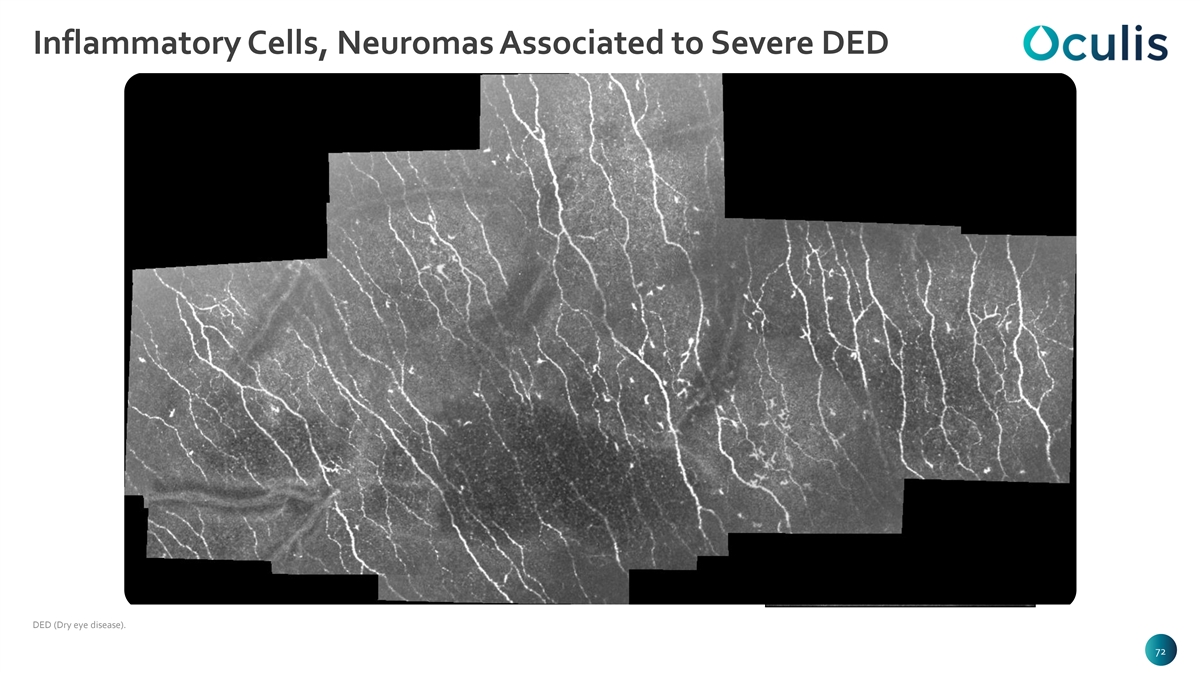
Inflammatory Cells, Neuromas Associated to Severe DED DED (Dry eye disease). 72 72 72 72
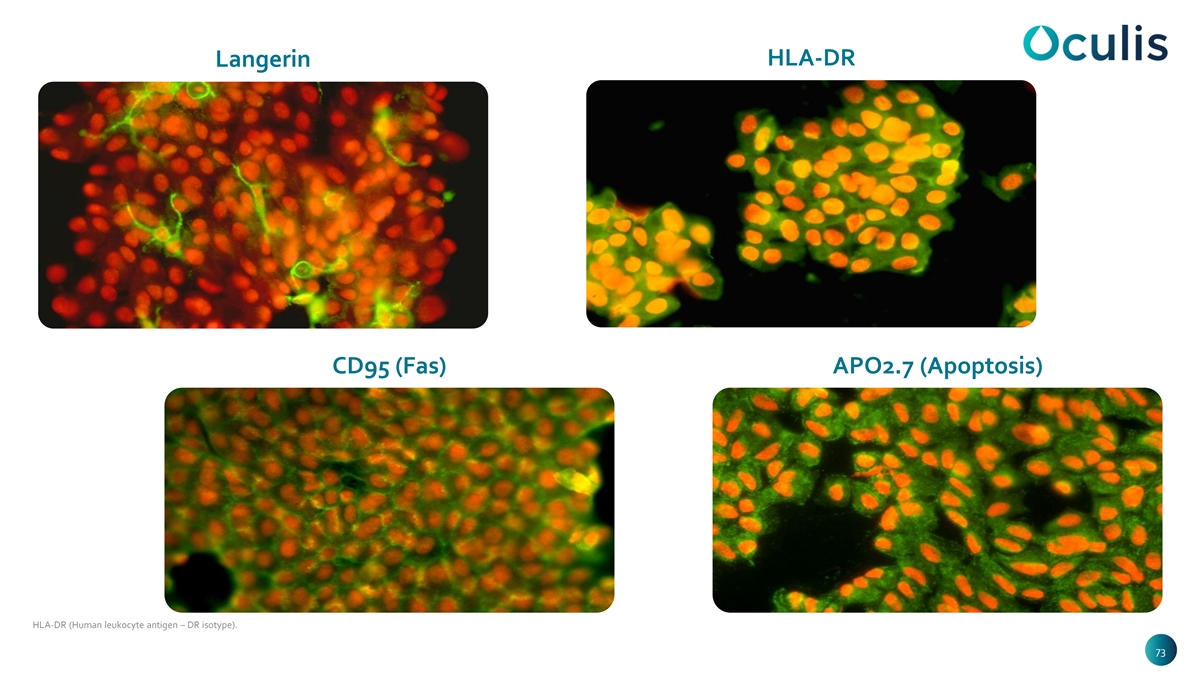
HLA-DR Langerin CD95 (Fas) APO2.7 (Apoptosis) HLA-DR (Human leukocyte antigen – DR isotype). 73 73 73 73
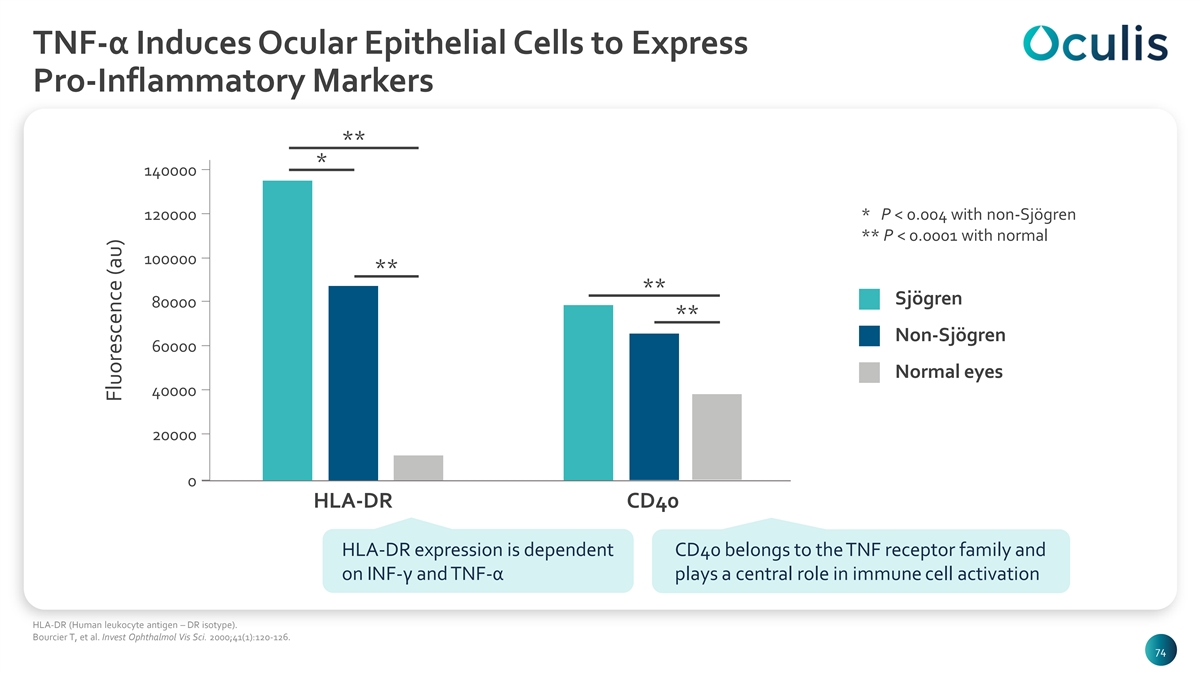
TNF-α Induces Ocular Epithelial Cells to Express Pro-Inflammatory Markers ** * 140000 120000 * P < 0.004 with non-Sjögren ** P < 0.0001 with normal 100000 ** ** Sjögren 80000 ** Non-Sjögren 60000 Normal eyes 40000 20000 0 HLA-DR CD40 HLA-DR expression is dependent CD40 belongs to the TNF receptor family and on INF-γ and TNF-α plays a central role in immune cell activation HLA-DR (Human leukocyte antigen – DR isotype). Bourcier T, et al. Invest Ophthalmol Vis Sci. 2000;41(1):120-126. 74 74 74 74 Fluorescence (au)
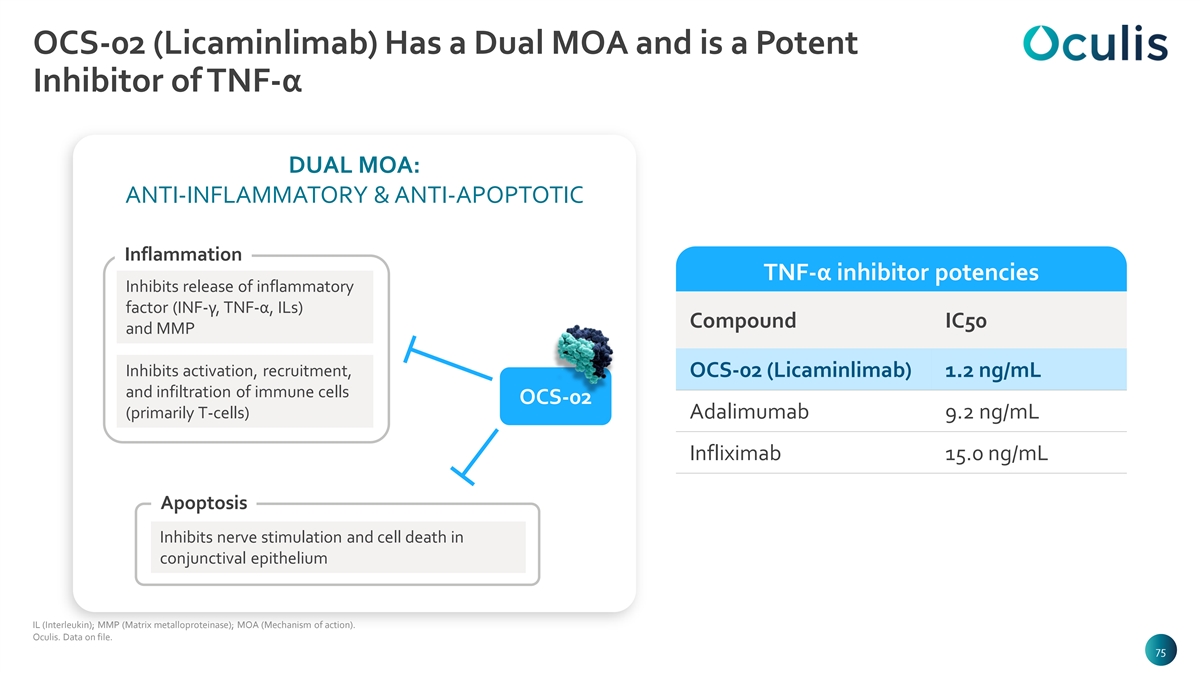
Illustration of fragment technology scFv* IgG Fab (OCS-02) Regions that bind to neutralize TNF� Framework for OCS-02 optimized for stability Standard and other drug-like antibody properties frameworks OCS-02 (Licaminlimab) Has a Dual MOA and is a Potent Inhibitor of TNF-α DUAL MOA: ANTI-INFLAMMATORY & ANTI-APOPTOTIC Inflammation TNF-α inhibitor potencies Inhibits release of inflammatory factor (INF-γ, TNF-α, ILs) Compound IC50 and MMP Inhibits activation, recruitment, OCS-02 (Licaminlimab) 1.2 ng/mL and infiltration of immune cells OCS-02 (primarily T-cells) Adalimumab 9.2 ng/mL Infliximab 15.0 ng/mL Apoptosis Inhibits nerve stimulation and cell death in conjunctival epithelium IL (Interleukin); MMP (Matrix metalloproteinase); MOA (Mechanism of action). Oculis. Data on file. 75 75 75 75
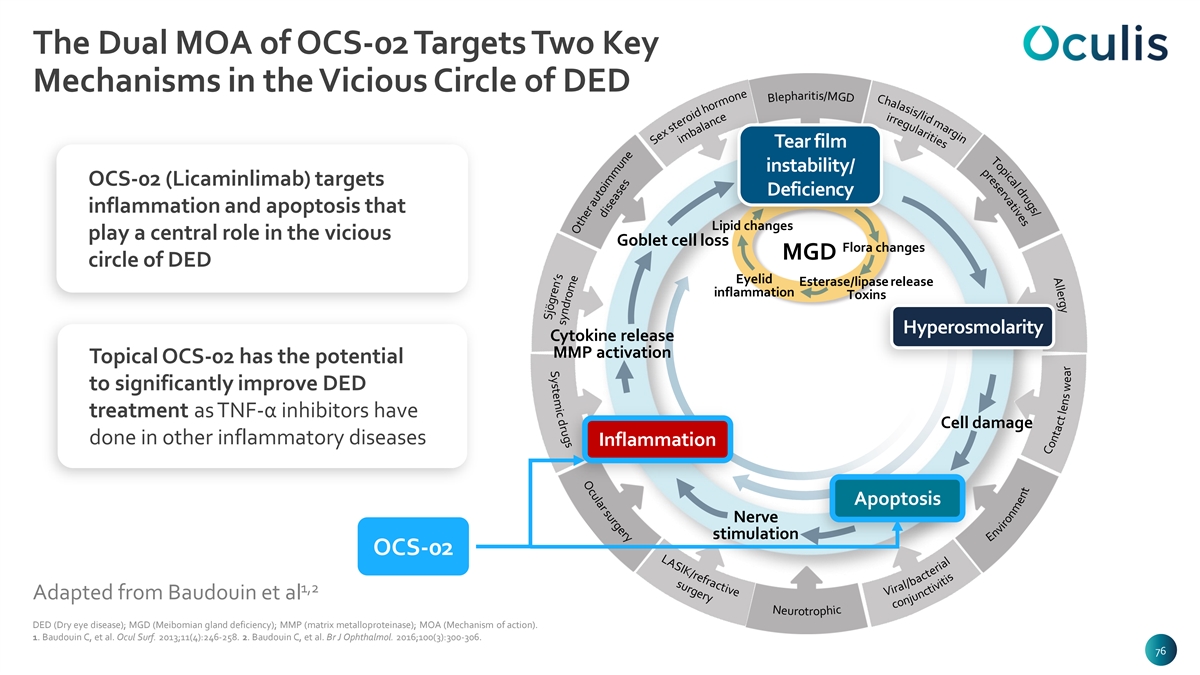
S y s t e y m g r i e c l l d A r u g s O / s c s g e u l v u i a r t r a d s v l u r a e r s c g i e e r p r p o y T n i g r a L s e A m i t S i s I r d K a u i l / l r u r / e g g s f e e i r r a s r r c y a i t l i v a e h C D N G e M u / r s i o t The Dual MOA of OCS-02 Targets Two Key Mechanisms in the Vicious Circle of DED Tear film instability/ OCS-02 (Licaminlimab) targets Deficiency inflammation and apoptosis that Lipid changes play a central role in the vicious Goblet cell loss Flora changes MGD circle of DED Eyelid Esterase/lipase release inflammation Toxins Hyperosmolarity Cytokine release MMP activation Topical OCS-02 has the potential to significantly improve DED treatment as TNF-α inhibitors have Cell damage done in other inflammatory diseases Inflammation Apoptosis Nerve stimulation OCS-02 1,2 Adapted from Baudouin et al t DED (Dry eye disease); MGD (Meibomian gland deficiency); MMP (matrix metalloproteinase); MOA (Mechanism of action). 1. Baudouin C, et al. Ocul Surf. 2013;11(4):246-258. 2. Baudouin C, et al. Br J Ophthalmol. 2016;100(3):300-306. 76 76 76 76 i r r a o h p p h e i l c B e c V n o i o r n m a j r l u e / o c b h n n a a d c l i a c t o b t i r m e v e i i r t i t s i a x s l e E S n v i r e n u o m m s e n i s o a e t s i u d a r m e C h t O e o n n t t s ’ e a n m c e o t r r d g l n e ö y j n s S s w e a r
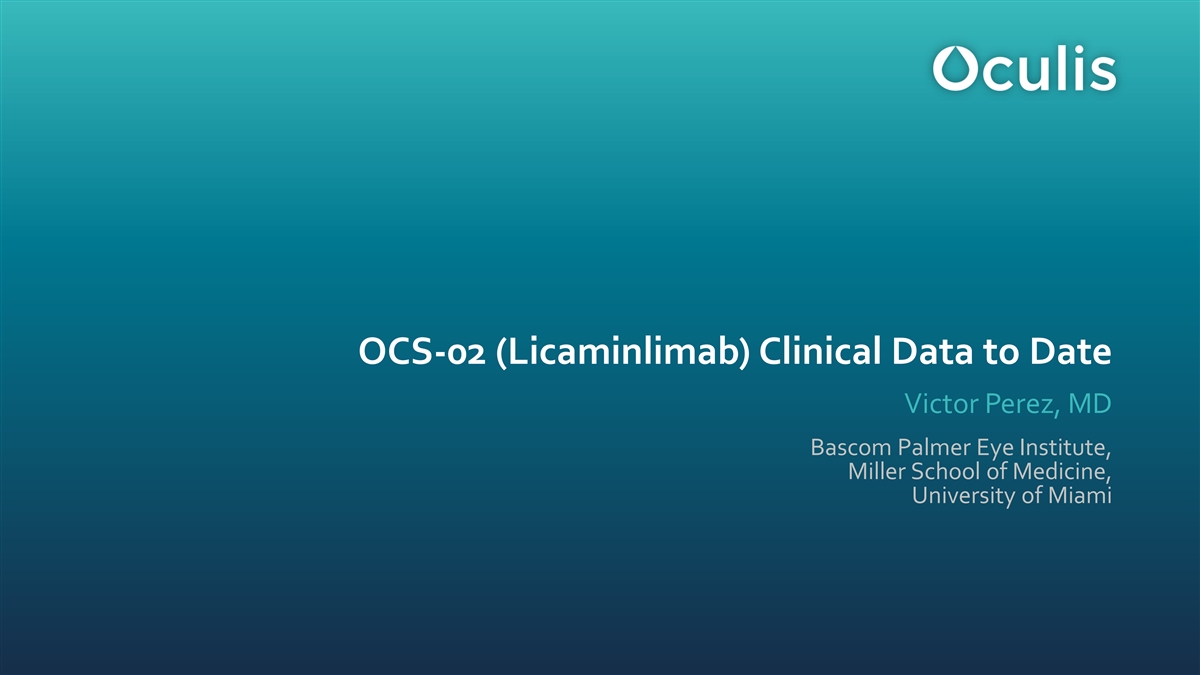
OCS-02 (Licaminlimab) Clinical Data to Date Victor Perez, MD Bascom Palmer Eye Institute, Miller School of Medicine, University of Miami 77 77
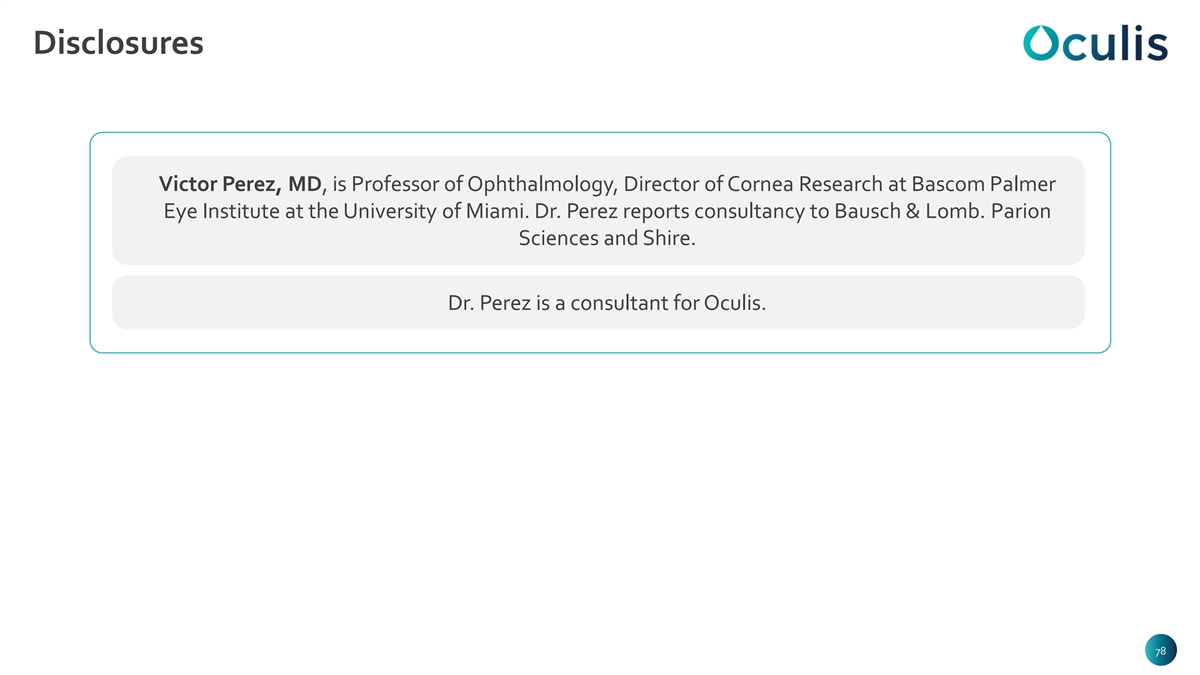
Disclosures Victor Perez, MD, is Professor of Ophthalmology, Director of Cornea Research at Bascom Palmer Eye Institute at the University of Miami. Dr. Perez reports consultancy to Bausch & Lomb. Parion Sciences and Shire. Dr. Perez is a consultant for Oculis. 78 78 78 78
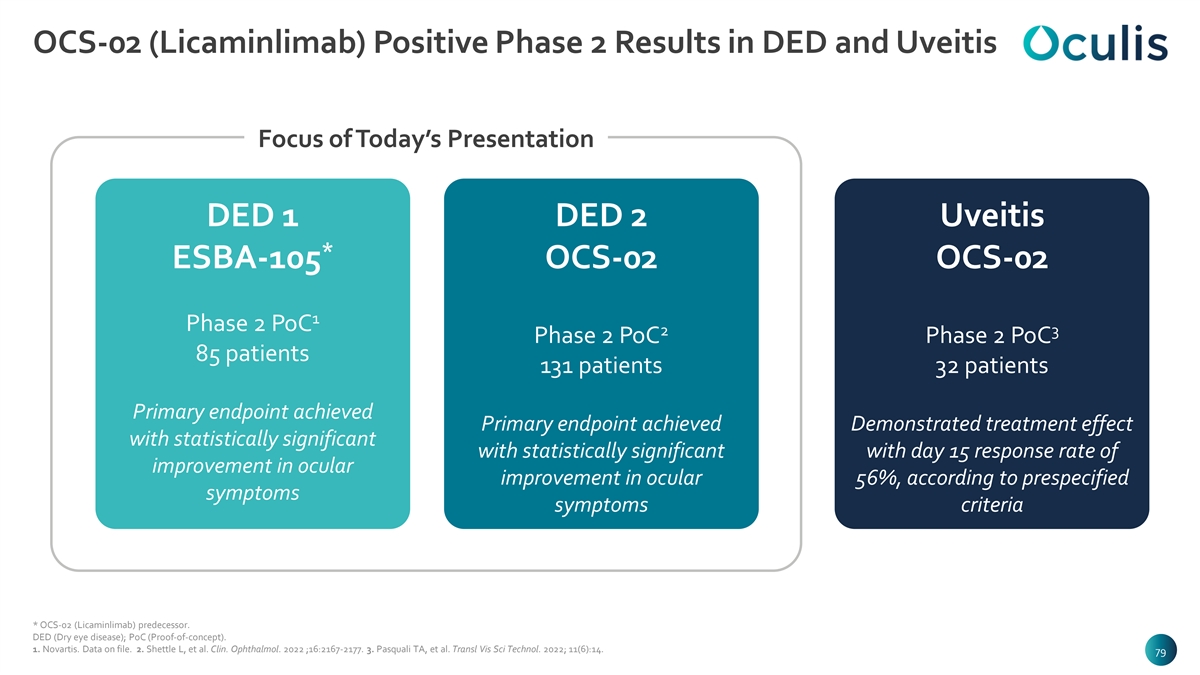
OCS-02 (Licaminlimab) Positive Phase 2 Results in DED and Uveitis Focus of Today’s Presentation DED 1 DED 2 Uveitis * ESBA-105 OCS-02 OCS-02 1 Phase 2 PoC 2 3 Phase 2 PoC Phase 2 PoC 85 patients 131 patients 32 patients Primary endpoint achieved Primary endpoint achieved Demonstrated treatment effect with statistically significant with statistically significant with day 15 response rate of improvement in ocular improvement in ocular 56%, according to prespecified symptoms symptoms criteria * OCS-02 (Licaminlimab) predecessor. DED (Dry eye disease); PoC (Proof-of-concept). 1. Novartis. Data on file. 2. Shettle L, et al. Clin. Ophthalmol. 2022 ;16:2167-2177. 3. Pasquali TA, et al. Transl Vis Sci Technol. 2022; 11(6):14. 79 79 79 79
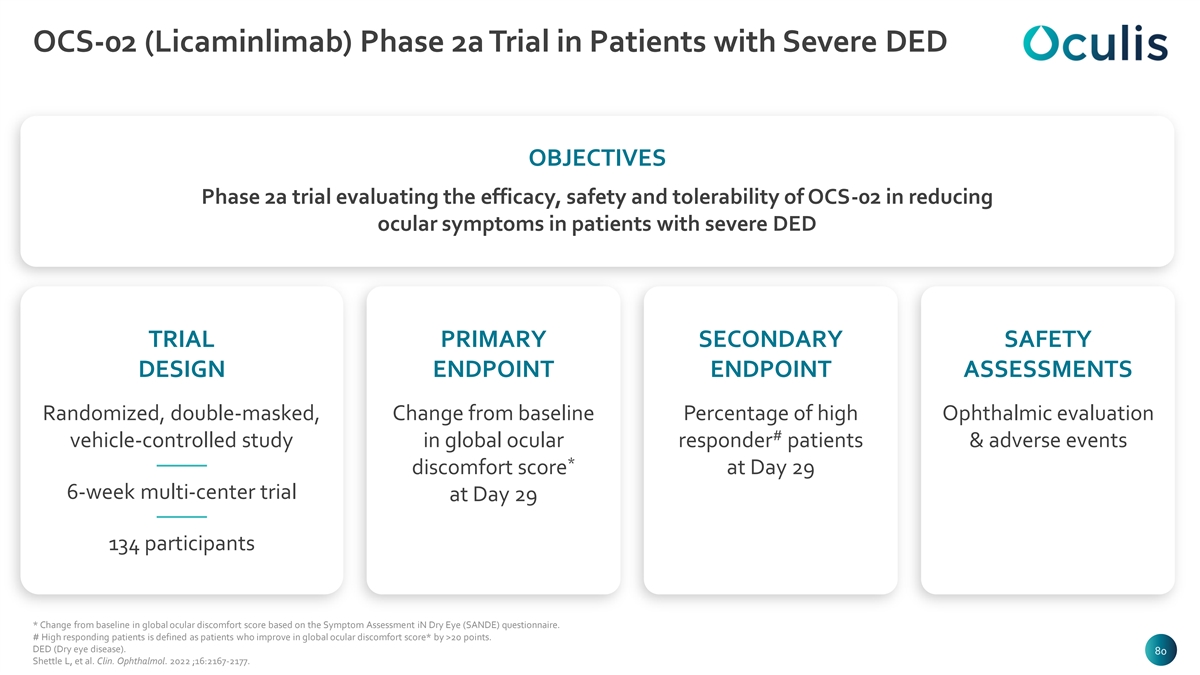
OCS-02 (Licaminlimab) Phase 2a Trial in Patients with Severe DED OBJECTIVES Phase 2a trial evaluating the efficacy, safety and tolerability of OCS-02 in reducing ocular symptoms in patients with severe DED TRIAL PRIMARY SECONDARY SAFETY DESIGN ENDPOINT ENDPOINT ASSESSMENTS Randomized, double-masked, Change from baseline Percentage of high Ophthalmic evaluation # vehicle-controlled study in global ocular responder patients & adverse events * discomfort score at Day 29 6-week multi-center trial at Day 29 134 participants * Change from baseline in global ocular discomfort score based on the Symptom Assessment iN Dry Eye (SANDE) questionnaire. # High responding patients is defined as patients who improve in global ocular discomfort score* by >20 points. DED (Dry eye disease). 80 80 80 80 Shettle L, et al. Clin. Ophthalmol. 2022 ;16:2167-2177.
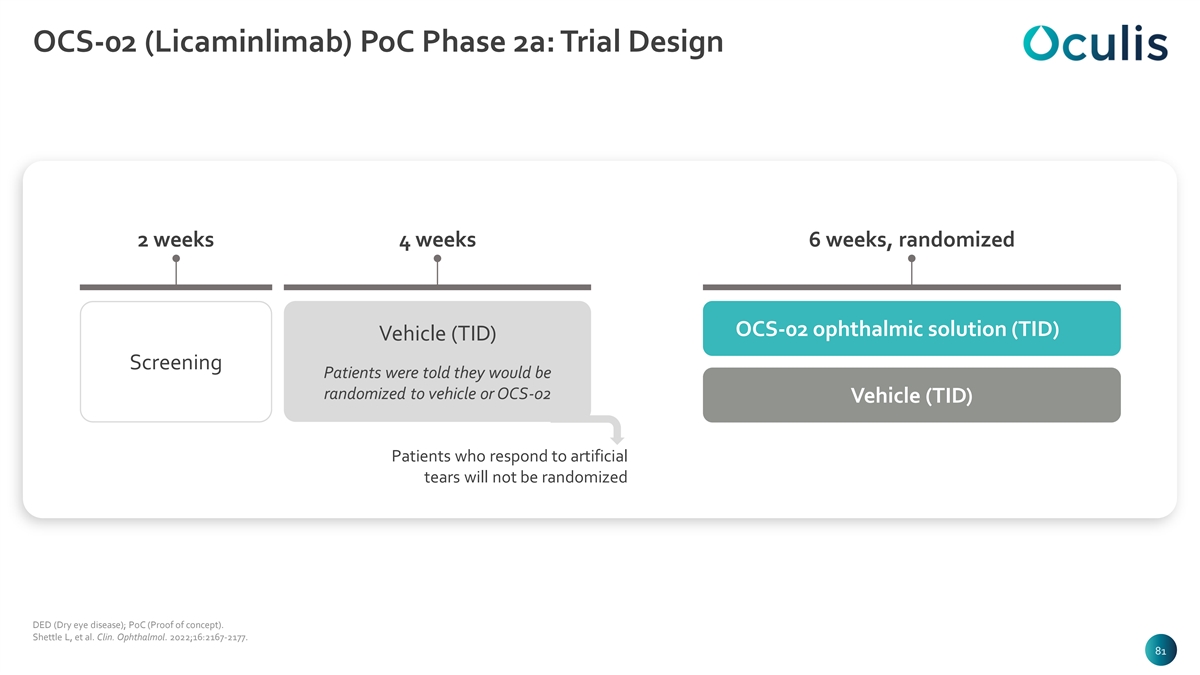
OCS-02 (Licaminlimab) PoC Phase 2a: Trial Design 2 weeks 4 weeks 6 weeks, randomized OCS-02 ophthalmic solution (TID) Vehicle (TID) Screening Patients were told they would be randomized to vehicle or OCS-02 Vehicle (TID) Patients who respond to artificial tears will not be randomized DED (Dry eye disease); PoC (Proof of concept). Shettle L, et al. Clin. Ophthalmol. 2022;16:2167-2177. 81 81 81 81
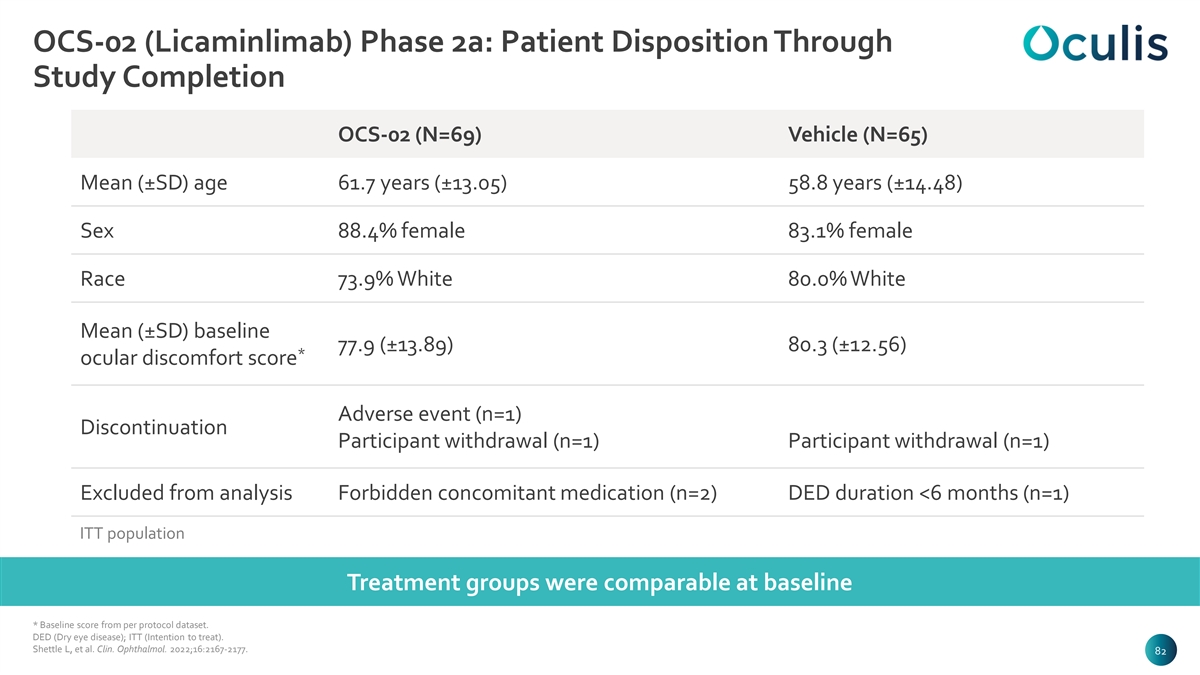
OCS-02 (Licaminlimab) Phase 2a: Patient Disposition Through Study Completion OCS-02 (N=69) Vehicle (N=65) Mean (±SD) age 61.7 years (±13.05) 58.8 years (±14.48) Sex 88.4% female 83.1% female Race 73.9% White 80.0% White Mean (±SD) baseline 77.9 (±13.89) 80.3 (±12.56) * ocular discomfort score Adverse event (n=1) Discontinuation Participant withdrawal (n=1) Participant withdrawal (n=1) Excluded from analysis Forbidden concomitant medication (n=2) DED duration <6 months (n=1) ITT population Treatment groups were comparable at baseline * Baseline score from per protocol dataset. DED (Dry eye disease); ITT (Intention to treat). Shettle L, et al. Clin. Ophthalmol. 2022;16:2167-2177. 82 82 82 82
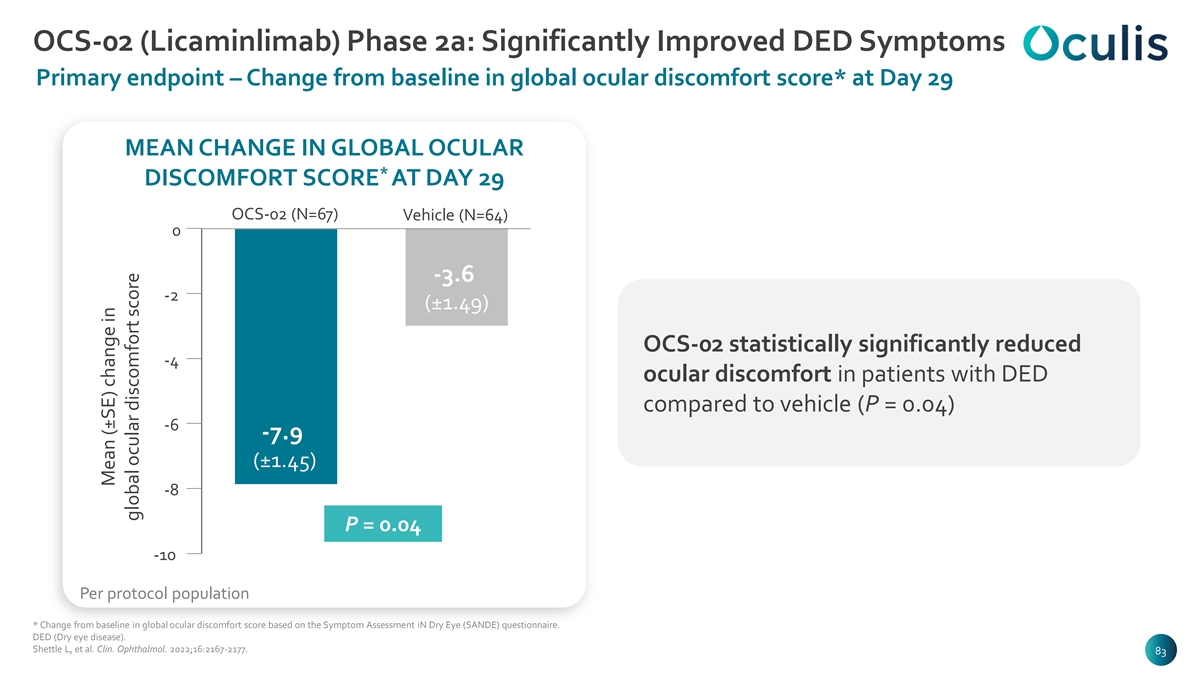
OCS-02 (Licaminlimab) Phase 2a: Significantly Improved DED Symptoms Primary endpoint – Change from baseline in global ocular discomfort score* at Day 29 MEAN CHANGE IN GLOBAL OCULAR * DISCOMFORT SCORE AT DAY 29 OCS-02 (N=67) Vehicle (N=64) 0 -3.6 -2 (±1.49) OCS-02 statistically significantly reduced -4 ocular discomfort in patients with DED compared to vehicle (P = 0.04) -6 -7.9 (±1.45) -8 P = 0.04 -10 Per protocol population * Change from baseline in global ocular discomfort score based on the Symptom Assessment iN Dry Eye (SANDE) questionnaire. DED (Dry eye disease). Shettle L, et al. Clin. Ophthalmol. 2022;16:2167-2177. 83 83 83 83 Mean (±SE) change in global ocular discomfort score
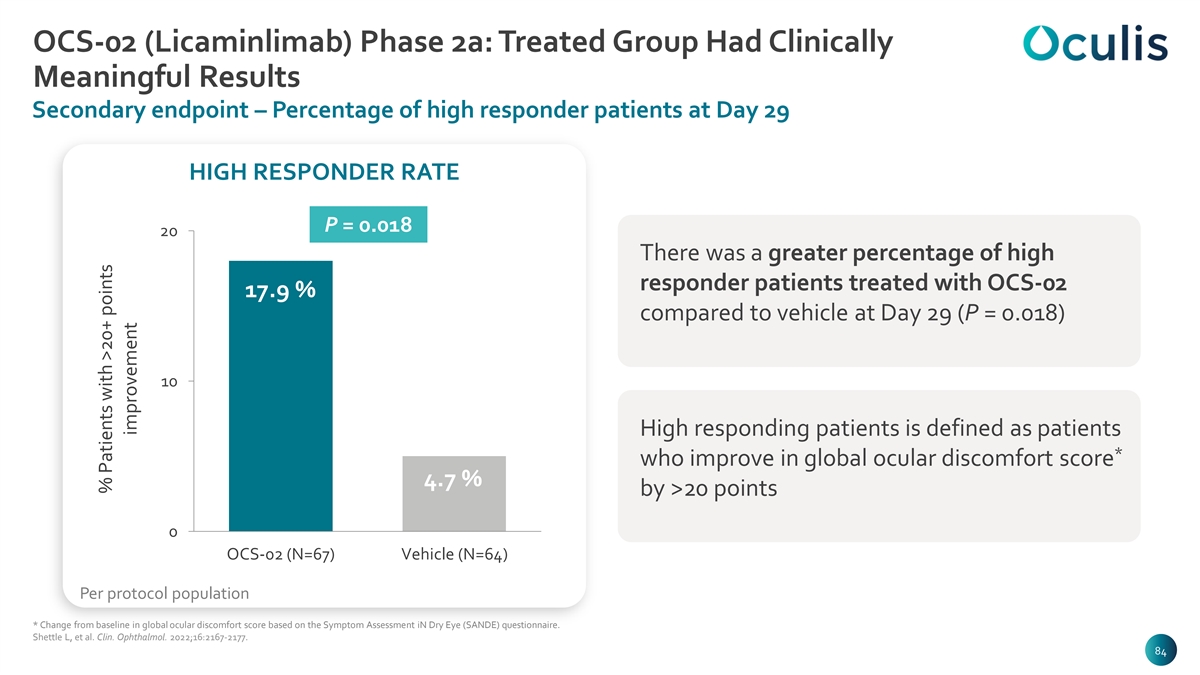
OCS-02 (Licaminlimab) Phase 2a: Treated Group Had Clinically Meaningful Results Secondary endpoint – Percentage of high responder patients at Day 29 HIGH RESPONDER RATE P = 0.018 20 There was a greater percentage of high responder patients treated with OCS-02 17.9 % compared to vehicle at Day 29 (P = 0.018) 10 High responding patients is defined as patients * who improve in global ocular discomfort score 4.7 % by >20 points 0 OCS-02 (N=67) Vehicle (N=64) Per protocol population * Change from baseline in global ocular discomfort score based on the Symptom Assessment iN Dry Eye (SANDE) questionnaire. Shettle L, et al. Clin. Ophthalmol. 2022;16:2167-2177. 84 84 84 84 % Patients with >20+ points improvement
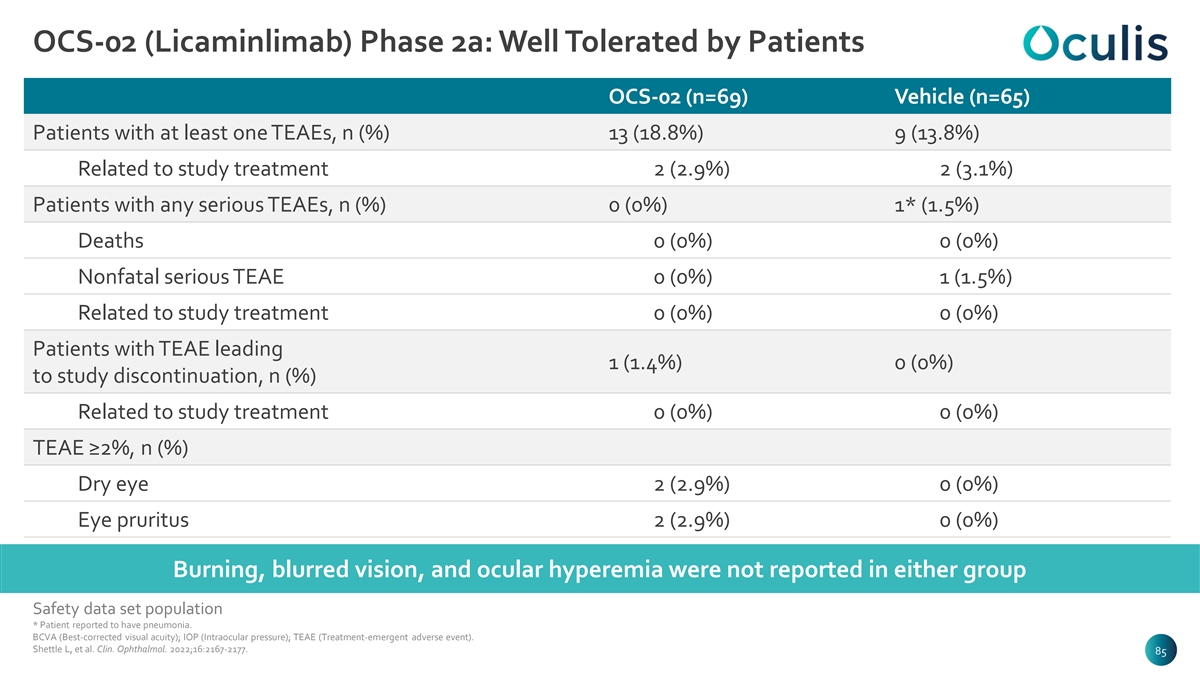
OCS-02 (Licaminlimab) Phase 2a: Well Tolerated by Patients OCS-02 (n=69) Vehicle (n=65) Patients with at least one TEAEs, n (%) 13 (18.8%) 9 (13.8%) Related to study treatment 2 (2.9%) 2 (3.1%) Patients with any serious TEAEs, n (%) 0 (0%) 1* (1.5%) Deaths 0 (0%) 0 (0%) Nonfatal serious TEAE 0 (0%) 1 (1.5%) Related to study treatment 0 (0%) 0 (0%) Patients with TEAE leading 1 (1.4%) 0 (0%) to study discontinuation, n (%) Related to study treatment 0 (0%) 0 (0%) TEAE ≥2%, n (%) Dry eye 2 (2.9%) 0 (0%) Eye pruritus 2 (2.9%) 0 (0%) Burning, blurred vision, and ocular hyperemia were not reported in either group Safety data set population * Patient reported to have pneumonia. BCVA (Best-corrected visual acuity); IOP (Intraocular pressure); TEAE (Treatment-emergent adverse event). Shettle L, et al. Clin. Ophthalmol. 2022;16:2167-2177. 85 85 85 85
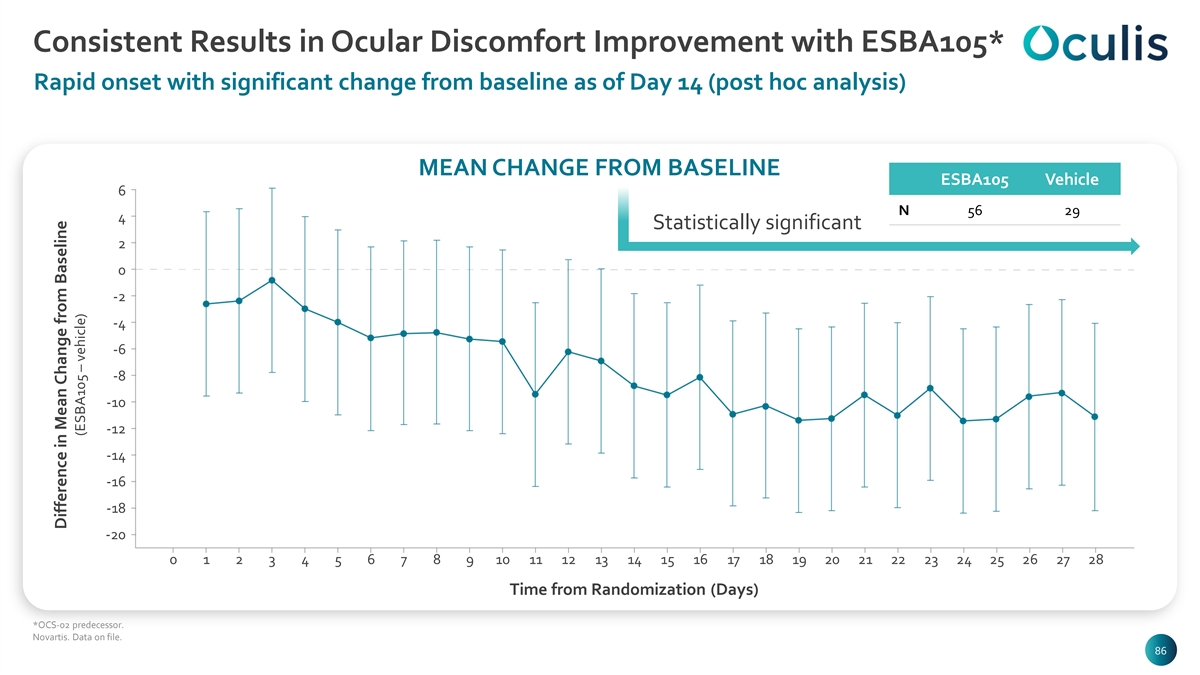
Consistent Results in Ocular Discomfort Improvement with ESBA105* Rapid onset with significant change from baseline as of Day 14 (post hoc analysis) MEAN CHANGE FROM BASELINE ESBA105 Vehicle 6 N 56 29 4 Statistically significant 2 0 -2 -4 -6 -8 -10 -12 -14 -16 -18 -20 0 1 2 3 4 5 6 7 8 9 10 11 12 13 14 15 16 17 18 19 20 21 22 23 24 25 26 27 28 Time from Randomization (Days) *OCS-02 predecessor. Novartis. Data on file. 86 86 86 86 86 86 Difference in Mean Change from Baseline (ESBA105 – vehicle)
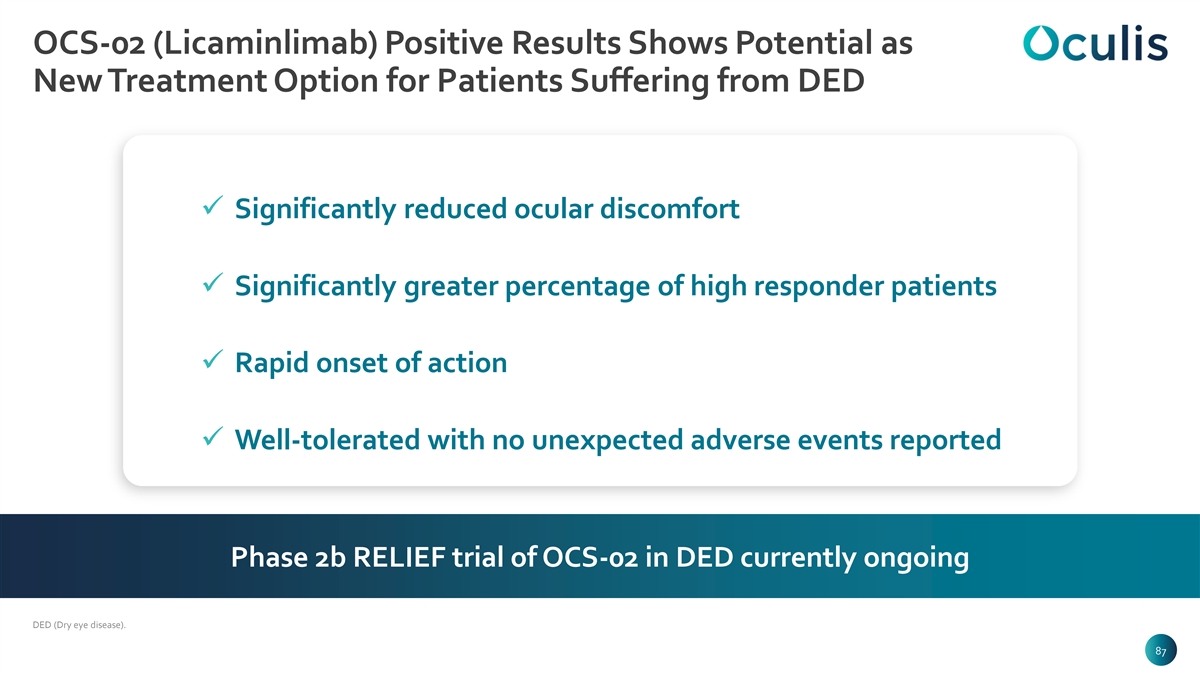
OCS-02 (Licaminlimab) Positive Results Shows Potential as New Treatment Option for Patients Suffering from DED ✓ Significantly reduced ocular discomfort ✓ Significantly greater percentage of high responder patients ✓ Rapid onset of action ✓ Well-tolerated with no unexpected adverse events reported Phase 2b RELIEF trial of OCS-02 in DED currently ongoing DED (Dry eye disease). 87 87 87 87
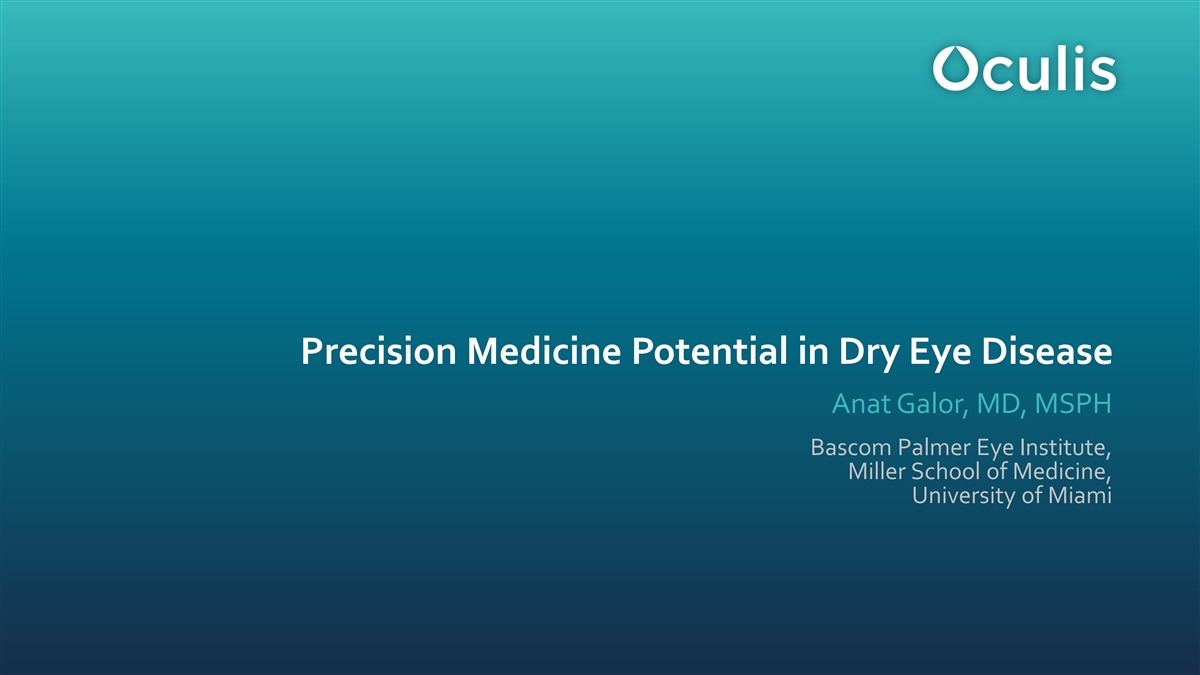
Precision Medicine Potential in Dry Eye Disease Anat Galor, MD, MSPH Bascom Palmer Eye Institute, Miller School of Medicine, University of Miami 88 88
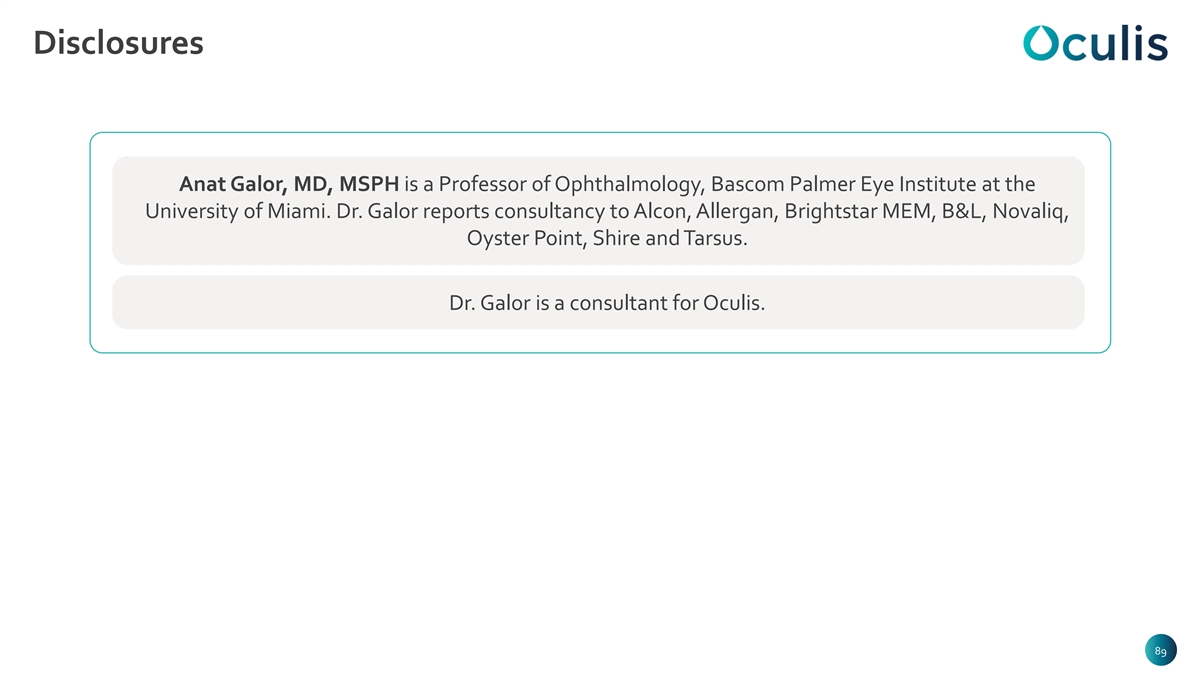
Disclosures Anat Galor, MD, MSPH is a Professor of Ophthalmology, Bascom Palmer Eye Institute at the University of Miami. Dr. Galor reports consultancy to Alcon, Allergan, Brightstar MEM, B&L, Novaliq, Oyster Point, Shire and Tarsus. Dr. Galor is a consultant for Oculis. 89 89 89 89
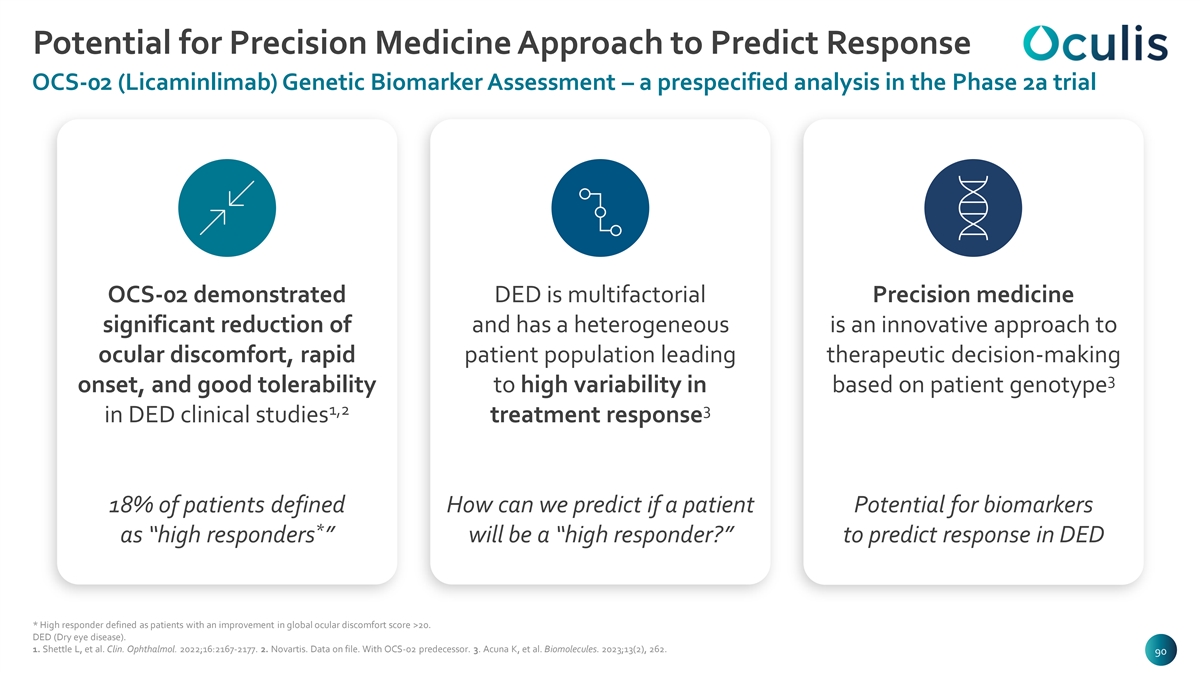
Potential for Precision Medicine Approach to Predict Response OCS-02 (Licaminlimab) Genetic Biomarker Assessment – a prespecified analysis in the Phase 2a trial OCS-02 demonstrated DED is multifactorial Precision medicine significant reduction of and has a heterogeneous is an innovative approach to ocular discomfort, rapid patient population leading therapeutic decision-making 3 onset, and good tolerability to high variability in based on patient genotype 1,2 3 in DED clinical studies treatment response 18% of patients defined How can we predict if a patient Potential for biomarkers * as “high responders ” will be a “high responder?” to predict response in DED * High responder defined as patients with an improvement in global ocular discomfort score >20. DED (Dry eye disease). 1. Shettle L, et al. Clin. Ophthalmol. 2022;16:2167-2177. 2. Novartis. Data on file. With OCS-02 predecessor. 3. Acuna K, et al. Biomolecules. 2023;13(2), 262. 90 90 90 90
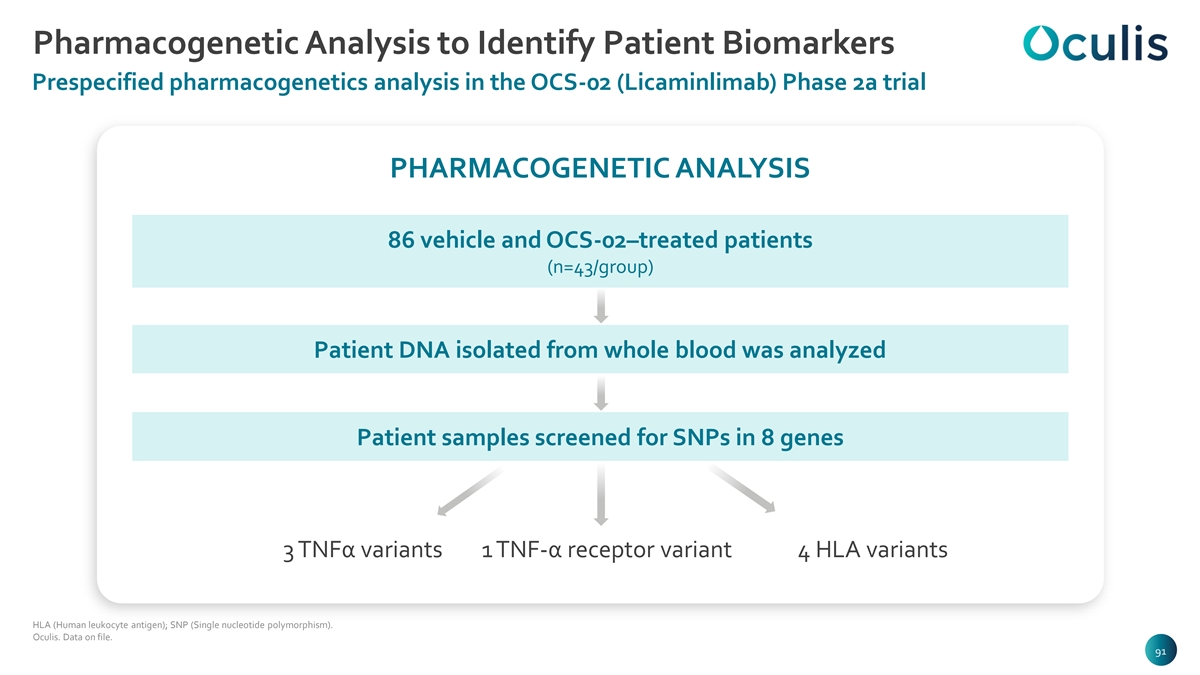
Pharmacogenetic Analysis to Identify Patient Biomarkers Prespecified pharmacogenetics analysis in the OCS-02 (Licaminlimab) Phase 2a trial PHARMACOGENETIC ANALYSIS 86 vehicle and OCS-02–treated patients (n=43/group) Patient DNA isolated from whole blood was analyzed Patient samples screened for SNPs in 8 genes 3 TNFα variants 1 TNF-α receptor variant 4 HLA variants HLA (Human leukocyte antigen); SNP (Single nucleotide polymorphism). Oculis. Data on file. 91 91 91 91
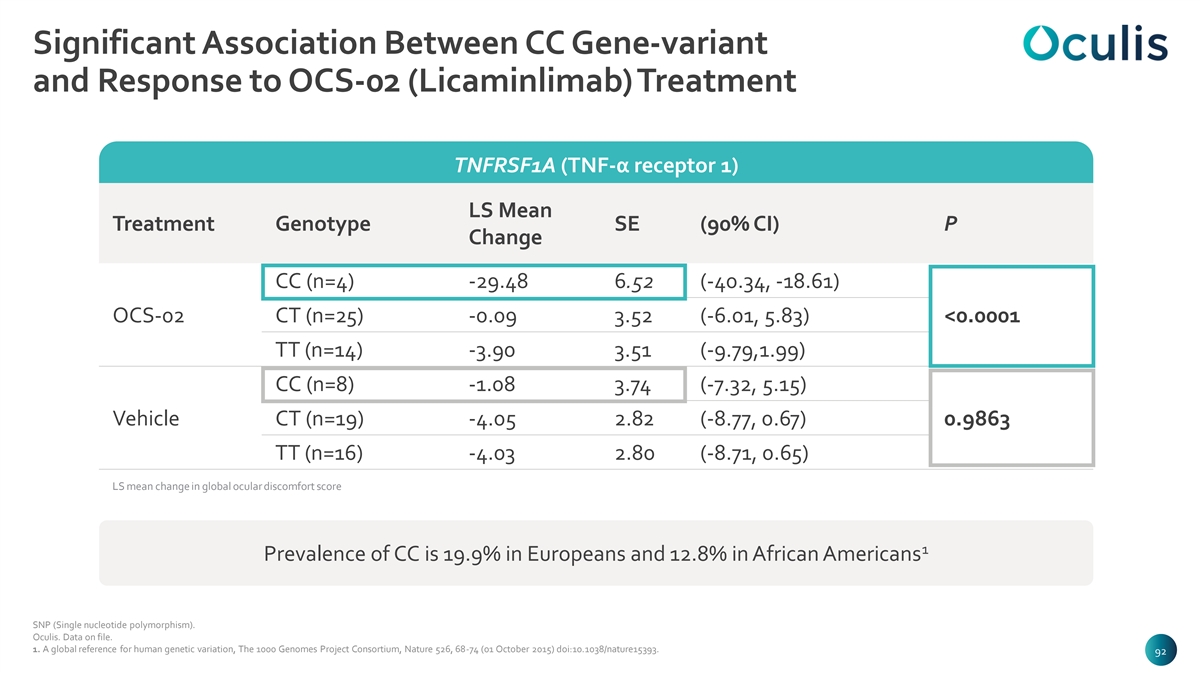
Significant Association Between CC Gene-variant and Response to OCS-02 (Licaminlimab) Treatment TNFRSF1A (TNF-α receptor 1) LS Mean Treatment Genotype SE (90% CI) P Change CC (n=4) -29.48 6.52 (-40.34, -18.61) OCS-02 CT (n=25) -0.09 3.52 (-6.01, 5.83) <0.0001 TT (n=14) -3.90 3.51 (-9.79,1.99) CC (n=8) -1.08 3.74 (-7.32, 5.15) Vehicle CT (n=19) -4.05 2.82 (-8.77, 0.67) 0.9863 TT (n=16) -4.03 2.80 (-8.71, 0.65) LS mean change in global ocular discomfort score 1 Prevalence of CC is 19.9% in Europeans and 12.8% in African Americans SNP (Single nucleotide polymorphism). Oculis. Data on file. 1. A global reference for human genetic variation, The 1000 Genomes Project Consortium, Nature 526, 68-74 (01 October 2015) doi:10.1038/nature15393. 92 92 92 92
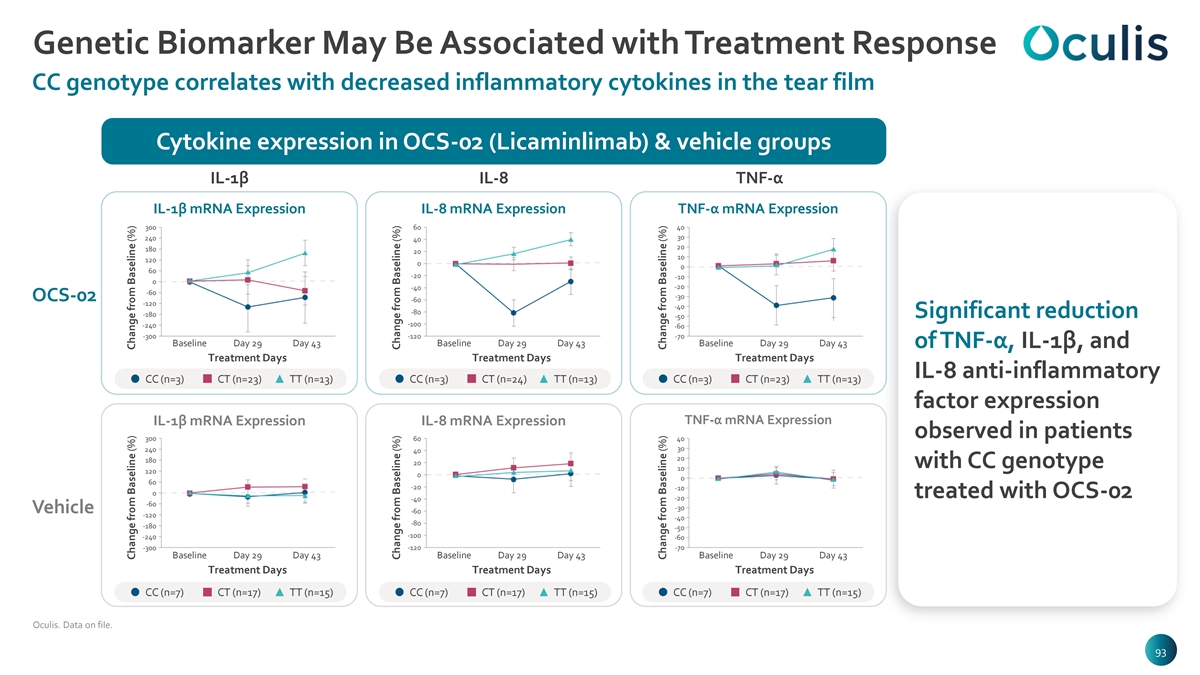
Genetic Biomarker May Be Associated with Treatment Response CC genotype correlates with decreased inflammatory cytokines in the tear film Cytokine expression in OCS-02 (Licaminlimab) & vehicle groups IL-1β IL-8 TNF-α IL-1β mRNA Expression IL-8 mRNA Expression TNF-α mRNA Expression 300 60 40 30 240 40 20 180 20 10 120 0 0 60 -20 -10 0 -20 -40 -60 -30 OCS-02 -60 -120 -40 -80 -180 -50 Significant reduction -100 -240 -60 -300 -120 -70 Baseline Day 29 Day 43 Baseline Day 29 Day 43 Baseline Day 29 Day 43 of TNF-α, IL-1β, and Treatment Days Treatment Days Treatment Days IL-8 anti-inflammatory CC (n=3) CT (n=23) TT (n=13) CC (n=3) CT (n=24) TT (n=13) CC (n=3) CT (n=23) TT (n=13) factor expression TNF-α mRNA Expression IL-1β mRNA Expression IL-8 mRNA Expression observed in patients 300 60 40 30 240 40 20 180 20 with CC genotype 10 120 0 0 60 -20 -10 0 treated with OCS-02 -20 -40 -60 -30 Vehicle -60 -120 -40 -80 -180 -50 -100 -240 -60 -300 -120 -70 Baseline Day 29 Day 43 Baseline Day 29 Day 43 Baseline Day 29 Day 43 Treatment Days Treatment Days Treatment Days CC (n=7) CT (n=17) TT (n=15) CC (n=7) CT (n=17) TT (n=15) CC (n=7) CT (n=17) TT (n=15) Oculis. Data on file. 93 93 93 93 Change from Baseline (%) Change from Baseline (%) Change from Baseline (%) Change from Baseline (%) Change from Baseline (%) Change from Baseline (%)
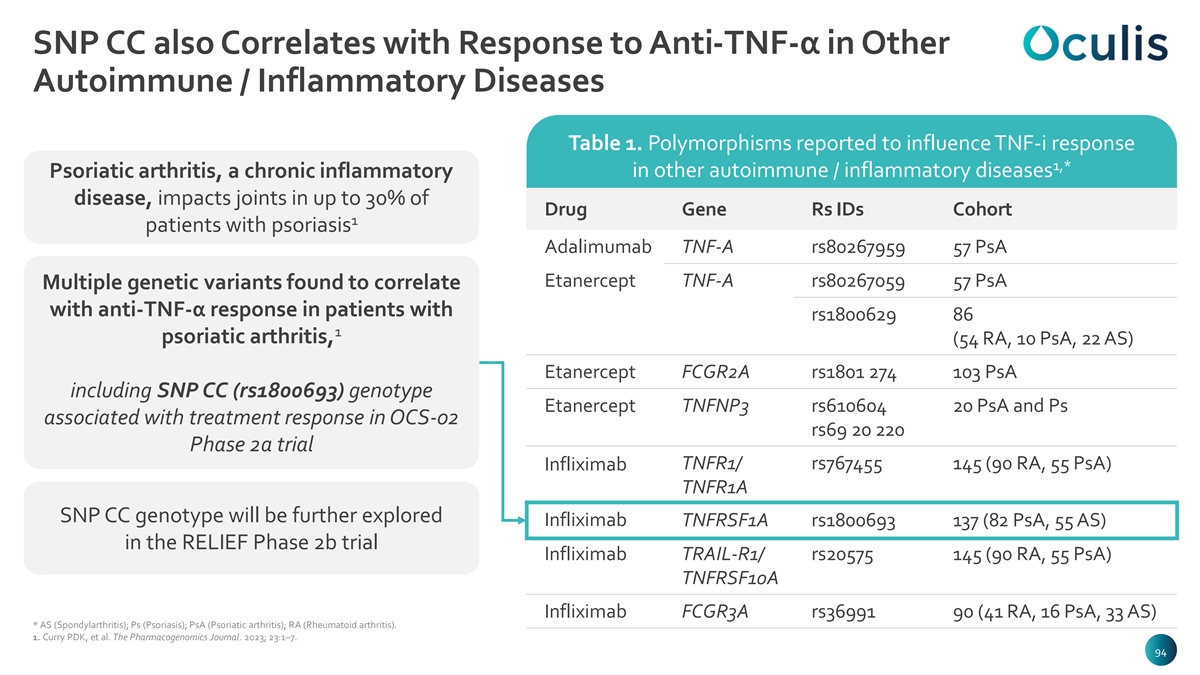
SNP CC also Correlates with Response to Anti-TNF-α in Other Autoimmune / Inflammatory Diseases Table 1. Polymorphisms reported to influence TNF-i response 1,* Psoriatic arthritis, a chronic inflammatory in other autoimmune / inflammatory diseases disease, impacts joints in up to 30% of Drug Gene Rs IDs Cohort 1 patients with psoriasis Adalimumab TNF-A rs80267959 57 PsA Etanercept TNF-A rs80267059 57 PsA Multiple genetic variants found to correlate with anti-TNF-α response in patients with rs1800629 86 1 psoriatic arthritis, (54 RA, 10 PsA, 22 AS) Etanercept FCGR2A rs1801 274 103 PsA including SNP CC (rs1800693) genotype Etanercept TNFNP3 rs610604 20 PsA and Ps associated with treatment response in OCS-02 rs69 20 220 Phase 2a trial TNFR1/ rs767455 145 (90 RA, 55 PsA) Infliximab TNFR1A SNP CC genotype will be further explored Infliximab TNFRSF1A rs1800693 137 (82 PsA, 55 AS) in the RELIEF Phase 2b trial Infliximab TRAIL-R1/ rs20575 145 (90 RA, 55 PsA) TNFRSF10A Infliximab FCGR3A rs36991 90 (41 RA, 16 PsA, 33 AS) * AS (Spondylarthritis); Ps (Psoriasis); PsA (Psoriatic arthritis); RA (Rheumatoid arthritis). 1. Curry PDK, et al. The Pharmacogenomics Journal. 2023; 23:1–7. 94 94 94 94
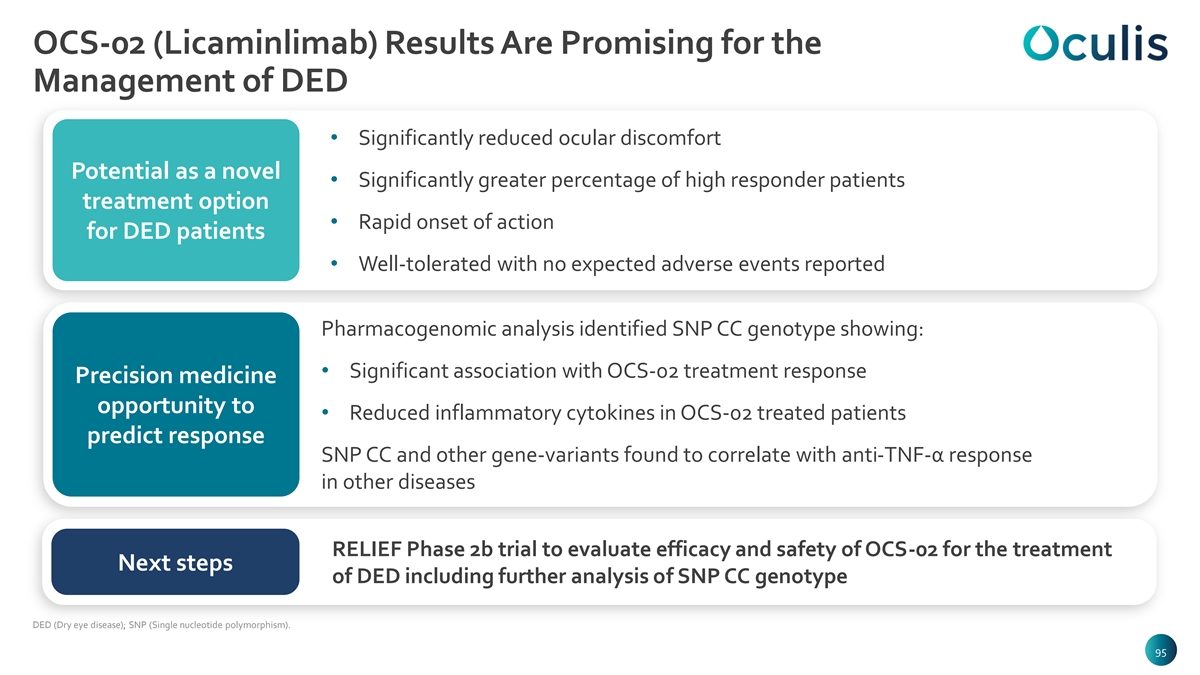
OCS-02 (Licaminlimab) Results Are Promising for the Management of DED • Significantly reduced ocular discomfort Potential as a novel • Significantly greater percentage of high responder patients treatment option • Rapid onset of action for DED patients • Well-tolerated with no expected adverse events reported Pharmacogenomic analysis identified SNP CC genotype showing: • Significant association with OCS-02 treatment response Precision medicine opportunity to • Reduced inflammatory cytokines in OCS-02 treated patients predict response SNP CC and other gene-variants found to correlate with anti-TNF-α response in other diseases RELIEF Phase 2b trial to evaluate efficacy and safety of OCS-02 for the treatment Next steps of DED including further analysis of SNP CC genotype DED (Dry eye disease); SNP (Single nucleotide polymorphism). 95 95 95 95
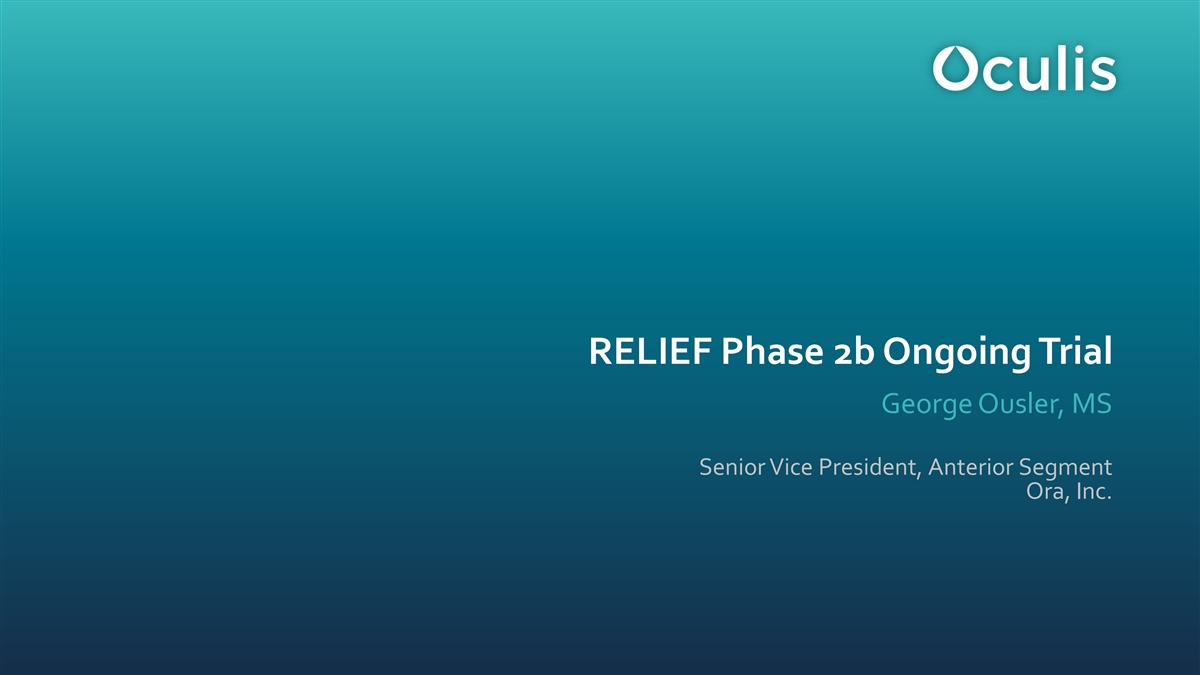
RELIEF Phase 2b Ongoing Trial George Ousler, MS Senior Vice President, Anterior Segment Ora, Inc. 96 96
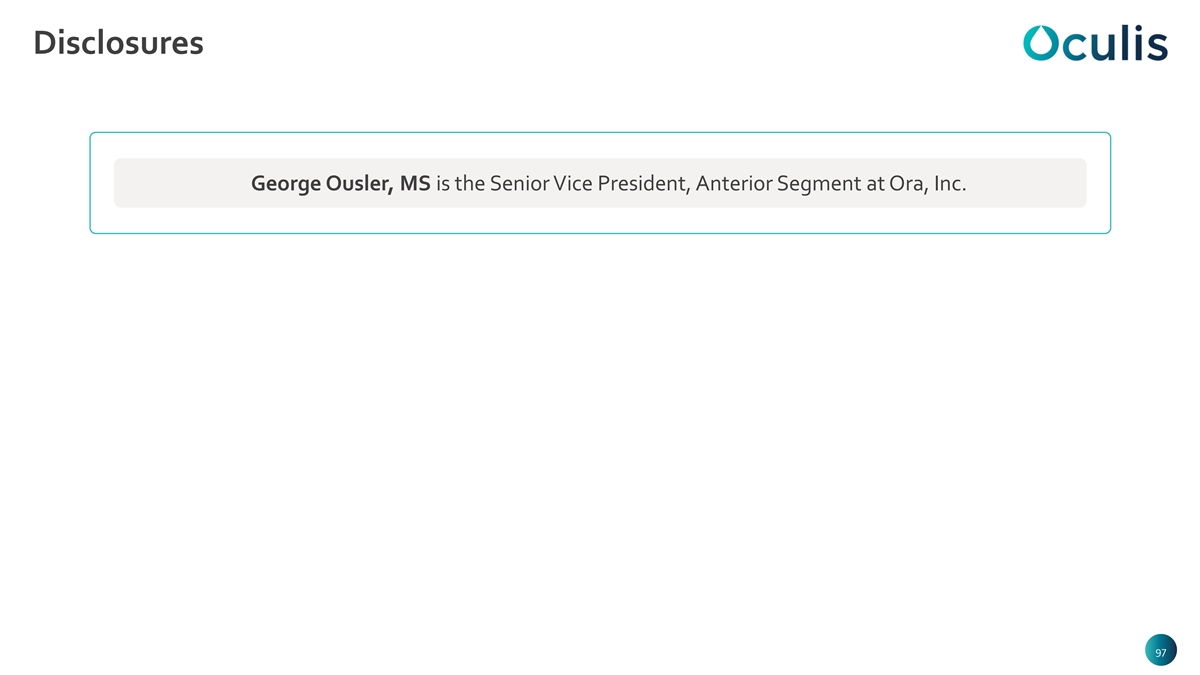
Disclosures George Ousler, MS is the Senior Vice President, Anterior Segment at Ora, Inc. 97 97 97 97
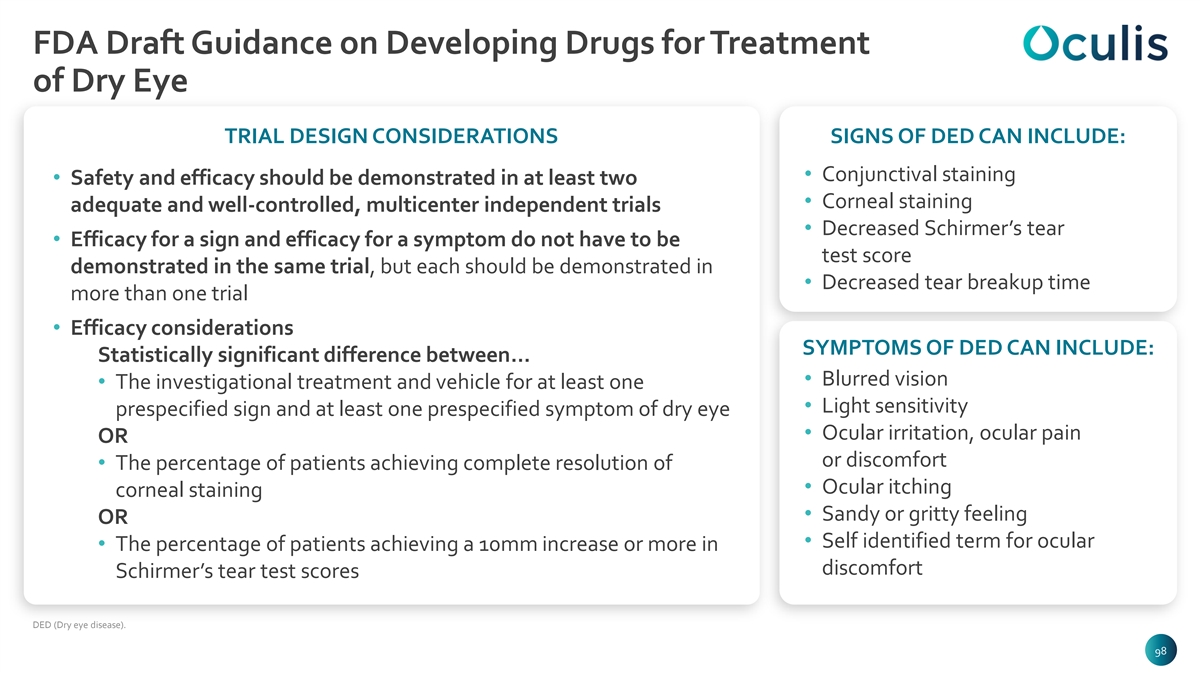
FDA Draft Guidance on Developing Drugs for Treatment of Dry Eye TRIAL DESIGN CONSIDERATIONS SIGNS OF DED CAN INCLUDE: • Conjunctival staining • Safety and efficacy should be demonstrated in at least two • Corneal staining adequate and well-controlled, multicenter independent trials • Decreased Schirmer’s tear • Efficacy for a sign and efficacy for a symptom do not have to be test score demonstrated in the same trial, but each should be demonstrated in • Decreased tear breakup time more than one trial • Efficacy considerations SYMPTOMS OF DED CAN INCLUDE: Statistically significant difference between… • Blurred vision • The investigational treatment and vehicle for at least one • Light sensitivity prespecified sign and at least one prespecified symptom of dry eye • Ocular irritation, ocular pain OR or discomfort • The percentage of patients achieving complete resolution of • Ocular itching corneal staining • Sandy or gritty feeling OR • Self identified term for ocular • The percentage of patients achieving a 10mm increase or more in discomfort Schirmer’s tear test scores DED (Dry eye disease). 98 98 98 98
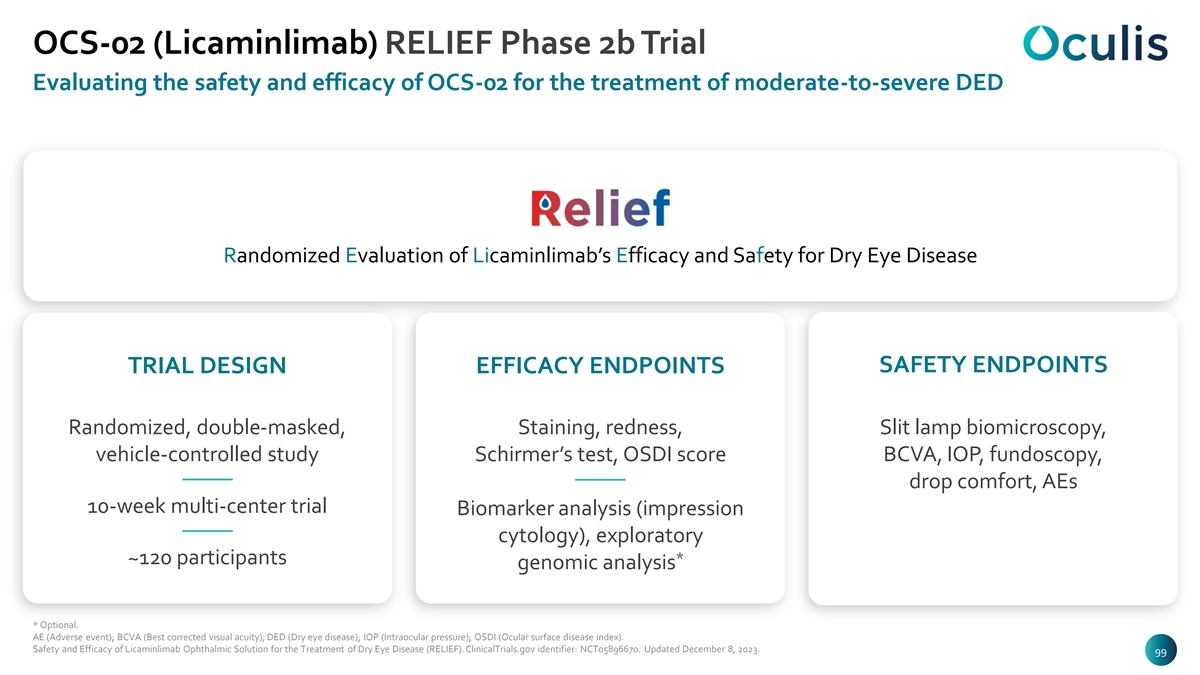
OCS-02 (Licaminlimab) RELIEF Phase 2b Trial Evaluating the safety and efficacy of OCS-02 for the treatment of moderate-to-severe DED Randomized Evaluation of Licaminlimab’s Efficacy and Safety for Dry Eye Disease SAFETY ENDPOINTS TRIAL DESIGN EFFICACY ENDPOINTS Randomized, double-masked, Staining, redness, Slit lamp biomicroscopy, vehicle-controlled study Schirmer’s test, OSDI score BCVA, IOP, fundoscopy, drop comfort, AEs 10-week multi-center trial Biomarker analysis (impression cytology), exploratory * ~120 participants genomic analysis * Optional. AE (Adverse event); BCVA (Best corrected visual acuity); DED (Dry eye disease); IOP (Intraocular pressure); OSDI (Ocular surface disease index). Safety and Efficacy of Licaminlimab Ophthalmic Solution for the Treatment of Dry Eye Disease (RELIEF). ClinicalTrials.gov identifier: NCT05896670. Updated December 8, 2023. 99 99 99 99
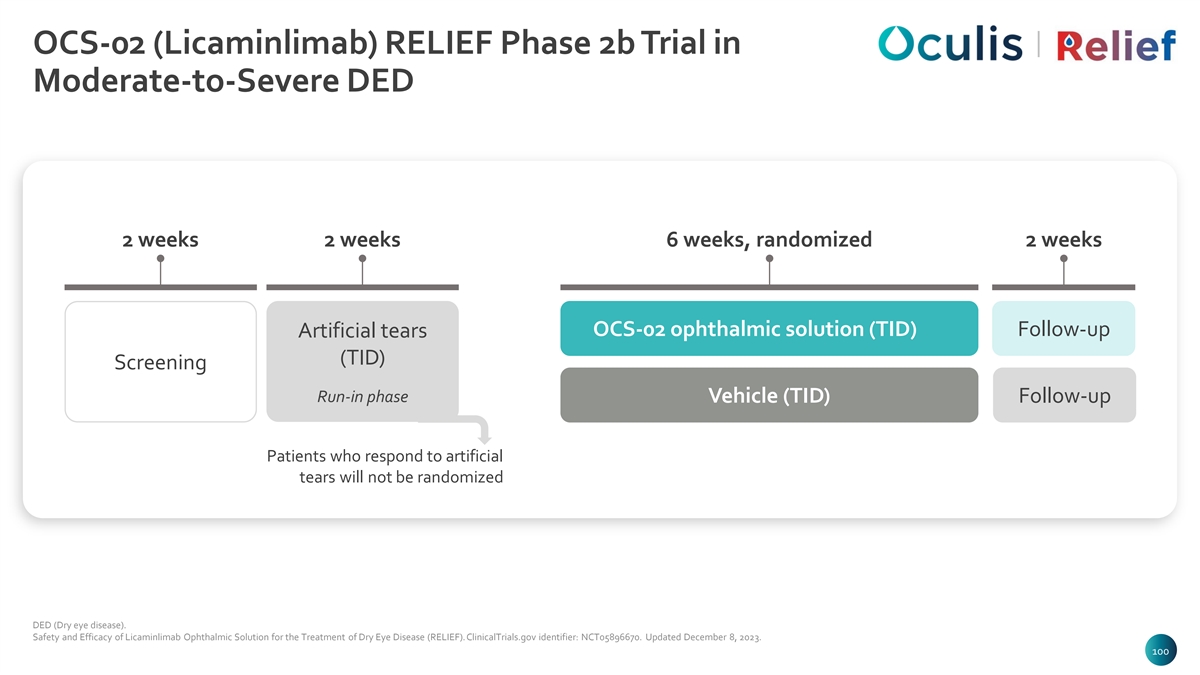
OCS-02 (Licaminlimab) RELIEF Phase 2b Trial in Moderate-to-Severe DED 2 weeks 2 weeks 6 weeks, randomized 2 weeks OCS-02 ophthalmic solution (TID) Follow-up Artificial tears (TID) Screening Run-in phase Vehicle (TID) Follow-up Patients who respond to artificial tears will not be randomized DED (Dry eye disease). Safety and Efficacy of Licaminlimab Ophthalmic Solution for the Treatment of Dry Eye Disease (RELIEF). ClinicalTrials.gov identifier: NCT05896670. Updated December 8, 2023. 10 100 0
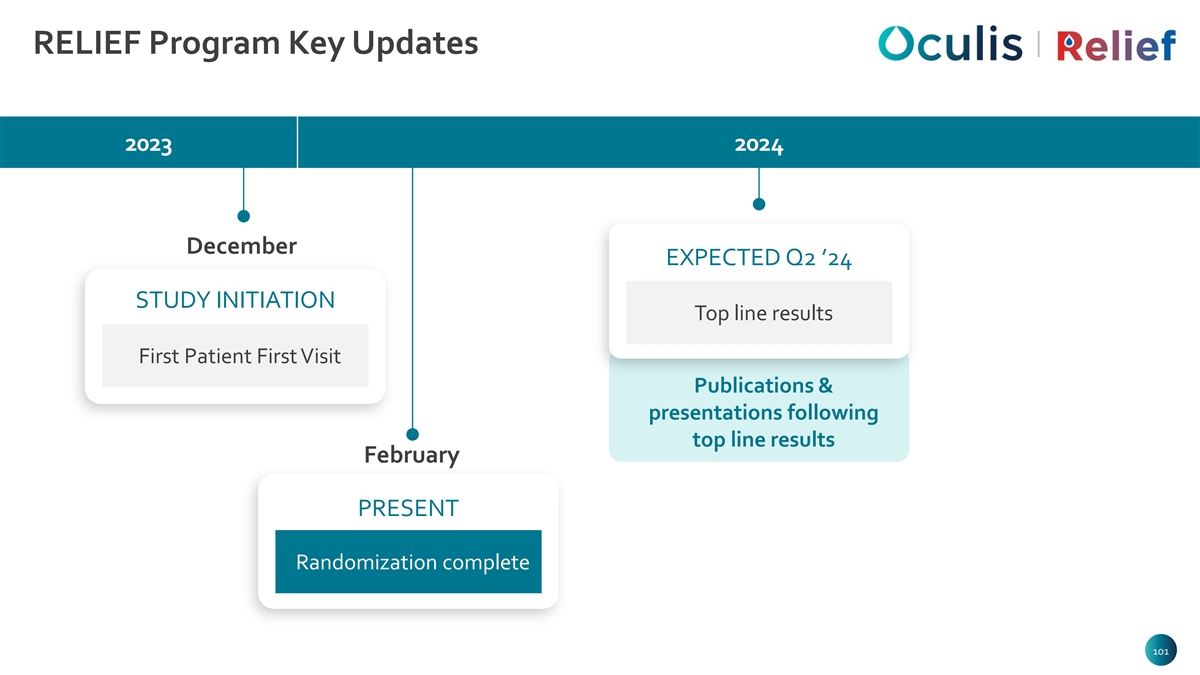
RELIEF Program Key Updates 2023 2024 December EXPECTED Q2 ’24 STUDY INITIATION Top line results First Patient First Visit Publications & presentations following top line results February PRESENT Randomization complete 10 101 1
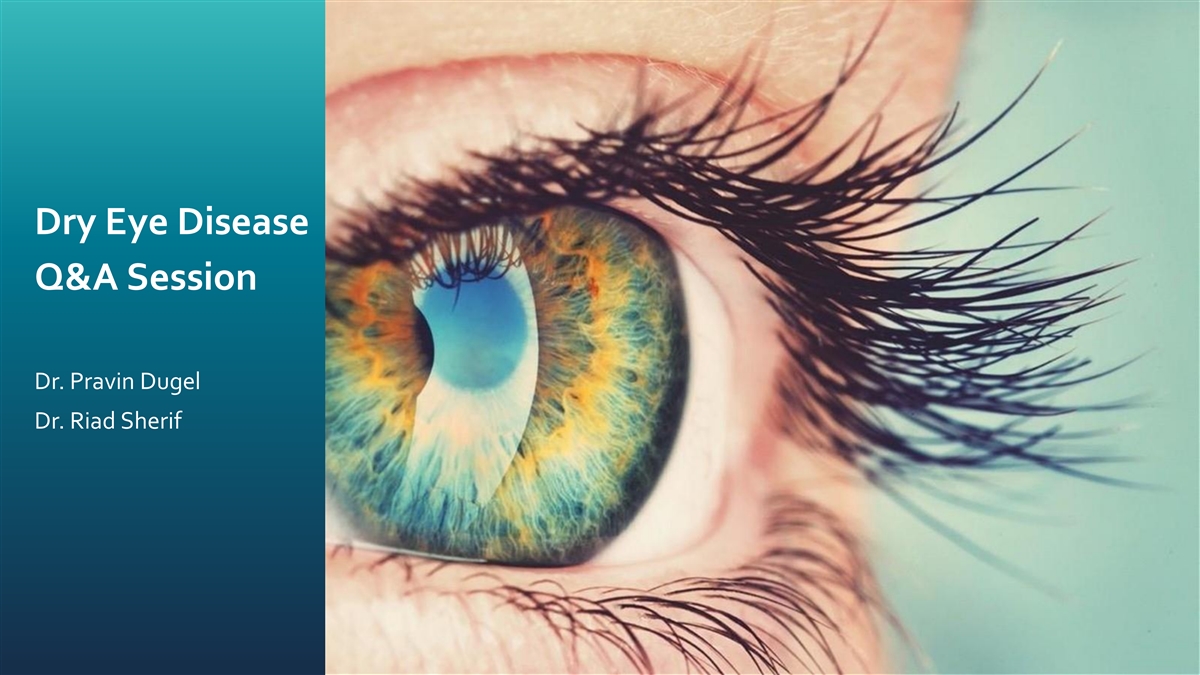
Dry Eye Disease Q&A Session Dr. Pravin Dugel Dr. Riad Sherif
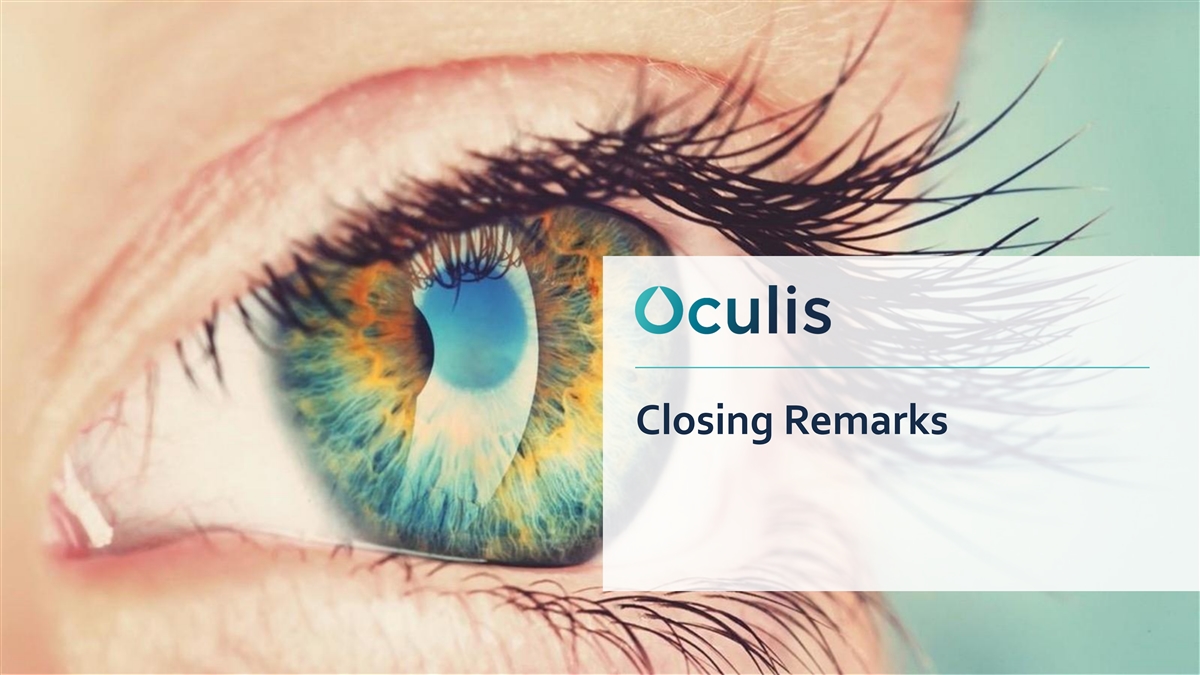
Closing Remarks
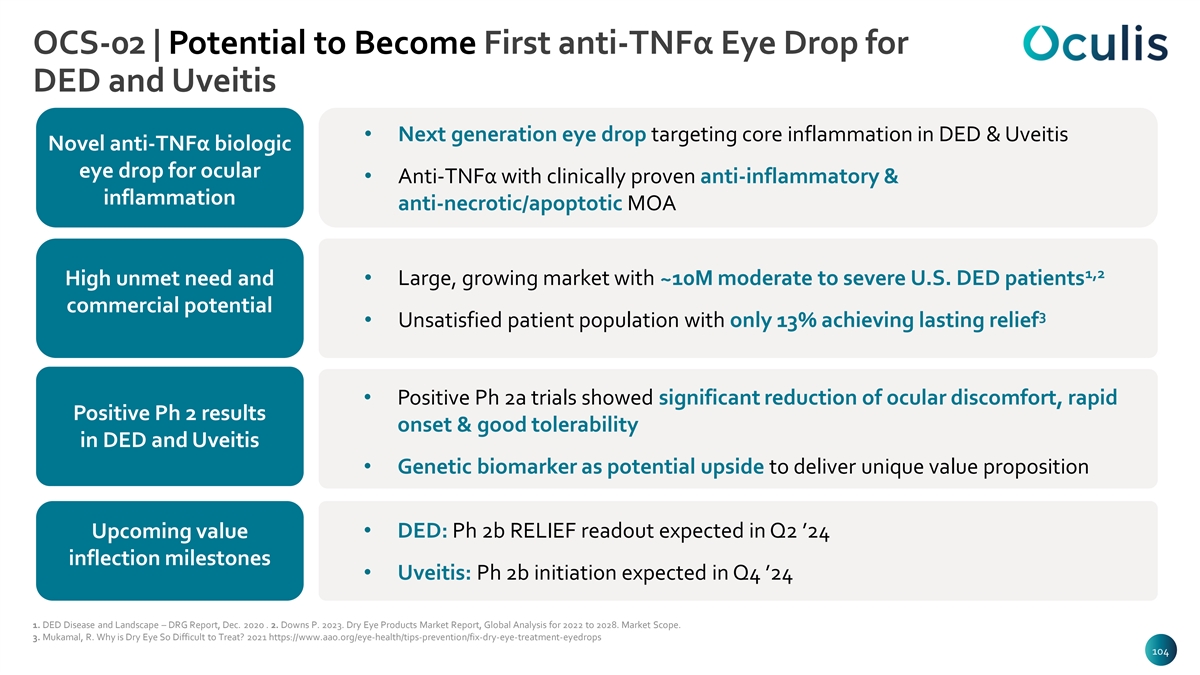
OCS-02 | Potential to Become First anti-TNFα Eye Drop for DED and Uveitis • Next generation eye drop targeting core inflammation in DED & Uveitis Novel anti-TNFα biologic eye drop for ocular • Anti-TNFα with clinically proven anti-inflammatory & inflammation anti-necrotic/apoptotic MOA 1,2 High unmet need and • Large, growing market with ~10M moderate to severe U.S. DED patients commercial potential 3 • Unsatisfied patient population with only 13% achieving lasting relief • Positive Ph 2a trials showed significant reduction of ocular discomfort, rapid Positive Ph 2 results onset & good tolerability in DED and Uveitis • Genetic biomarker as potential upside to deliver unique value proposition • DED: Ph 2b RELIEF readout expected in Q2 ’24 Upcoming value inflection milestones • Uveitis: Ph 2b initiation expected in Q4 ’24 1. DED Disease and Landscape – DRG Report, Dec. 2020 . 2. Downs P. 2023. Dry Eye Products Market Report, Global Analysis for 2022 to 2028. Market Scope. 3. Mukamal, R. Why is Dry Eye So Difficult to Treat? 2021 https://www.aao.org/eye-health/tips-prevention/fix-dry-eye-treatment-eyedrops 10 10 10 104 4 4 4
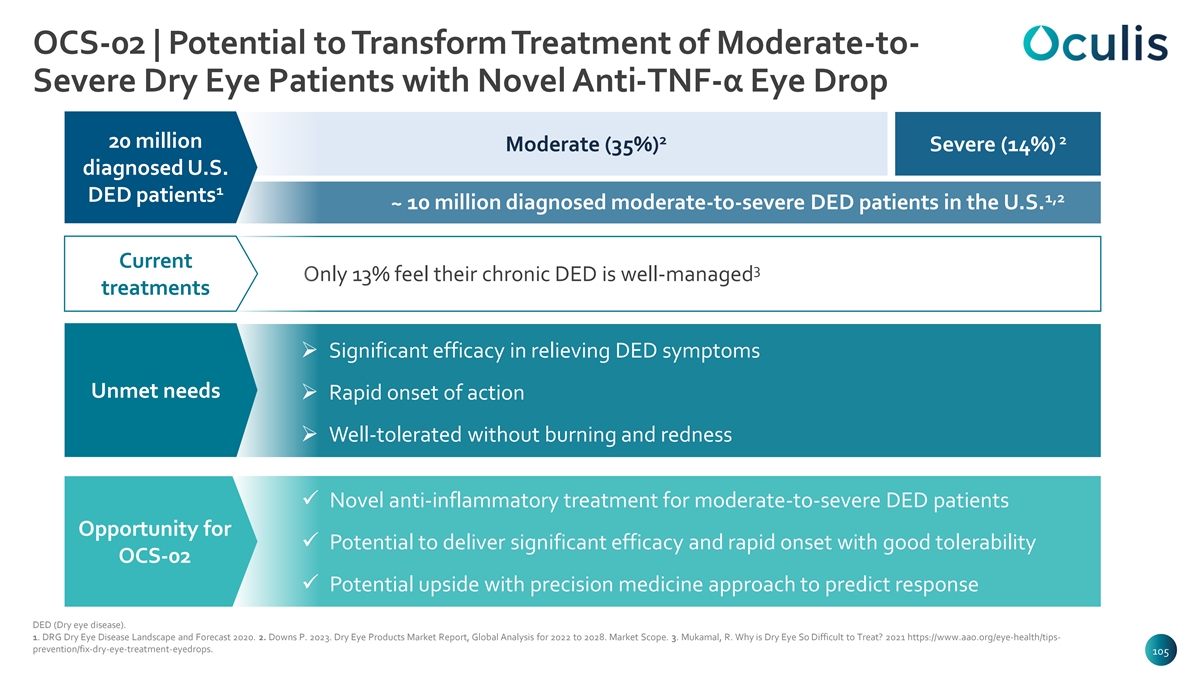
OCS-02 | Potential to Transform Treatment of Moderate-to- Severe Dry Eye Patients with Novel Anti-TNF-α Eye Drop 2 2 20 million Moderate (35%) Severe (14%) diagnosed U.S. 1 DED patients 1,2 ~ 10 million diagnosed moderate-to-severe DED patients in the U.S. Current 3 Only 13% feel their chronic DED is well-managed treatments ➢ Significant efficacy in relieving DED symptoms Unmet needs ➢ Rapid onset of action ➢ Well-tolerated without burning and redness ✓ Novel anti-inflammatory treatment for moderate-to-severe DED patients Opportunity for ✓ Potential to deliver significant efficacy and rapid onset with good tolerability OCS-02 ✓ Potential upside with precision medicine approach to predict response DED (Dry eye disease). 1. DRG Dry Eye Disease Landscape and Forecast 2020. 2. Downs P. 2023. Dry Eye Products Market Report, Global Analysis for 2022 to 2028. Market Scope. 3. Mukamal, R. Why is Dry Eye So Difficult to Treat? 2021 https://www.aao.org/eye-health/tips- 10 10 prevention/fix-dry-eye-treatment-eyedrops. 10 105 5 5 5
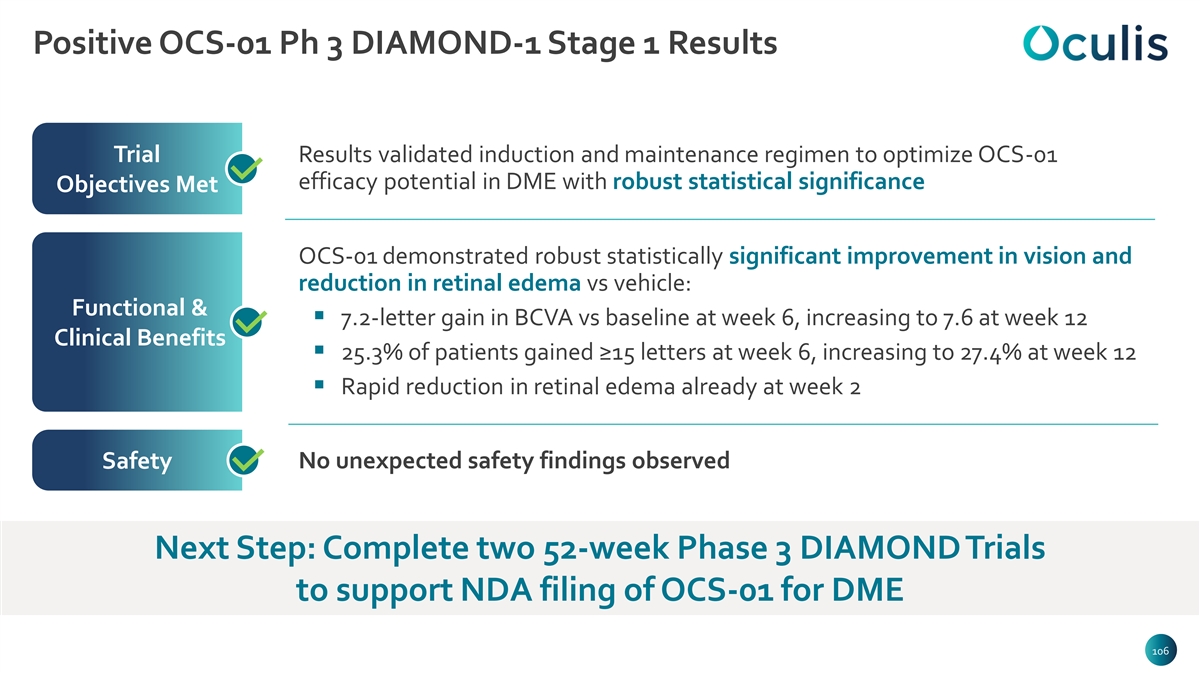
Positive OCS-01 Ph 3 DIAMOND-1 Stage 1 Results Trial Results validated induction and maintenance regimen to optimize OCS-01 efficacy potential in DME with robust statistical significance Objectives Met OCS-01 demonstrated robust statistically significant improvement in vision and reduction in retinal edema vs vehicle: Functional & ▪ 7.2-letter gain in BCVA vs baseline at week 6, increasing to 7.6 at week 12 Clinical Benefits ▪ 25.3% of patients gained ≥15 letters at week 6, increasing to 27.4% at week 12 ▪ Rapid reduction in retinal edema already at week 2 Safety No unexpected safety findings observed Next Step: Complete two 52-week Phase 3 DIAMOND Trials to support NDA filing of OCS-01 for DME 10 10 10 106 6 6 6
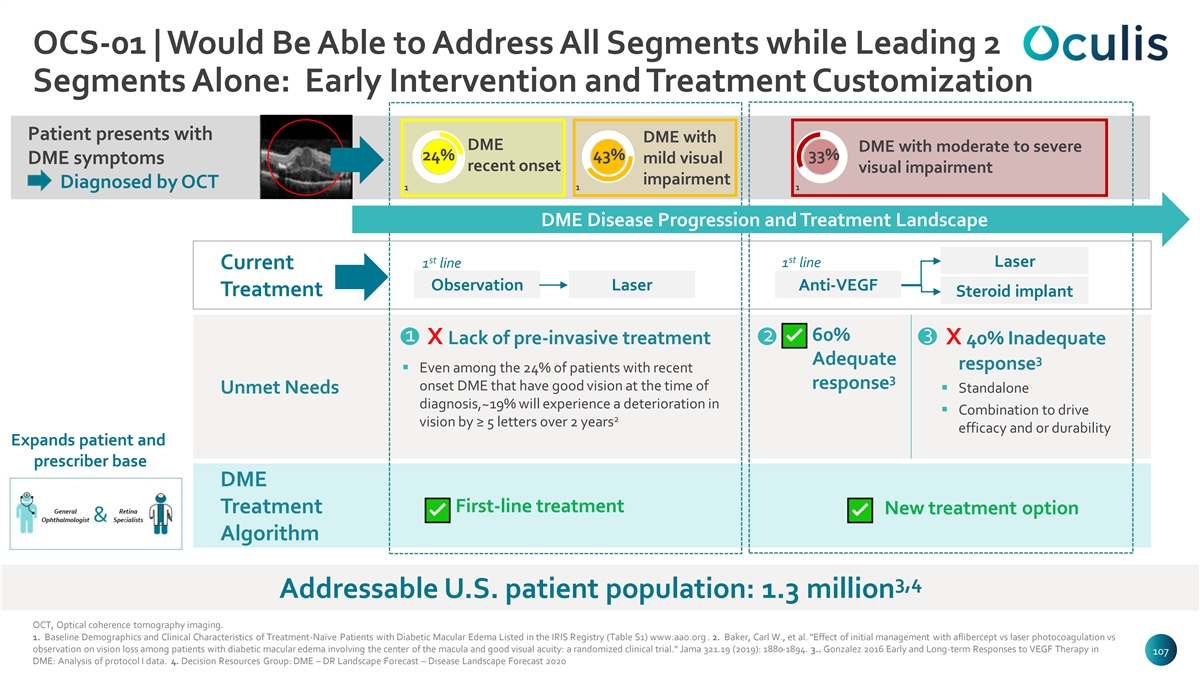
OCS-01 | Would Be Able to Address All Segments while Leading 2 Segments Alone: Early Intervention and Treatment Customization Patient presents with DME with DME DME with moderate to severe 43% 33% 24% DME symptoms mild visual recent onset visual impairment impairment Diagnosed by OCT 1 1 1 DME Disease Progression and Treatment Landscape st st 1 line 1 line Laser Current Observation Laser Anti-VEGF Treatment Steroid implant 3 1 2 60% 1 X Lack of pre-invasive treatment X 40% Inadequate 3 Adequate response ▪ Even among the 24% of patients with recent 3 response onset DME that have good vision at the time of ▪ Standalone Unmet Needs diagnosis,~19% will experience a deterioration in ▪ Combination to drive 2 vision by ≥ 5 letters over 2 years efficacy and or durability Expands patient and prescriber base DME First-line treatment Treatment New treatment option Algorithm 3,4 Addressable U.S. patient population: 1.3 million OCT, Optical coherence tomography imaging. 1. Baseline Demographics and Clinical Characteristics of Treatment-Naïve Patients with Diabetic Macular Edema Listed in the IRIS Registry (Table S1) www.aao.org . 2. Baker, Carl W., et al. Effect of initial management with aflibercept vs laser photocoagulation vs 10 10 observation on vision loss among patients with diabetic macular edema involving the center of the macula and good visual acuity: a randomized clinical trial. Jama 321.19 (2019): 1880-1894. 3.. Gonzalez 2016 Early and Long-term Responses to VEGF Therapy in 10 107 7 7 7 DME: Analysis of protocol I data. 4. Decision Resources Group: DME – DR Landscape Forecast – Disease Landscape Forecast 2020
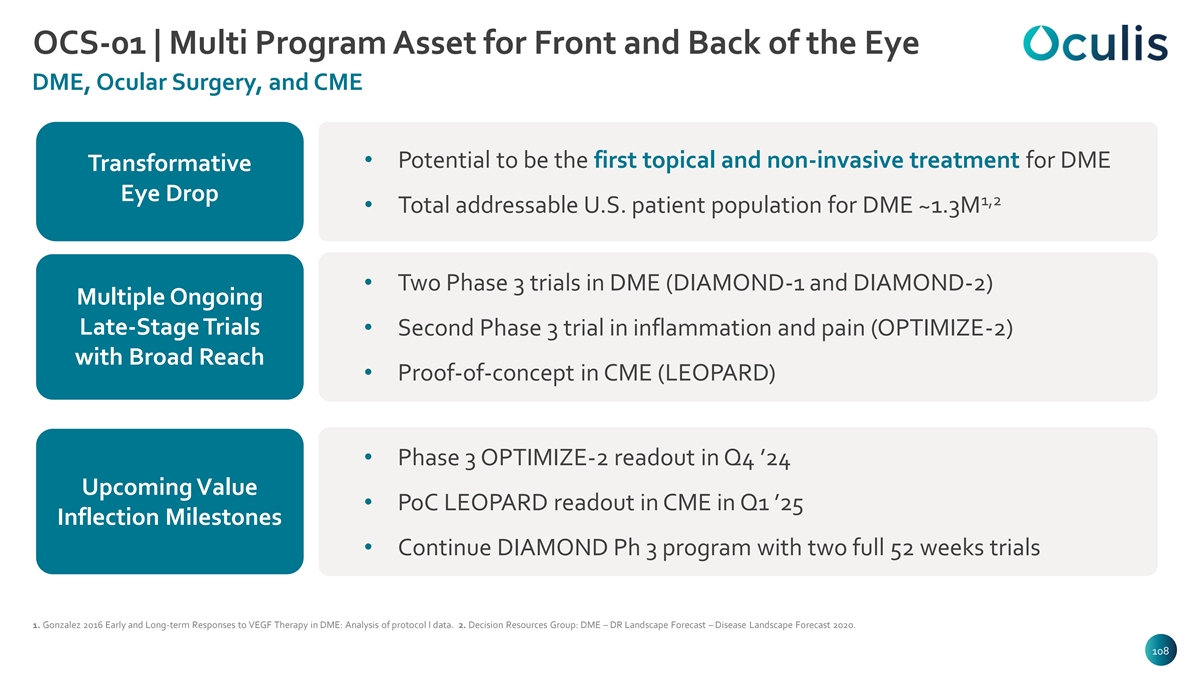
OCS-01 | Multi Program Asset for Front and Back of the Eye DME, Ocular Surgery, and CME • Potential to be the first topical and non-invasive treatment for DME Transformative Eye Drop 1,2 • Total addressable U.S. patient population for DME ~1.3M • Two Phase 3 trials in DME (DIAMOND-1 and DIAMOND-2) Multiple Ongoing Late-Stage Trials • Second Phase 3 trial in inflammation and pain (OPTIMIZE-2) with Broad Reach • Proof-of-concept in CME (LEOPARD) • Phase 3 OPTIMIZE-2 readout in Q4 ’24 Upcoming Value • PoC LEOPARD readout in CME in Q1 ’25 Inflection Milestones • Continue DIAMOND Ph 3 program with two full 52 weeks trials 1. Gonzalez 2016 Early and Long-term Responses to VEGF Therapy in DME: Analysis of protocol I data. 2. Decision Resources Group: DME – DR Landscape Forecast – Disease Landscape Forecast 2020. 10 10 10 108 8 8 8
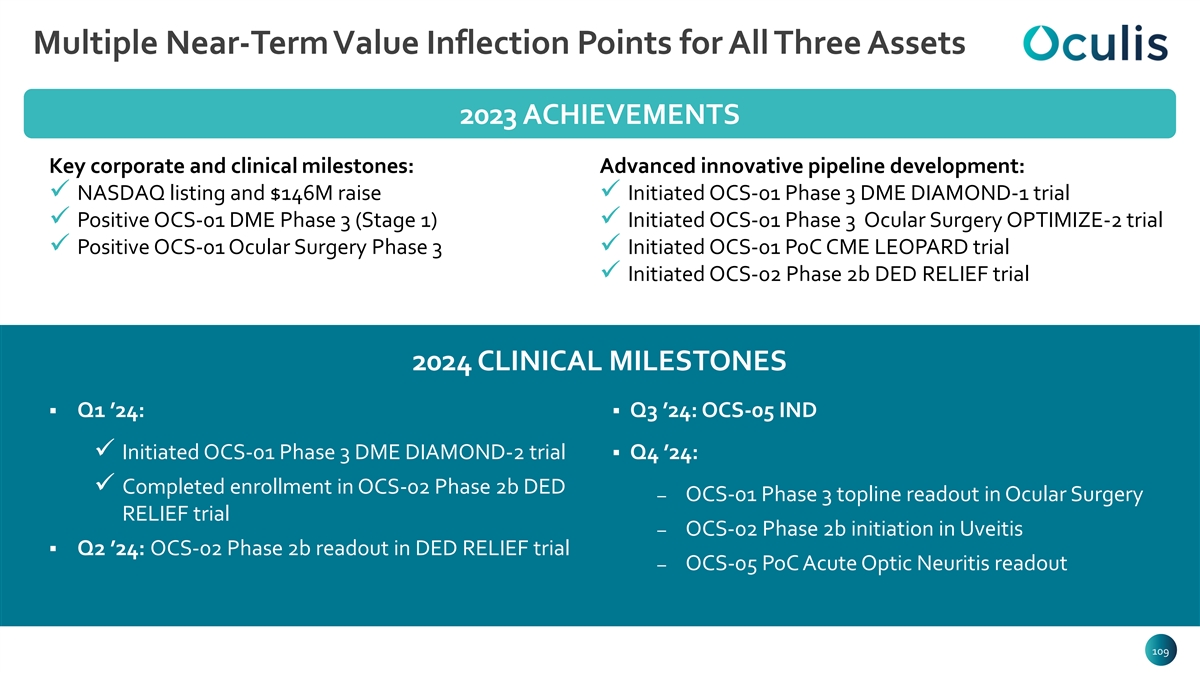
Multiple Near-Term Value Inflection Points for All Three Assets 2023 ACHIEVEMENTS Key corporate and clinical milestones: Advanced innovative pipeline development: ✓ NASDAQ listing and $146M raise✓ Initiated OCS-01 Phase 3 DME DIAMOND-1 trial ✓ Positive OCS-01 DME Phase 3 (Stage 1) ✓ Initiated OCS-01 Phase 3 Ocular Surgery OPTIMIZE-2 trial ✓ Positive OCS-01 Ocular Surgery Phase 3✓ Initiated OCS-01 PoC CME LEOPARD trial ✓ Initiated OCS-02 Phase 2b DED RELIEF trial 2024 CLINICAL MILESTONES ▪ Q1 ’24:▪ Q3 ’24: OCS-05 IND ✓ Initiated OCS-01 Phase 3 DME DIAMOND-2 trial▪ Q4 ’24: ✓ Completed enrollment in OCS-02 Phase 2b DED – OCS-01 Phase 3 topline readout in Ocular Surgery RELIEF trial – OCS-02 Phase 2b initiation in Uveitis ▪ Q2 ’24: OCS-02 Phase 2b readout in DED RELIEF trial – OCS-05 PoC Acute Optic Neuritis readout 10 10 10 109 9 9 9

Thank you
Exhibit 99.2
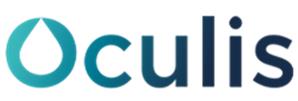
Oculis Provides Updates at R&D Day on Late-Stage Clinical Trials and Announces Key Leadership Appointments
| • | Completed enrollment in Phase 2b RELIEF trial of Licaminlimab (OCS-02), anti-TNF (tumor necrosis factor) alpha eye drops in Dry Eye Disease (DED); topline results expected in Q2 2024 |
| • | Second Phase 3 trial (DIAMOND-2) of OCS-01 eye drops in Diabetic Macular Edema (DME) initiated as planned, in addition to the ongoing DIAMOND-1 Phase 3 trial initiated in late 2023 |
| • | World-renowned retina specialists, Professor Ramin Tadayoni, M.D., Ph.D. appointed as Chief Scientific Officer and Arshad M. Khanani, M.D., M.A., FASRS appointed as Chair of Oculis’ Retina Scientific Advisory Board (SAB) |
| • | Seasoned HR executive, Virginia R. Dean, appointed as Chief Human Resources Officer in Boston |
ZUG, Switzerland, and BOSTON, USA, February 28, 2024 – Oculis Holding AG (Nasdaq: OCS) (“Oculis” or the “Company”), a global biopharmaceutical company purposefully driven to save sight and improve eye care, today provides updates at its in-person and virtual R&D Day on continued progress in advancing its late-stage clinical trials and strengthening the organization with additional senior appointments to its management and advisory teams.
In-person and virtual R&D Day today from 9:00 AM to 11:00 AM EST at the InterContinental New York Barclay. For registration, click here.
“2024 promises to be another exciting year for Oculis as we advance our late-stage clinical development programs. We have met two important clinical milestones with the rapid completion of enrollment in the Phase 2b RELIEF trial of OCS-02 in Dry Eye Disease (DED) and the initiation of the second Phase 3 trial of OCS-01 in Diabetic Macular Edema (DME). Additionally, I am very pleased to welcome Ramin and Virginia to the executive team and to continue to work with Arshad, new Chair of the Oculis’ Retina SAB, as we continue to advance our clinical programs and start to prepare for our first potential launch in the U.S. I am certain that the extensive experience each of them brings will be invaluable to Oculis,” said Riad Sherif, M.D., Chief Executive Officer of Oculis. “We look forward to driving this positive momentum in clinical execution of both DIAMOND Phase 3 trials, and in the delivery of clinical milestones this year, including topline results for the Phase 2b RELIEF trial of OCS-02 in DED in Q2 2024.”
Completion of Enrollment in Phase 2b RELIEF trial with Licaminlimab (OCS-02) in DED
The Phase 2b RELIEF study evaluating topical anti-TNFα Licaminlimab (OCS-02) in DED was initiated in late 2023 and enrollment of 120 patients was rapidly completed. DED is a common condition estimated to impact nearly 40 million people in 2023 in the U.S. alone.
Elizabeth Yeu, M.D., Eastern Virginia Medical School, Virginia Eye Consultants, and President of ASCRS commented: “With its dual anti-inflammatory and anti-necrotic mechanisms of action, Licaminlimab eye drops have shown promising results in previous trials including: a significant reduction of ocular discomfort in DED, a rapid onset of action, and a good tolerability profile. Based on how the broader class of systemic TNFα inhibitors have dramatically improved the management of multiple inflammatory diseases in other therapeutic areas, I am eagerly awaiting the completion of the RELIEF trial to learn more about the potential of Licaminlimab eye drops to address the unmet needs of the millions of patients living with DED.”
Initiation of OCS-01 Phase 3 DIAMOND-2 Trial in DME
The first patient first visit was completed in the second 52-week Phase 3 DIAMOND-2 trial evaluating OCS-01 eye drops for the treatment of DME, a leading cause of vision impairment in working-age adults. In Stage 1 of the DIAMOND program, OCS-01 demonstrated robust statistically significant improvement in vision and reduction in retinal edema vs. vehicle, and was well-tolerated with no unexpected safety findings. The visual acuity improvement observed with OCS-01 at 12-week was similar to approved injectables at the same time point. More information about the Stage 1 results can be found here.
Oculis Strengthens its Executive and Scientific Advisory Teams
Oculis also announced today key executive appointments to bolster its leadership and scientific advisory teams. World-renowned retina specialists, Professor Ramin Tadayoni, M.D., Ph.D. was appointed to the role of Chief Scientific Officer (CSO), and Arshad M. Khanani, M.D., M.A., FASRS, was appointed as Chair of Oculis’ Retina Scientific Advisory Board. In addition, Virginia R. Dean, a seasoned human resources executive with significant experience in growing life science companies, was appointed to the role of Chief Human Resources Officer. Dr. Tadayoni, Dr. Khanani and Ms. Dean will play key strategic roles as the Company continues to advance its diversified late-stage pipeline and expands its footprint in the U.S. while it prepares for the potential first commercial launch. Joanne Chang, M.D., Ph.D., has decided to leave the organization for personal reasons and will continue to collaborate with Oculis on special projects.
Ramin Tadayoni, M.D., Ph.D., is a highly distinguished and accomplished retina specialist. He is the current President of EURETINA, the European Society of Retina Specialists and the Retina Department Chairman of Rothschild Foundation Hospital, including the French Myopia Institute. Dr. Tadayoni has been a Principal Investigator in numerous trials and served as an advisor for companies in the ophthalmology space for over two decades on topics spanning across medical, regulatory and market access, including his role as Co-Chair of the Oculis Scientific Advisory Board. Prior to joining Oculis as Chief Scientific Officer, Dr. Tadayoni was a Professor of Ophthalmology at Université Paris Cité, and the Department Chairman at Lariboisière and Saint Louis hospitals in Paris, France.
As a passionate physician and researcher, he has authored more than 140 medical and scientific articles and has made numerous contributions to ophthalmology textbooks and is part of several international diseases’ classifications groups. He has also received numerous awards of distinction including the American Academy of Ophthalmology Achievement Award and the prestigious Jules Gonin Award from the Retina Research Foundation. Dr. Tadayoni received his medical degree and completed his internship at Paris V University. His retina fellowship was completed at Lariboisière University Hospital while simultaneously pursuing his Ph.D. in Science at Paris VII University and the Paris Vision Institute. He received his undergraduate training in medicine at the University of Marseille.
“After being part of Oculis’ journey for the past few years, as Co-Chair of the Scientific Advisory Board, I am thrilled to join the Oculis executive team. As a member of the DIAMOND program Steering Committee and a practicing retina specialist, it has been very exciting to see the positive results in DME with OCS-01 and progress made to date with the initiation of two 52-week Phase 3 trials in DME,” said Ramin Tadayoni, M.D., Ph.D., Chief Scientific Officer of Oculis. “I look forward to contributing to the efforts of this outstanding team to further drive Oculis’ innovative and diversified pipeline, which has the potential to change the treatment paradigm in ophthalmology across multiple indications.”
Arshad M. Khanani, M.D., M.A., FASRS is a world-renowned retina specialist and clinical scientist. He founded the clinical research section at Sierra Eye Associates, and currently serves as its Managing Partner, Director of Clinical Research, and Director of Fellowship. He has been a principal investigator for more than 120 clinical trials and has authored over 100 scientific publications. Additionally, he is a Clinical Associate Professor at the University of Nevada, Reno School of Medicine. Dr. Khanani is an elected member of the Retina Society, Macula Society and has received numerous awards of distinction. He has received the Senior Honor Award from the American Society of Retina Specialists (ASRS) and was also awarded the prestigious ASRS Presidents’ Young Investigator Award in 2021.
Virginia R. Dean is a seasoned human resources (HR) leader with over 25 years of experience as a senior HR executive in both start-ups and well-established biopharmaceutical companies. She brings a breadth of experience in scaling up life science companies at various stages of growth, from pre-clinical to fully commercialized. Prior to joining Oculis, she was the Chief People Officer and Senior Vice President at Axcella Therapeutics where she led a rapid transformation of the organization. Over the course of her career, she has scaled five organizations, private and public, and participated in four acquisitions. Ms. Dean received her M.B.A. from Simmons University and holds a B.A. in anthropology from the University of Vermont. She will be based in Oculis’ office in Boston, Massachusetts.
About Phase 2b RELIEF Trial of OCS-02 In Dry Eye Disease
The Phase 2b RELIEF trial is a multi-center, randomized, double-masked, vehicle-controlled trial evaluating the safety and efficacy of Licaminlimab for the treatment of moderate-to-severe DED (NCT05896670). The trial was designed based upon the positive findings from multiple previous studies in DED demonstrating significantly reduced ocular discomfort with a greater percentage of high responders vs. vehicle and was well tolerated with no unexpected adverse events reported. The 120 enrolled patients have been randomized to either Licaminlimab or vehicle for a 6-week treatment period and a 2-week follow up. The trial also contains an analysis for a subset of patients with a genetic variant that demonstrated an improved treatment response in the previous Phase 2a trial. RELIEF topline results are anticipated in Q2 2024.
About Phase 3 DIAMOND Program of OCS-01 in Diabetic Macular Edema
The DIAMOND-1 (DIAbetic Macular edema patients ON a Drop) and DIAMOND-2 trials are Phase 3, double-masked, randomized, multi-center trials which will evaluate the efficacy and safety of OCS-01 eye drops in patients with DME. Oculis aims to enroll 350-400 patients in each of these pivotal trials that will be randomized 1:1 to receive OCS-01 or vehicle six times daily for the 6-week induction phase and then three times daily through week 52 for the maintenance phase. The primary endpoint is change in best corrected visual acuity early treatment diabetic retinopathy study (BCVA ETDRS) letter score at Week 52. Secondary endpoints include percentage of patients with ≥15-letter gain in BCVA and change in central subfield thickness (CST), both at Week 52. Both trials were initiated upon the positive findings from stage 1 of the DIAMOND program, which was announced in the second quarter of 2023.
About Oculis
Oculis is a global biopharmaceutical company (Nasdaq: OCS) purposefully driven to save sight and improve eye care. Oculis’ highly differentiated pipeline comprises multiple innovative product candidates in development. It includes OCS-01, a topical eye drop candidate for diabetic macular edema (DME) and for the treatment of inflammation and pain following cataract surgery; OCS-02, a topical biologic anti-TNFα eye drop candidate for dry eye disease (DED) and for non-infectious anterior uveitis; and OCS-05, a disease modifying candidate for acute optic neuritis (AON) and other neuro-ophthalmic disorders such as glaucoma, diabetic retinopathy, geographic atrophy, and neurotrophic keratitis. Headquartered in Switzerland and with operations in the U.S., Oculis’ goal is to deliver life-changing treatments to patients worldwide. The company is led by an experienced management team with a successful track record and is supported by leading international healthcare investors.
For more information, please visit: www.oculis.com This press release contains forward-looking statements and information.
Oculis Contacts
Ms. Sylvia Cheung, CFO
sylvia.cheung@oculis.com
Investor & Media Relations
LifeSci Advisors
Corey Davis, Ph.D.
cdavis@lifesciadvisors.com
1-212-915-2577
Cautionary Statement Regarding Forward Looking Statements
For example, statements regarding the potential of Oculis’ innovative and diversified pipeline to change the treatment paradigm in ophthalmology across multiple indications; the potential benefits of OCS-01 and OCS-02, including patient impact and market opportunity; the potential of OCS-01 for the treatment of DME; the potential of Licaminlimab or OCS-02 eye drops to address the unmet needs of the millions of patients living with DED; expected future milestones and catalysts; the initiation, timing, progress and results of Oculis’ clinical trials, including the timing of topline results for the Phase 2b RELIEF trial; Oculis’ research and development programs, regulatory, commercial and business strategy, future development plans, and management; and Oculis’ ability to advance product candidates into, and successfully complete, clinical trials; the potential benefits of Oculis’ senior management and advisory additions; and Oculis’ potential first commercial launch in the U.S., are forward-looking. All forward-looking statements are based on estimates and assumptions that, while considered reasonable by Oculis and its management, are inherently uncertain and are inherently subject to risks, variability and contingencies, many of which are beyond Oculis’ control. These forward-looking statements are provided for illustrative purposes only and are not intended to serve as, and must not be relied on by an investor as, a guarantee, assurance, prediction or definitive statement of a fact or probability. Actual events and circumstances are difficult or impossible to predict and will differ from assumptions. All forward-looking statements are subject to risks, uncertainties and other factors that may cause actual results to differ materially from those that we expected and/or those expressed or implied by such forward-looking statements. Forward-looking statements are subject to numerous conditions, many of which are beyond the control of Oculis, including those set forth in the Risk Factors section of Oculis’ annual report on Form 20-F and any other documents filed with the U.S. Securities and Exchange Commission (the “SEC”). Copies of these documents are available on the SEC’s website, www.sec.gov. Oculis undertakes no obligation to update these statements for revisions or changes after the date of this release, except as required by law.